- Skip to primary navigation
- Skip to main content
- Skip to primary sidebar
- Skip to footer

Costa Rica Travel Information

The Ultimate Guide to Crossing the Border Between Costa Rica and Nicaragua:Penas Blancas Border
January 5, 2022 By Sammi 459 Comments
In this guide, I’ll take you through the entire process of crossing the border from Costa Rica to Nicaragua, Penas Blancas border by foot. You will find everything you need to know about exiting Costa Rica, entering Nicaragua, exiting Nicaragua and entering Costa Rica at the Penas Blancas border.
Costa Rica Nicaragua Penas Blancas Border Crossing Guide
Click on the section to skip to it.
- What You Need (Required documents, taxes, etc.)
- Getting to the Border
Leaving Costa Rica
Entering nicaragua, leaving nicaragua, entering costa rica.
- Safety Tips
What You Need for Crossing the Border Between Costa Rica and Nicaragua
- A valid passport that is not within 6 months of expiring (Nicaragua is strict about this)
- Costa Rica Exit Tax Receipt (if you are leaving Costa Rica)
- You must not have overstayed your tourist visa for either Costa Rica and Nicaragua
- Check if you need a visa to enter Nicaragua. (USA and Canada does not)
- A printed plane ticket out of Costa Rica if you are entering Costa Rica
- Small USD bills. All taxes are paid in USD.
How to get to the Penas Blancas Border Crossing in Costa Rica
- Car – You can drive your car to the border but that is as far as you can go as Costa Rican rental cars are not allowed to cross land borders. In this case, you will need to leave it at the house in the front. The family that lives there will watch it for you for a ~$5 USD a day. Do not leave any valuables inside! You’ll start seeing a huge line of trucks when you get close to the border. Don’t stay in this line. Keep going and you’ll be able to cross the over and park by the Costa Rica exit office.
- Private shuttle or taxi – You can book a private shuttle in Costa Rica to take you to the border. Depending on where you are traveling from, this private transfer (~$180 USD from the Guanacaste beaches). The shuttle will drop you off right at the border which then you will cross on your own by foot.
- Bus – You can take the public bus to the Penas Blancas border from Liberia (5 AM – 6:30 PM every 45 minutes with Grupo Transbasa) or San Jose (3:20 AM – 7 PM every hour with Caribenos), get off and cross the border by foot. You can also take a bus like Ticabus that goes from San Jose to Managua and to the rest of Central America. You will do the border crossing with Ticabus.
- Visa Run – If you are crossing the border purely for a visa run and don’t have your own transportation, check with Native’s Way (Tamarindo) as they offer visa runs (transportation only).
To leave Costa Rica, you first need to pay the exit tax which you can pay at the border directly.
Costa Rica Exit Tax
Costa Rica charges an exit tax for all land crossings. There are buildings right when you enter at the border to pay your exit tax with lots of signs. With the Costa Rica exit office ahead of you, all the exit tax offices are to the right.
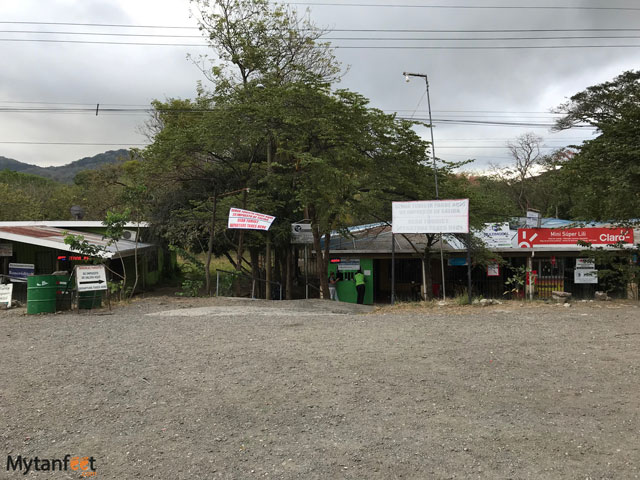
You must pay this exit tax before you exit Costa Rica which can be paid at one of these offices pictured above. They charge a little more for a “convenience fee” so the total will be $10 USD. You can also pay this online on the Banco de Costa Rica website for $8 USD. Print out your receipt and bring it with you.
Costa Rican Exit Office
As you walk towards the border, you’ll see lots of trucks. Costa Rica is the only country who didn’t sign the Central America Marchamo so you will see tons of big rig trucks waiting in line to cross. If you’re driving, you can go around them. Every time I’ve been to the Costa Rican exit office, it’s fairly empty with no line.
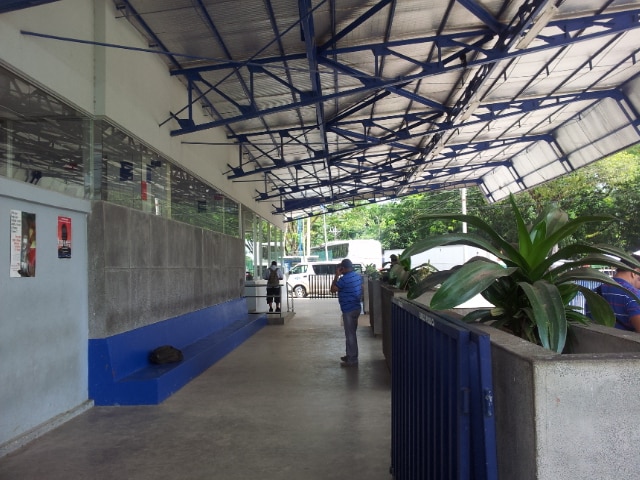
Go inside with your passport and exit tax receipt and hand your passport to the officer who will check it. They didn’t ask me any questions but they asked the lady in front of me where in Costa Rica they were staying before they left.
There is a bathroom outside to the left of the exit office (free).
Now, walk outside and follow the buses and groups of people towards Nicaragua.
After a few hundred meters, you’ll reach the office to enter Nicaragua. You’ll go through one main check point at the border where they will check for your Costa Rican exit stamp. However, any officer can stop you on the road to check your stamp and your negative COVID test result.
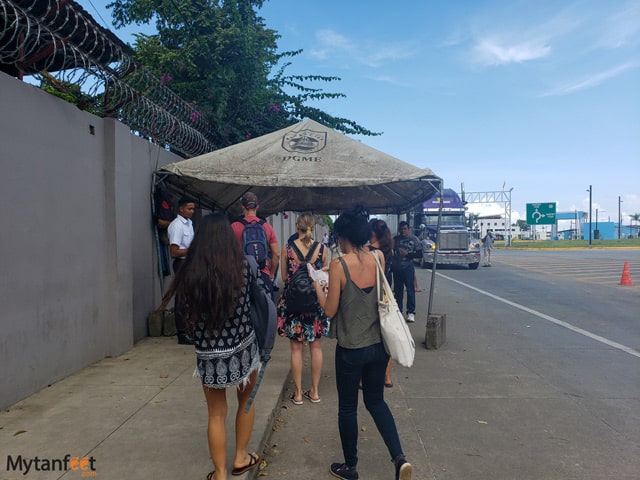
Sometimes the officers will ask questions, sometimes not. They’re pretty friendly in all my experiences and don’t worry if you don’t know Spanish. Just show them your passport if they ask for it.
Nicaragua Entrance Office
Continue after this checkpoint and follow the signs to the Nicaraguan immigration office. You’ll see lots of people selling souvenirs, clothes, food and asking if you need change.
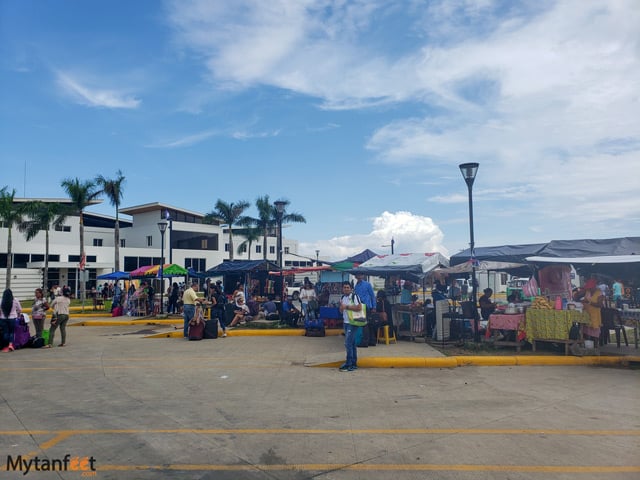
The Nicaragua immigration office is quite new and very nice with air conditioning. When you get inside (look for Entrada), get in line.
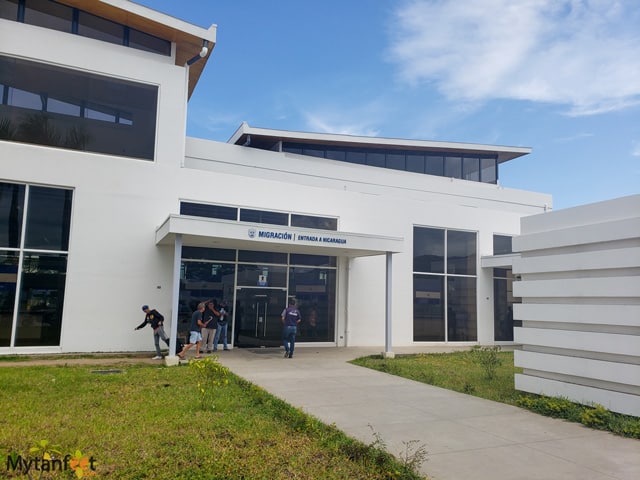
Then, you will get in the entrance line and pay a $12 USD tax to the immigration officer who takes your passport. When he has stamped it, he will write out a large receipt which you can keep. He will normally ask you where you are going in Nicaragua. Let him know the city and if you booked a hotel, tell him the first hotel you’re staying at in Nicaragua. Sometimes the officer doesn’t ask anything at all.
After you’re done, put any luggage or belongings through the luggage scanner for customs. After that, you are now officially in Nicaragua!
There there is a lady who will ask for a $1 USD municipality entrance fee.
If you continue walking outside, there are some restaurants and taxis if you need one. It’s about a thirty minute taxi ride to San Juan del Sur which costs around $30 USD. Also just in case, here is the bus schedule to Rivas and Managua below.

Leaving Nicaragua is about the same process. The exit office is the same office as the entrance, just on the other side.
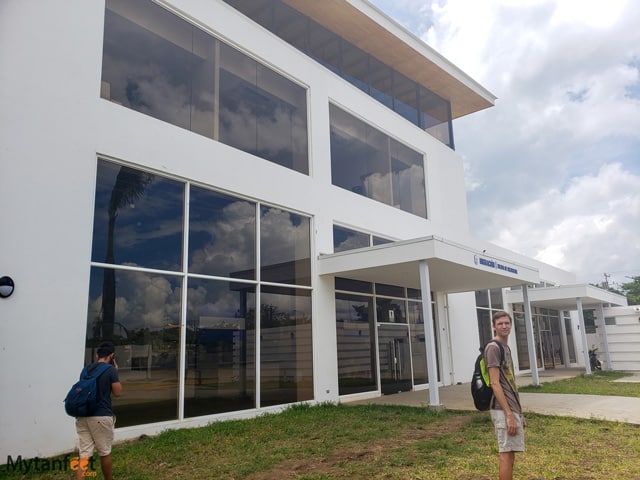
When you get inside, you have to pay another $1 USD municipality tax (to the small booth to the right) and $3 USD to exit to the officer who takes your passport. Put the location as your first hotel/hostel and town in Costa Rica. If you need the bathroom, it is to the left of the immigration office building and costs $1 USD.
After you get your Nicaraguan exit stamp, walk back on the main road towards the Costa Rican side. Like before, you’ll be stopped a couple times by officers to check your passport. Once you reach the Costa Rican side, head to the right side of the building to go through immigration to enter Costa Rica.
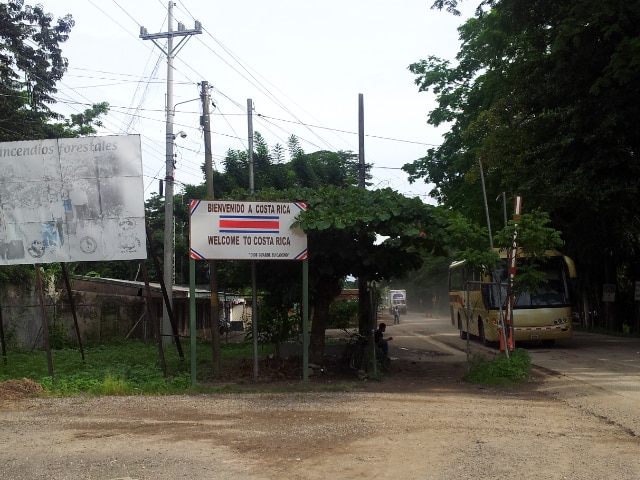
You’ll see a bunch of orange blocks making a line for the entrance. Try to get in line as fast as you can and while you are in line, get all your documents ready to present to the officer.
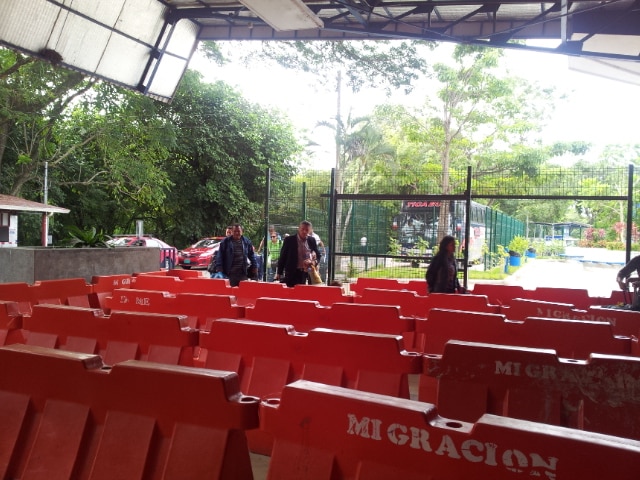
The next part is very important for foreigners when it comes to Costa Rica land entry requirements.
C osta Rica Entry Requirements
You will need to present to the immigration officer your flight out of Costa Rica if you’re a tourist. Tourist visas last 90 days for Group 1 countries and you must show proof you are leaving the country before your visa expires.
*IMPORTANT AS OF SEPTEMBER 2023. Costa Rica has now extended tourist visas for Group 1 countries from 90 days to 180 days. The officer will now probably ask you for a ticket out of 180 days. Group 1 countries are USA, Canada, UK, Australia, Germany, Chile… if you are not sure what group your passport is, please check with the Costa Rican embassy/consulate in your passport country.*
Proof of Onward Travel Out of Costa Rica
To emphasis this point, every foreigner must present a return flight ticket home or a ticket out of Costa Rica. Costa Rica is fairly strict about this in all of my experiences. Of all the times I have crossed the border, I’ve been asked for my flight out every single time.
There is a possibility that you can use a bus ticket, instead of a flight. However, this is not guaranteed to be accepted. I’ve known people who were denied entry with a bus ticket and the officer made them purchase a flight. So even though sometimes a bus or shuttle ticket may work, it honestly depends on the immigration officer you get. Some are super strict, some are more lenient.
Now with COVID, they are more strict about perpetual tourists (people who “live” in Costa Rica as a tourist and do a border run to renew their tourist visa) so it is best to present a flight itinerary confirmation.
I never want to run into any hassles or problems at the border so I always present a printed confirmed flight ticket. If I’m not actually flying out, I’ll purchase a refundable ticket or many airlines have a 24 hour window where you can cancel without penalty regardless the fare type (like American Airlines). A lot of people use Onward Ticket to rent a ticket.
Getting Your New Costa Rica Stamp
Go up to the window and give the officer your passport first. He will probably ask you where you’re going, your occupation, and how long you are in Costa Rica for. Then when asked, show him your proof out of Costa Rica within 90 days.
Once approved, they will stamp your passport with your tourist stamp and write in how many days your tourist visa is valid for (normally 90).
And there you go! Exit the building, put your luggage or backpack if you have any through the machine and you are good to go! That is the complete guide to crossing the border between Costa Rica and Nicaragua at Penas Blancas.
Peñas Blancas Border Crossing Fees
To sum up, here are all the fees you need to pay when you are crossing the border between Costa Rica and Nicaragua. These prices are quoted in USD so pay in dollars but bring small bills because most of the time, they will not have any change.
Please note that Costa Rican currency is not accepted in Nicaragua and Nicaraguan currency is not accepted in Costa Rica. USD works in both countries and since prices are quoted in USD, pay in USD. Small bills only!
- $8 or 10 Costa Rica exit tax (price depends on where you pay for it)
- $12 Nicaragua (to the entrance immigration official)
- $1 Nicaragua entrance municipality tax
- $1 Nicaragua exit municipality tax (in the small booth of the exit office)
- $3 Nicaragua exit tax (to the exit immigration official)
Safety Tips for Crossing the Penas Blancas Border
I’ve heard about some people having trouble or being scared at the border but luckily I, a Asian-American female have never had a major problem and I have crossed alone and with other people. However, there are always people who will target tourists and try to scam you. Here are our tips and things to watch out for.
Do not accept any offers from people trying to help you
These people will pretend to help you for free and then try to charge you something ridiculous when you’ve crossed over. They are persistent and will follow you too.
Also do not accept any offers from someone claiming they can do the border crossing for you. It’s tempting but never let anyone walk away with your passport. Never. You don’t know what condition it will be when it comes back or what they did with it meanwhile.
If you have questions or are lost, ask the Costa Rican immigration officers or the police.
If you’re a solo traveler, look for other travelers and talk to them to see if you can cross together. You may need to write down some Spanish phrases because not all the officers speak English, especially on the Nicaraguan side. Check our Costa Rican Spanish guide for travelers to learn them.
No more custom forms
Some people might try to sell you these so walk away and find an immigration officer. I stopped a woman once who was about to pay $20 for a form! That is one of the common Costa Rica tourist scams .
Bring small USD bills
The immigration officers usually do not give change so make sure you pay in small bills for the taxes and fees. ($1 and $5). Never pull out a huge wad of cash either.
Do not leave your passport hanging out of your backpack or leave any belongings unattended
You do need to show it several times when crossing to the officers, but always put it away in a safe secure spot each time.
If you’re a solo traveler, try to find another group of travelers to join
Usually officers will bother you less if you’re in a group. If you go by yourself, they tend to bother the solo travelers more.
What to do if you overstay your visa
If you overstay, your passport will be marked and you will need to talk to your country’s embassy to figure out what to do. Usually if this is a one time occurrence and the overstayed time wasn’t very long, they can help you sort things out and it’s not a big deal.
However, if you overstay for a long time or multiple times, don’t think you will go undiscovered. Immigration will probably find out at some point, especially as they’re trying to crack down more on perpetual tourists. Once immigration finds out, you will be kicked out of the country and be denied entry for an undisclosed period of time (depends on your situation). We recommend to contact your country’s embassy/consulate in Costa Rica ASAP.
Do not overstay your visa, Costa Rica and Nicaragua do take this seriously. Nicaragua especially is very strict.
Read more Costa Rica travel tips below!
Driving in Costa Rica : In depth guide with tips and advice for driving in Costa Rica. Includes safety tips, information about how Costa Ricans drive, road sides, and more.
Renting a car in Costa Rica : Tips for renting a car in Costa Rica. What you need to know about car rental insurance, reputable companies, recommendations if you should or shouldn’t rent a car and more. You can also get our Costa Rica car rental discount .
Exclusive deals

Costa Rica to Nicaragua Border Crossing: The Complete Guide (2024)
The Costa Rica to Nicaragua border crossing at Penas Blancas was the longest and most confusing of all the border crossings I’ve completed in South and Central America. That’s why I’m sharing a full guide below!
We crossed the border by foot, and this guide is geared toward other travelers doing the same. Our journey took us from La Fortuna, Costa Rica to San Juan del Sur, Nicaragua in one day. You can also start your journey in Liberia or San Jose, Costa Rica.
In this Costa Rica Nicaragua border crossing guide, I’m including instructions for all of the above. Let’s get to it!
NOTE | I completed this border crossing in 2023, and have updated this post for 2024. I’m doing my best to keep this article updated. If you find this guide helpful, please comment below with any changes or updates! Together, we can help future travelers navigate the Costa Rica Nicaragua border safely.
Check out my other border crossing guides…
Nicaragua to El Salvador Border Crossing Guide
Panama to Costa Rica Border Crossing Guide
El Salvador to Guatemala Border Crossing Guide
Guatemala to Honduras Border Crossing Guide
Honduras to Guatemala Border Crossing Guide
Guatemala to Belize Border Crossing Guide
Belize to Mexico Border Crossing Guide
Ecuador to Colombia Border Crossing Guide
Peru to Ecuador Border Crossing Guide
Sailing the San Blas Islands to Cross From Colombia to Panama (Coming Soon!)
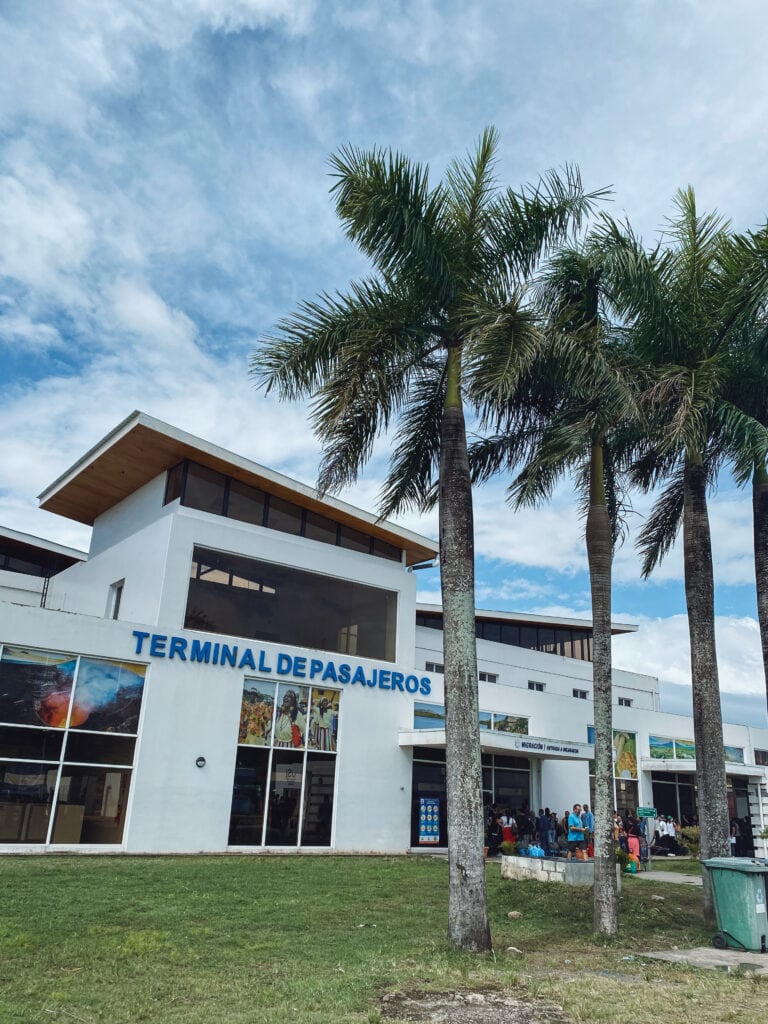
Costa Rica to Nicaragua Border Crossing Locations
Unlike some of the other South and Central American countries we’ve passed through, there is really only one main border crossing between Costa Rica and Nicaragua. It is called Penas Blancas , and it is on the west side of each country.
This is convenient if you’re crossing into Nicaragua, because most of the tourist destinations are on the west / Pacific side.
Costa Rica to Nicaragua Border Crossing: The Complete Guide
Not only is the Penas Blancas border itself more confusing than other ones I’ve come across in the region, but the process of actually getting to the border and then onto your final destination is also confusing.
That’s why I’m sharing ALL the information below on how to get to/from the border from various locations in Costa Rica and Nicaragua. I’ve also written a play-by-play of what to expect at the border itself, because there are a lot of steps at this one.
How the Penas Blancas Border Crossing Works
Here is a very quick overview of what to expect at the Penas Blancas border crossing. Don’t worry, you can scroll further down to read my in-depth account of our experience at this border.
In order to complete the Costa Rica to Nicaragua border crossing at Penas Blancas, you’ll need to follow this route:
- Get to Penas Blancas (more instructions below)
- Pay Costa Rica exit tax
- Exit Costa Rica
- Walk 300m across no man’s land
- Get vaccine card checked twice
- Enter Nicaragua and pay entry tax
- Chicken bus or taxi to onward destination (more instructions below)
Travel Requirements for the Costa Rica to Nicaragua Border
Before you complete this border crossing, you should also be prepared with some important items or details.
These travel requirements include:
- Pre-booked accommodation in Nicaragua: Immigration officials will ask for your address in Nicaragua so it’s good to have at least your first night booked. We stayed at Saltwater Hostel in San Juan del Sur. It had great chilled vibes and was only $10/night for a dorm bed!
- USD cash: There is an exit tax and an entry tax at this border, and it’s required to pay in USD cash. So definitely be sure to have this on hand before you get to the border!
- Six-months passport validity: It’s always recommended to have a minimum of six months of passport validity and at least two empty passport pages before you cross any international border. Some countries turn you away without this.
- Check entry requirements: It’s different for every nationality, so check on your government website. Currently, USA and UK citizens can enter Nicaragua for 90 days. Note that Nicaragua is part of the CA-4 visa agreement , meaning your 90 days are spread across the four member countries (Nicaragua, El Salvador, Honduras, and Guatemala). This is something to consider if you’re backpacking Central America.
- Yellow fever vaccine: You may be required to show a yellow fever vaccination certificate if you’ve traveled in Argentina, Bolivia, Brazil, Colombia, Ecuador, French Guyana, Panama, Venezuela, Paraguay or Peru. However it’s a bit unclear if that’s only for when you enter Nica directly from those countries. We’d recently been in four of those countries but weren’t asked to show our certificates.
- Check health requirements: I’m sure you know that things are constantly changing regarding COVID-19 travel rules and you shouldn’t trust travel blogs regarding this – go to the official embassy website. Currently to enter Nicaragua, we needed to show our vaccination cards. If you’re unvaccinated you need a negative COVID test.
Is Proof of Onward Travel Required?
From our research, proof of onward travel was NOT required to enter Nicaragua. We were not asked for any proof of onward travel at the border.
If you are traveling in the opposite direction, from Nicaragua to Costa Rica, then you WILL need proof of onward travel. There are ways to get this officially, without spending any money. I share more details on onward travel for Costa Rica in this border crossing post .
Where to Begin Your Journey in Costa Rica
Our first major pain point for the Costa Rica to Nicaragua border crossing was figuring out where we needed to begin our journey.
It is easiest to travel from Costa Rica to Nicaragua if you begin your journey in Liberia or San Jose:
From Liberia: Grupo Transbasa bus line has direct routes to the Penas Blancas border every 45 minutes from 5am-6:30pm daily. There is a link to their current schedules on their website.
From San Jose: Ticabus is an international bus line that can take you directly from San Jose, Costa Rica to Managua, Nicaragua. You will get off the bus at the border and then get back on the same bus. You can view schedules and purchase tickets online – although be warned their website is a bit wonky.
However, both Liberia and San Jose are big cities that we weren’t nearby or really desired to spend any time in. We also had no desire to end up all the way in Managua, Nicaragua – which is the least safe city in the country.
What We Did Instead: La Fortuna to Penas Blancas
Personally, we were in La Fortuna , which is a wonderful little town surrounded by hot springs, waterfalls, the Arenal Volcano, and adventure sports. You’ll probably be visiting La Fortuna while in Costa Rica!
Rather than take a terrible and convoluted route from La Fortuna to Liberia (or spend a lot of $$$ on a shuttle), we decided instead to attempt the border crossing directly from La Fortuna. We found ZERO information on this route online, but luckily we got by with the help of some friendly Costa Ricans and probably some luck, too.
Ultimately the journey from La Fortuna to Penas Blancas was not difficult at all – it was just a bit unnerving since we were winging it. I’ve included full directions below so you can complete the same journey with a bit more confidence!
Costa Rica to Nicaragua Border Crossing at Penas Blancas: The Complete Guide
Okay, this is a long and confusing one, folks. But I took notes during our border crossing so I could give you the full details!
Our full journey went a little like this: La Fortuna > El Tanque > Upala > Penas Blancas > Border Crossing > La Virgen > San Juan del Sur.
PHEW! Read on for the full directions.
1. Get to El Tanque from La Fortuna, Costa Rica
A few days before our border crossing, Dan and I lurked around the La Fortuna bus station and spoke to some locals about the best way to attempt this border crossing. With their help, we discovered a route that would take us to Penas Blancas with (hopefully) just two buses.
Our first step was to get from La Fortuna to El Tanque, a very small town just about 15 minutes away by car.
La Fortuna to El Tanque by Bus
It is possible to take the public bus from La Fortuna to El Tanque (but I don’t recommend it – read on). The bus leaves at 6:30am, but it’s recommended to get to the bus station for 6:15am. It costs 750 CRC (~$1.25 USD) and takes 15 minutes.
HOWEVER! The day Dan and I crossed the border, we waited around at the bus station and 6:30am came and went. The bus was late! We started getting anxious because we were told we needed to be in El Tanque by 7am-7:20am to catch our next bus. If we missed that bus, our entire border crossing day was screwed.
La Fortuna to El Tanque by Taxi/Uber
So… we ordered an uber. Luckily, the uber came in about one minute to pick us up at the bus station. The total journey took 15 minutes and cost 2,370 CRC (~$4 USD).
For the uber directions, we just put in El Tanque, and then told the driver that we needed to get to the bus stop for the bus to Upala (more details below). Luckily he knew where that was.
Ultimately, I definitely recommend just taking an uber to El Tanque and don’t screw around waiting for the bus. It’s not worth it if you miss it!
Cost: 2,370 CRC / ~$4 USD total or ~$2 USD per person
Time: 30 minutes
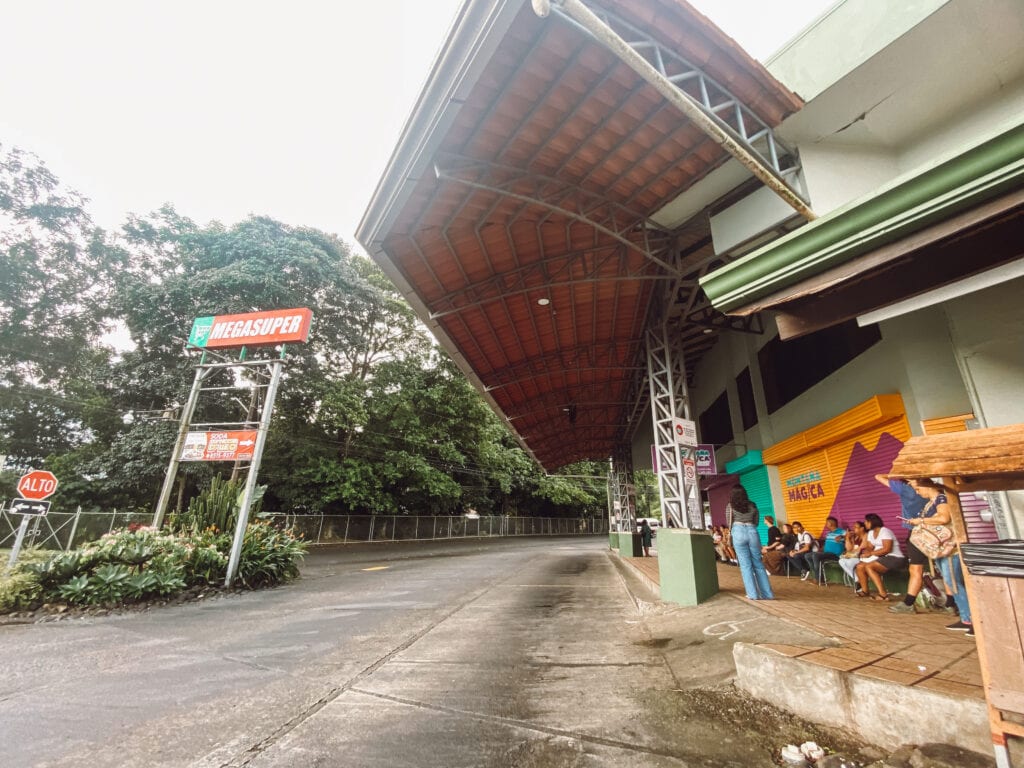
2. Bus El Tanque – Upala
There is no bus station in El Tanque, just a small shelter on the side of the road. The bus stop is located as you turn left off El Colono / 142 onto another road that’s also called 142 (at this intersection, the original 142 coming from La Fortuna changes into 141). To help, see this location pin on Google Maps .
Another way to find the bus stop is to put in “Antojitos ISA” into Google Maps. This is a small soda located right next to the bus stop. You could even get breakfast here if you have time. I got a to-go coffee with milk for 1,000 CRC. Needs must at 7am, lol.
The next bus you need to get is from El Tanque to Upala (the same bus will continue on to Penas Blancas after a break in Upala).
This bus originates elsewhere but is supposed to pass through El Tanque around 7am-7:20am daily. You can check at the tourist kiosk near La Fortuna bus station to confirm the timing, which is what we did.
Right at 7:10am, a double decker blue Transpisa bus arrived. It said Upala on the front windshield, not Penas Blancas. We hailed it and got on.
The bus tickets cost 2,900 CRC (~$4.88 USD) per person and there was plenty of room to sit. We stored our big backpacks in the under hold.
As a side note, the bus we were originally supposed to take from La Fortuna never passed through El Tanque! So we were really glad we took an uber, to say the least.
Cost: 2,900 CRC / $4.88 USD per person
Time: 10 minutes waiting, 2.5 hours to Upala
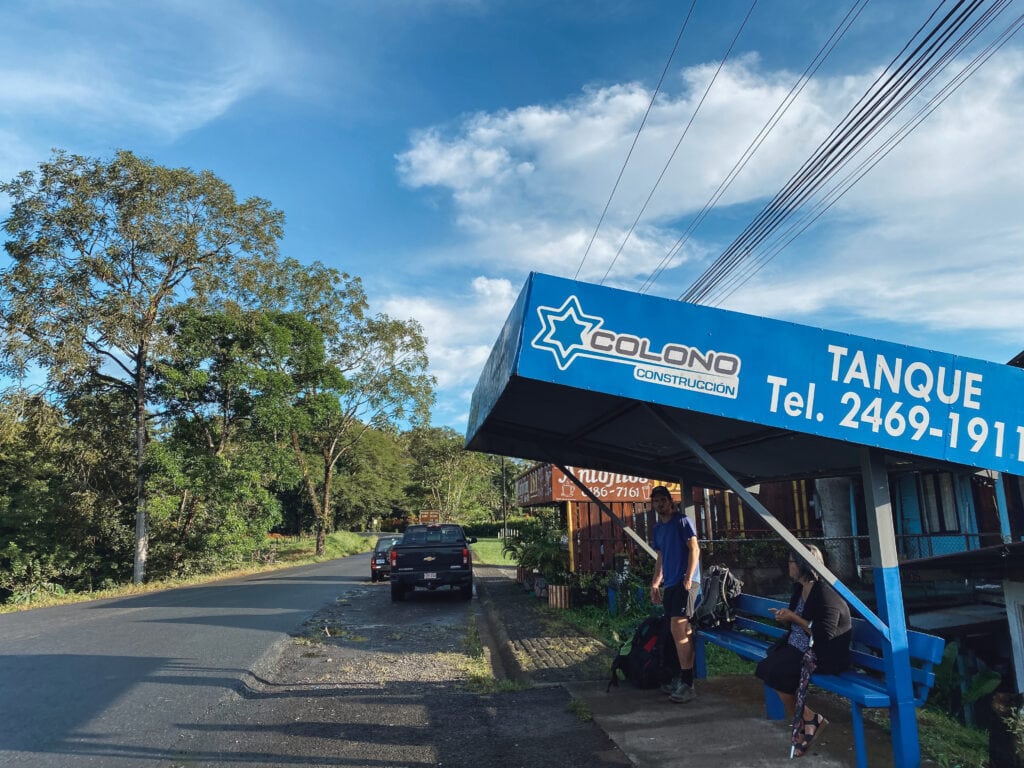
3. 20 Minute Break at Upala Bus Terminal
We arrived to Upala bus station around 9:40am. Keep in mind that lots of people get on and off at various stops, and there are about three previous stops in Upala before you get to the main bus terminal (it is obvious when you are there).
Once at Upala, we all had to get off the bus, but our big backpacks remained in the hold. This is a relatively small bus station with a few sodas, benches, and bathrooms. It costs 350 CRC (~$.60 USD) to use the bathrooms.
Cost: –
Time: 20 minutes
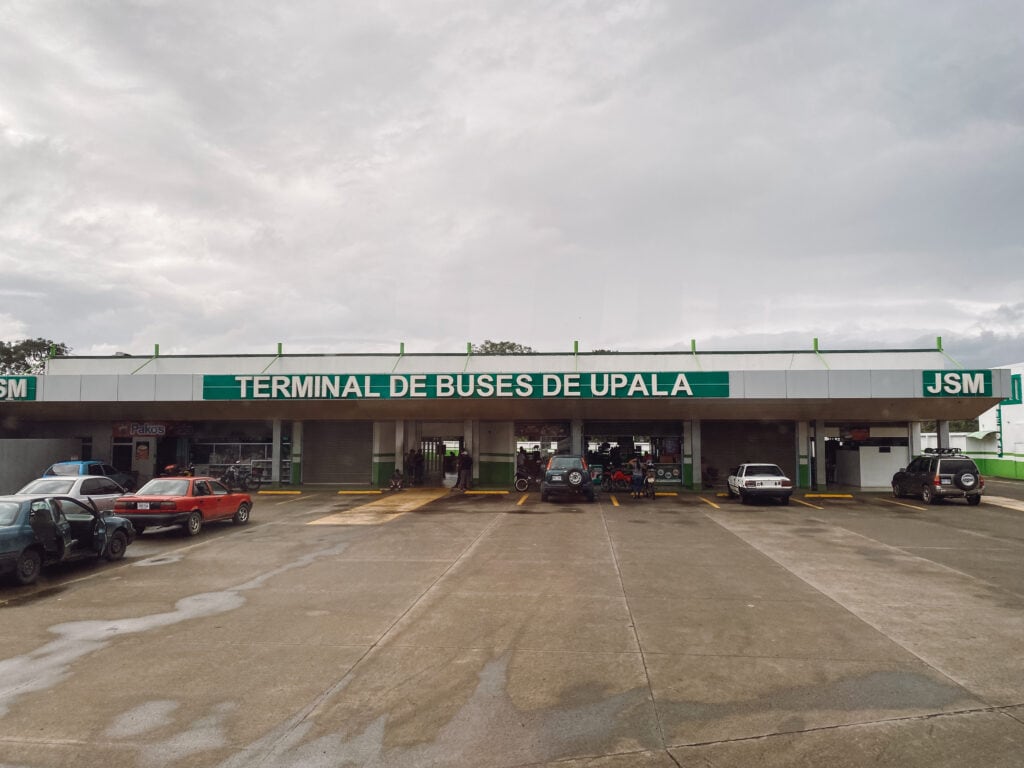
4. Bus Upala – Penas Blancas
We reboarded our bus at 10am and paid the driver for our bus ticket from Upala to Penas Blancas. This cost 4,500 CRC ($7.58 USD) for two people. We were told only 4,200 CRC (so, 2,100 CRC per person), however the driver only had change for 4,500 CRC…. this happens a lot in Costa Rica.
Next, our bus traveled onward from Upala to Penas Blancas. This part of the journey went really smoothly and took about three hours. We arrived to the border around 1pm, so yes, it was a long morning!
Cost: 2,250 CRC / $3.78 USD per person
Time: 3 hours
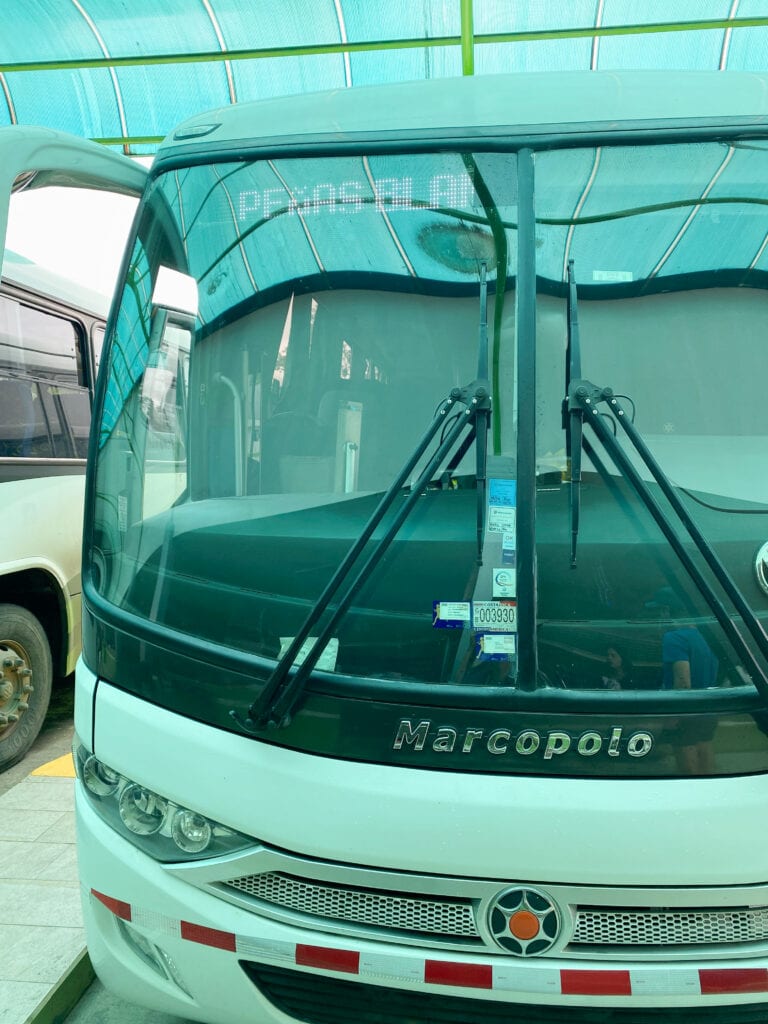
5. Pay Costa Rica Exit Tax
Once we arrived at the Penas Blancas border, the bus driver directed us to these super random houses. If you face away from border they’re on your left (see the photo below). Here, we had to pay the Costa Rica exit tax (“impuesto de salida”).
Weirdly, there are two competing houses here. You’ll probably see a couple people yelling you over, urging you to go into their house and not their neighbor’s. Yes, these look like houses people live in. And yes, they’re actually official (somewhat).
We went to the house on the left. There is a sign saying $8 exit tax with a $2 service charge. That service charge was annoying but we just showed our passports, paid, and got our receipts (that said $8…). Please note that NO cards are accepted and they don’t always give you change, according to reports. You also need to pay in USD and not CRC.
Note: Later in the Costa Rica immigration building we did see a console / ATM-thing that said “impuesto de salida” and it only charged $5 exit tax and a $2 “luggage fee”, and you could also pay with card. This definitely looked more official, and was only $7 compared to $10 at the odd houses. However the screen was black and I’m unsure it was operable. To be honest, it was annoying, but worth the potential extra $3 to not have to walk there and back in the heat with our backpacks…
UPDATE 2024 | According to traveler Vincent who commented below, it is now possible to pay the exit fee via credit card with a QR code provided at the customs building itself. Here is a link to the payment page in case the QR code does not work. This cost him $8.
Cost: $10 USD per person
Time: 15 minutes
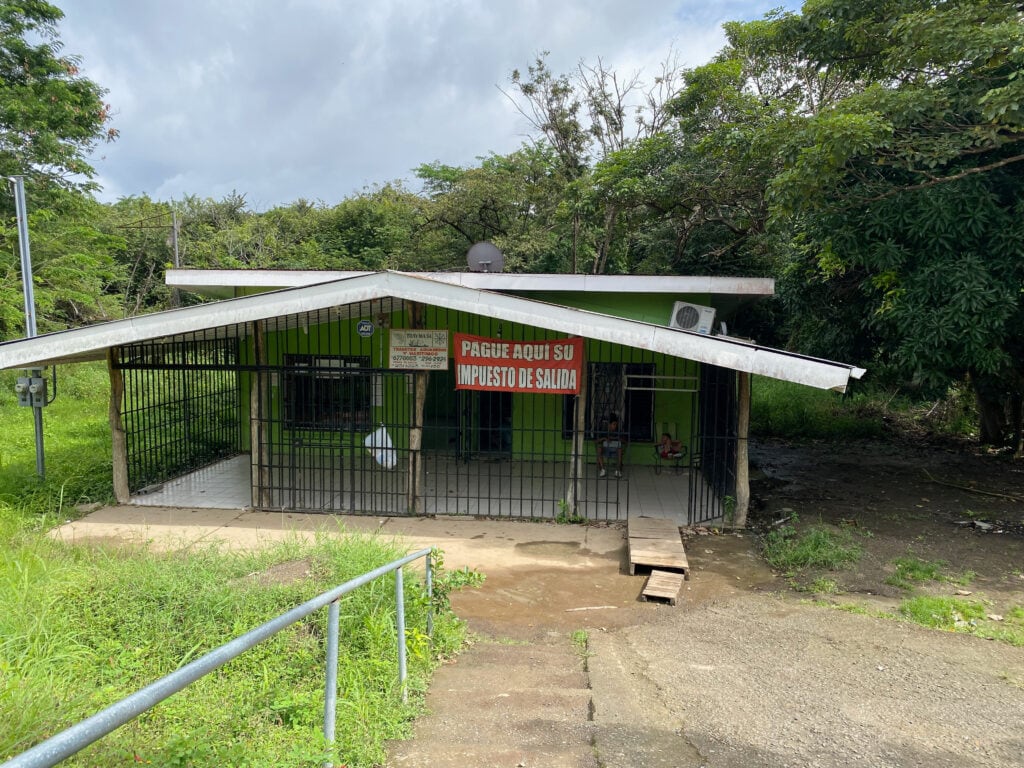
6. Exit Costa Rica
From the strange exit tax houses, we walked right toward the Costa Rica immigration building. It is on your left hand side and the door says “salida”.
We waited in a short line here, and the Costa Rican immigration officials checked our passports and stamped them – no questions. They did look at the exit tax receipt and approve it, so it’s not a complete scam.
Outside this building there is a free toilet. I recommend you use it as the next few steps take a long time.
Cost: –
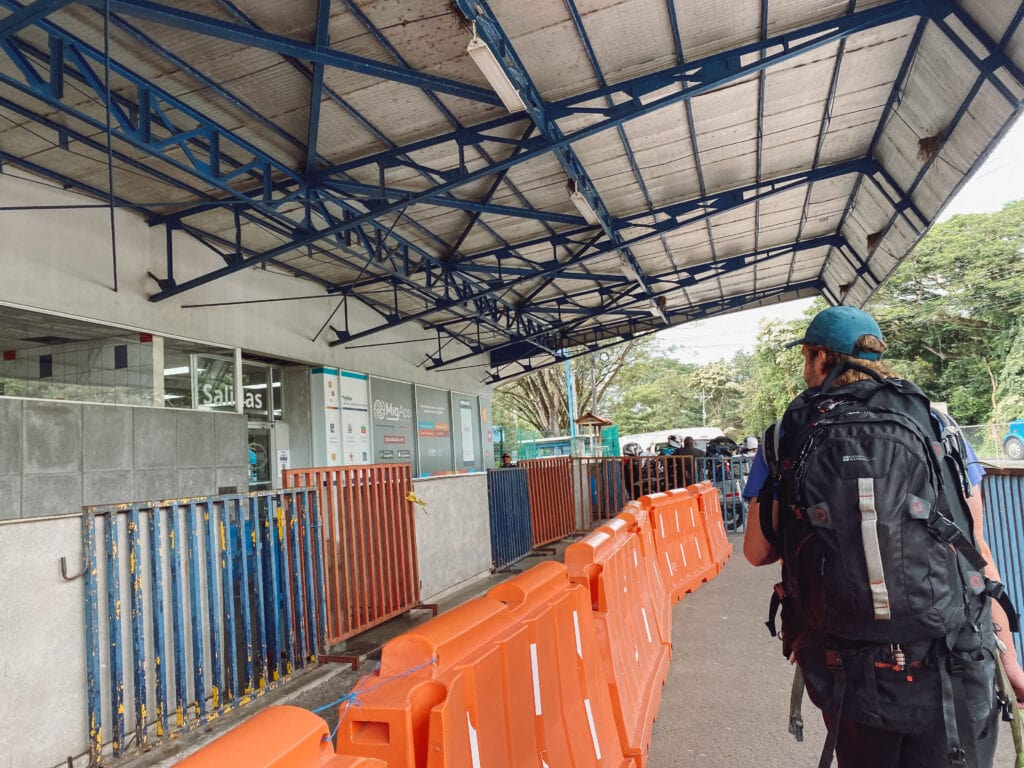
7. Cross No Man’s Land
Next, you have to walk across no man’s land between Costa Rica and Nicaragua. This no man’s land is no joke – it’s about 300 meters along a very hot paved road. This was our longest no man’s land so far on our travels!
I did not find the area sketchy or concerning at all. There is a police presence, as well as other travelers crossing on foot. When we crossed the road was also at a standstill with truck traffic.
Keep your passport and vaccine card accessible during this walk. After about 120m we had to show our passports to a Costa Rican border patrol, who checked that we had our exit stamp.
After an additional 60m we had to show our passports again to another police guy (I’m assuming Nicaraguan). Here, we also had to show our vaccine cards to a health official.
Then, we walked another around 60-80m before we had to cross the road when we saw a sign for Nicaraguan immigration. It’s easy to find this because there is a big parking lot with a big white building and a few other buildings.
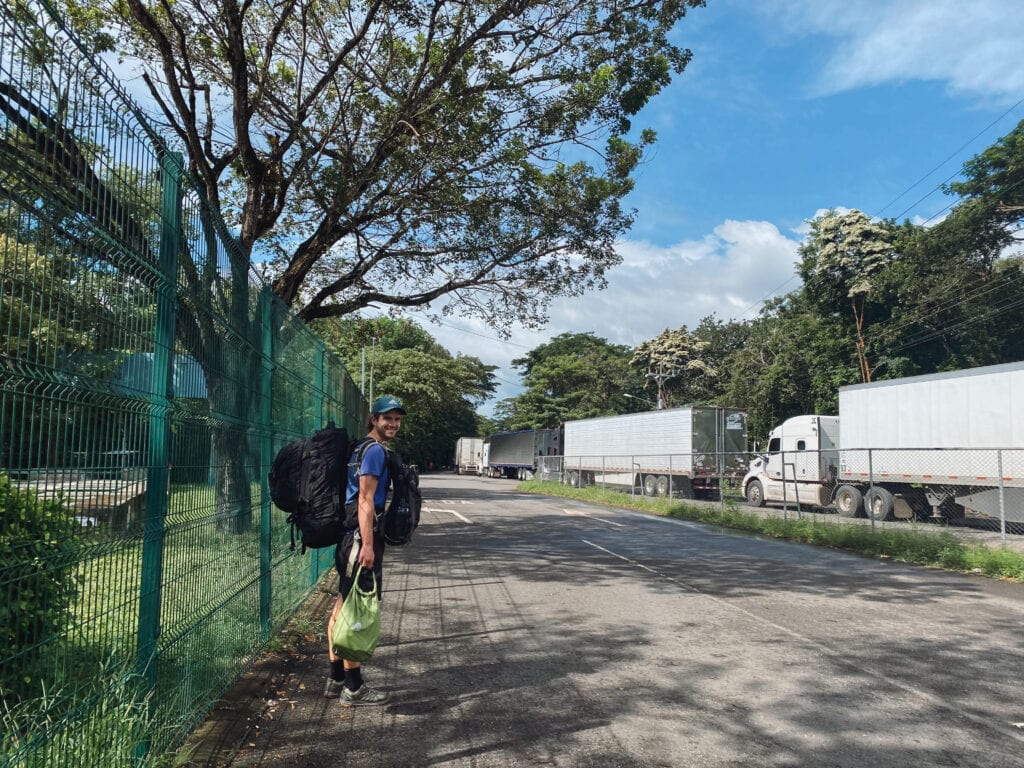
8. Show Vaccine Card
Once in the big parking lot, there is a smaller building for health requirement checks, and a larger main immigration building. We decided to go to small building first because the line was short, and we figured it would be awful to wait in long line at the main building only to find out we had to get health stuff sorted first.
I’m so glad we did this because later on we saw a lot of people get turned away after waiting hours in line because they hadn’t gotten their health documents checked first!
After waiting in line, we showed our vaccine cards again and got a tiny piece of paper handwritten with our initials and the date. That was it!
Note: Don’t lose this paper! It looks unassuming but it’s very important later.
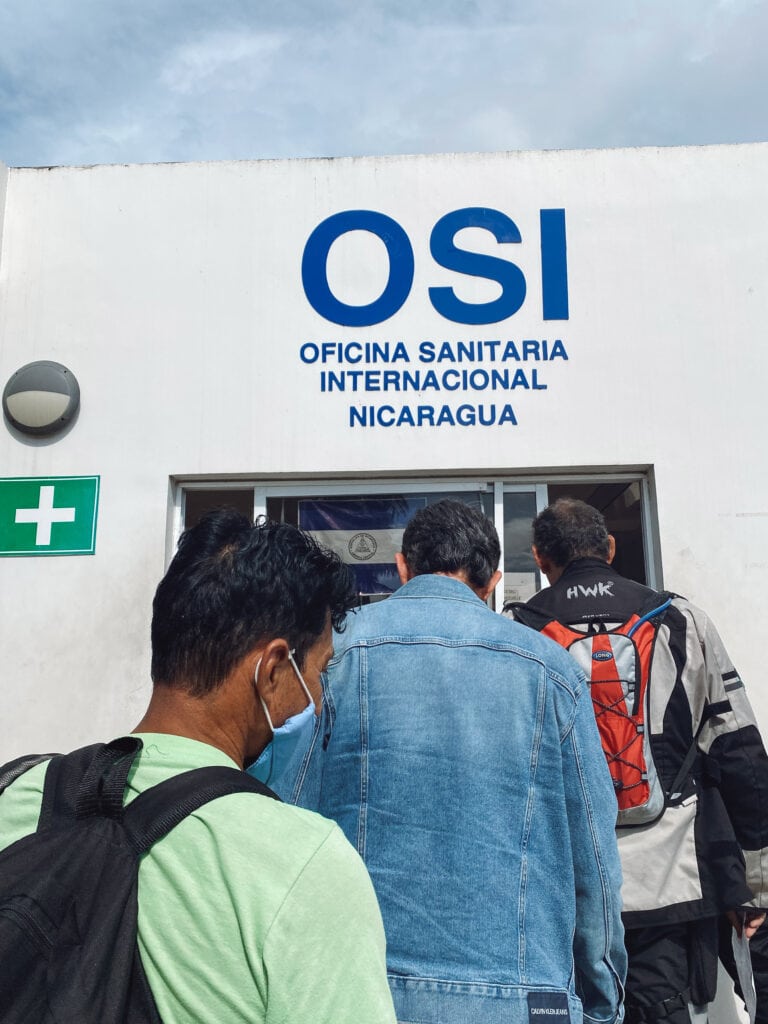
9. Enter Nicaragua
Next, we walked over to the main immigration building where we got in line. And what a line it was. We arrived around 1:30pm and waited in line until 3:15pm.
While waiting in line an immigration official came by and took a $1 USD per person “municipality tax.”
Once we got up to the main border agent we had to pay another tax. The Nicaragua entry tax was $14 USD per person . We were expecting it to be $13, but it was $14 so either we got scammed or inflation has made itself known here as well. (I’d be interested if you comment below what you get charged!)
The official asked us a few questions at this point – including our occupations. I recommend stating your occupation at home and not just saying you’re “traveling” because that can raise red flags about whether you’ll leave the country. I’ve also been told to avoid mentioning if you’re a journalist.
We were also given our Nicaragua entry cards at this point. DO NOT LOSE THIS!! This is a very unassuming piece of paper that they’ll probably tuck in your passport. You need to show it when you leave Nicaragua , or you could be fined $20+. Nobody tells you this at the border; most people learn it the hard way. So trust me – KEEP THIS CARD SAFE.
After getting our passport stamps, we walked past immigration and put our luggage through the scanners. And that was that!
Cost: $15 USD per person
Time: 2 hours
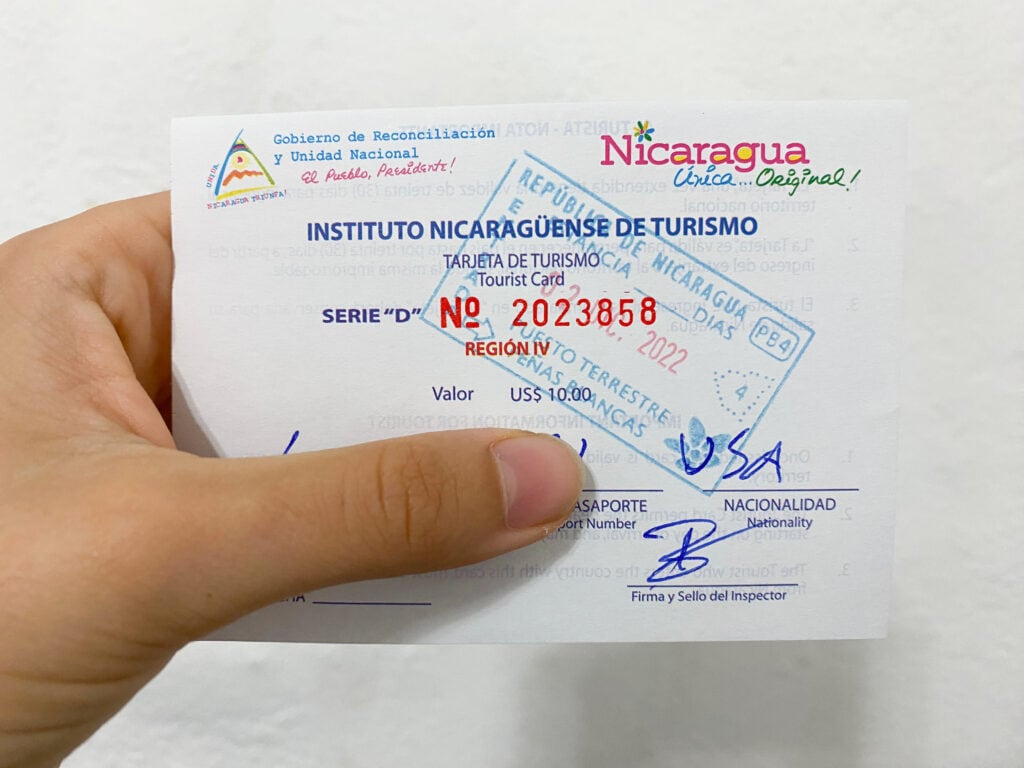
10. Chicken Bus to Penas Blancas – La Virgen via Rivas
At last! It’s time for your onward travel to, well, wherever you’re heading in Nicaragua. I discuss the various options more in depth in the next section. Personally, though, we were heading to San Juan del Sur, a beachy backpacker surf town on the Pacific Coast (for the record, this is where every other traveler was heading, too).
We took the iconic, cheap, and chaotic chicken buses all the way to San Juan del Sur (#ForTheBlog #ForTheBudget). However, I will say that as soon as you walk past the border grounds you’ll be bombarded by taxi drivers. They’ll offer $25 USD to San Juan del Sur, which you can barter down to $22 USD pretty easily. If you split this with other travelers, it’s a great deal.
To get to where the chicken buses leave, you need to walk through the mob of taxi drivers about 100m. There is a big parking lot with chicken buses on your left – it’s extremely obvious and you can’t miss it!
Once in the parking lot, we spoke to some locals who told us where to wait for the bus to Rivas. There are also buses leaving express to Managua, and you want to avoid these. Each bus has a big sign where it’s heading.
Get on the chicken bus to Rivas (ours left at 4:20pm – they leave every 30 to 45 minutes). For the most direct route to San Juan del Sur, sit near the front (if you can) and tell the driver you want to get off at “La Virgen” (pronounced “la beer-hen”). It cost us only 20 NIO (~$.55 USD). The journey took about 35 minutes and we got off the bus at 4:55pm.
Cost: 20 NIO / $.55 USD per person
Time: 1 hour
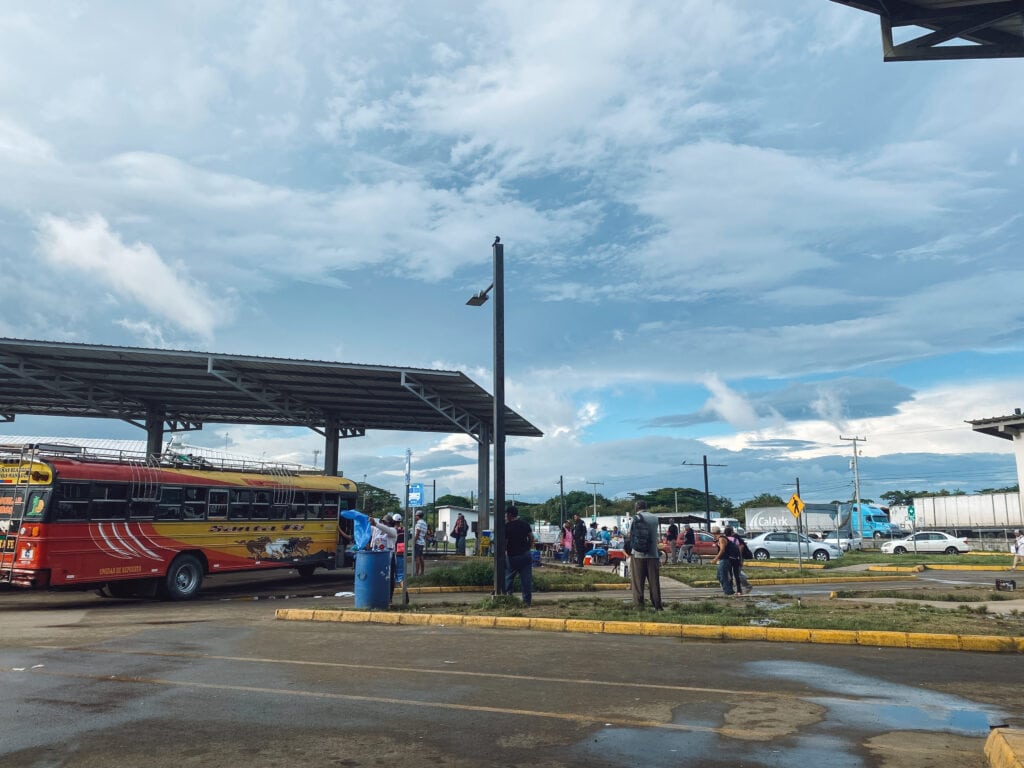
11. Chicken Bus to La Virgen – San Juan del Sur
After getting off the chicken bus in La Virgen, you are literally on the side of the road in the middle of nowhere (for this reason, you really do need to tell the driver where you want to get off, otherwise you’ll never see it and they’ll drive straight past).
Luckily, Dan and I found a couple other travelers doing the same route and we banded together. To get to where the next chicken bus leaves, you cross the main road (route 1) and turn onto the intersecting road (route 16). Search “La Virgen” on Google Maps and you’ll see.
We walked along route 16 for about 10 minutes staying on the right-hand side of the road (the direction for travel to San Juan del Sur). There is no bus stop or station for chicken buses, so we just kept our eyes out for it! Thankfully, a chicken bus zoomed past at about 5:20pm and we hopped on. It cost 30 NIO (~$.82 USD) and took about 20 minutes driving to reach San Juan del Sur. Once in SJDS, it was easy to walk to Saltwater Hostel , where we stayed and where I recommend!
Cost: 30 NIO / $.82 USD per person
Time: 45 minutes
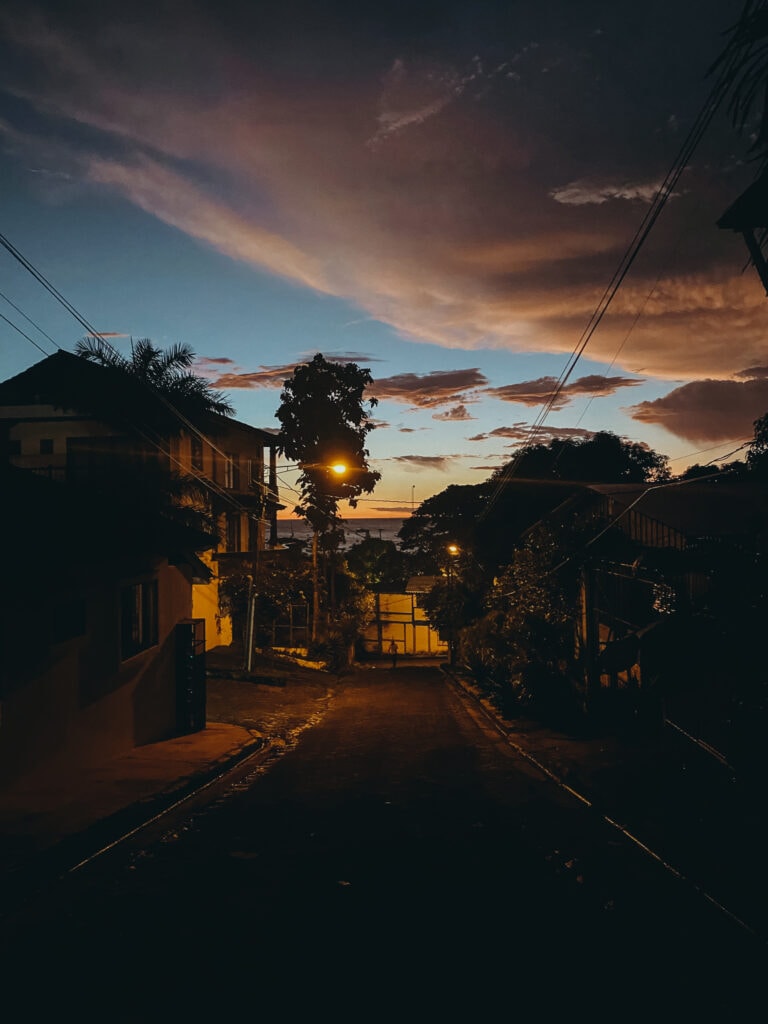
Onward Travel From the Costa Rica Nicaragua Border
Chances are, you’re probably heading to San Juan del Sur, too. It’s an incredibly popular backpacker location. It was a little too party-central for my taste, but it’s a great first stop to get your bearings as it’s relatively close to the border. Just use my instructions above for onward travel to San Juan del Sur!
Other options for onward travel from the Costa Rica – Nicaragua border include:
- Ometepe: This double volcano island is a backpacker must-visit while in Nicaragua. It would be a rush to get here in one day from the border. You’d have to take the chicken bus to Rivas, a taxi or bus to San Jorge ferry terminal, and then a ferry to Ometepe. It’s achievable if you cross the border really early in the morning, though.
- Granada: The colorful colonial city I fell in love with in Nicaragua! Take the chicken bus to Rivas, and then another chicken bus to Granada. Again, it’s a long journey for one day especially if you’re coming from further afield in Costa Rica.
- Managua: Nicaragua’s capital city is not really a travel destination in itself, and it’s a bit seedy and unsafe. However it’s a good jumping off point for flights to the Corn Islands, or onward travel to Leon. The most direct route is the TransNica bus from San Jose, Costa Rica all the way through to Managua, Nicaragua.
For more onward travel plans, Rome2Rio is my go-to free tool to figure out travel routes. I will say that I found it pretty inaccurate for bus travel in Costa Rica to the border, and it doesn’t include any data on chicken buses. So, it’s a less reliable tool in this region than elsewhere.
Shuttle vs. Public Transport
At this point you may be wondering, why not just take a shuttle?
Undoubtedly, a private shuttle would be a LOT easier than the combination of chicken buses, public buses, and ubers we took during our border crossing adventure.
Actually, shuttle was our original plan – but it is just way too expensive to justify, at least for our travel budget.
Caribe Shuttle seems to be the highest recommended border crossing shuttle, but take the prices on their website with a grain of salt. They don’t include taxes, and more importantly, the shuttle needs a minimum of four people for you to get the listed price.
We contacted them about travel from La Fortuna to San Juan del Sur, but unfortunately the price we were quoted was $150 per person (whereas it says $66 per person on their website). We actually contacted them with two weeks’ notice, but unfortunately no other travelers joined to cut down the price.
Alternatively, it costs $45 per person (if the shuttle is full) from Liberia to San Juan del Sur. However it takes three different buses and basically a whole day of travel to reach Liberia from La Fortuna, so this was another no-go.
Note that those prices don’t include the $25 USD worth of exit and entry taxes at the border.
If you’re up for a bit of adventure, I recommend doing this border crossing by public transport rather than an expensive private shuttle. It’s a long day but not that difficult in the end, and you’ll save a ton of money.
Costa Rica to Nicaragua Border Crossing Overview
Everyone’s border crossing experience will be a little bit different. Ours is based on traveling from La Fortuna, Costa Rica to San Juan del Sur, Nicaragua. Traveling in a couple, we also get the benefit of splitting the uber cost. We also had a long two hour wait at this border, which I think is pretty normal and something you should consider in your plans.
Total time: 12 hours
Total cost: $37.03 USD per person
Safety Tips for the Costa Rica Nicaragua Border
Generally, I felt pretty safe at this border. There is a large traveler presence because this is the main border between Costa Rica and Nicaragua. Many “expats” (I hate that term) do border runs here so it is heavily trafficked and there is usually an English-speaking person around somewhere to help.
Saying that, you still need to have your wits about you.
In order to remain safe at the Costa Rica – Nicaragua border, here are a few tips:
- Have a secure zip pocket or fanny pack for your passport and vaccine cards. I found myself taking my passport out a LOT at this border. It would be easy to lose it in the hustle so I was really glad I had a fanny pack for this one. This is the passport case I use, and this is the travel fanny pack I use.
- Begin your day as early as possible, to give yourself plenty of daylight to complete the border crossing.
- Don’t cross the border at night.
- Try to join up with other travelers at the Nicaraguan border if you’re attempting the chicken buses. It can be hectic and confusing and I wouldn’t have felt comfortable doing this on my own (not due to anything sinister, but because it would be easy to get lost at La Virgen).
- Have USD cash with you, including exact change for a $10, $1, and $14 entry/exit taxes.
- Have some extra USD or CRC on hand to exchange into NIO at the border. This is what we did and although we lost a little bit in the exchange, we thought it was fair and worth it in order to enter a new country with a little cash on hand!
- Use your valuables (camera, phone, jewelry, wallet) discreetly.
Final Thoughts on the Costa Rica to Nicaragua Border Crossing
I really hope this guide was helpful to any fellow travelers attempting the Costa Rica to Nicaragua border crossing! It was our longest and most convoluted border crossing to date.
This is also the first article to detail the journey directly from La Fortuna – which was shocking to me as that’s such a popular tourist destination! So I really hope my firsthand account is useful to you if you’re in the same position.
If you find this guide helpful for your own border crossing journey, I’d really appreciate it if you leave a comment below. Let me know how your trip went, how much your entry/exit taxes were, and how long the line was (did we just get unlucky?!). I will keep this blog post updated so it remains useful for all of us!

Pin it for later…
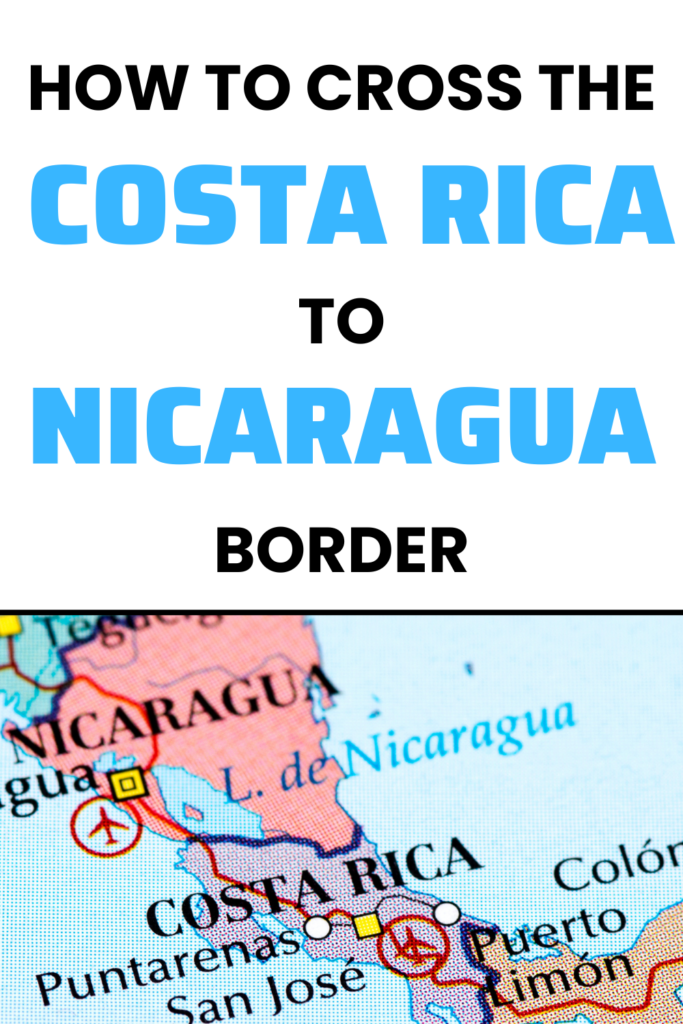
Looking for more?
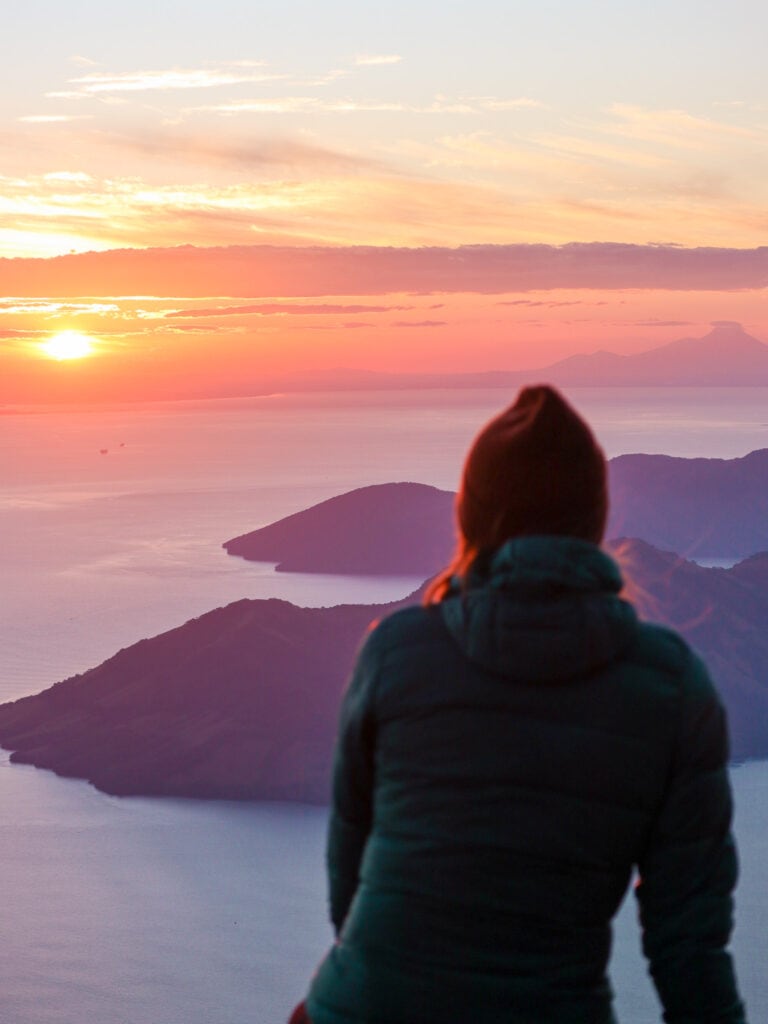
Conchagua Volcano Camping: Everything You Need to Know
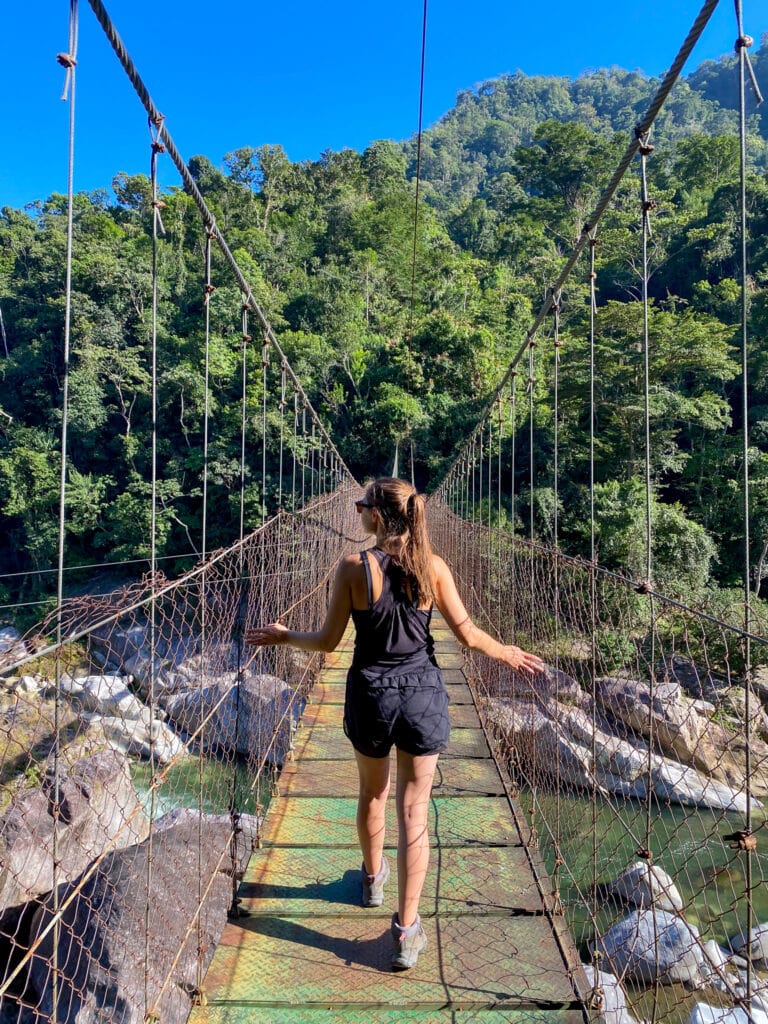
11 Fun Things to Do in Pico Bonito National Park in Honduras
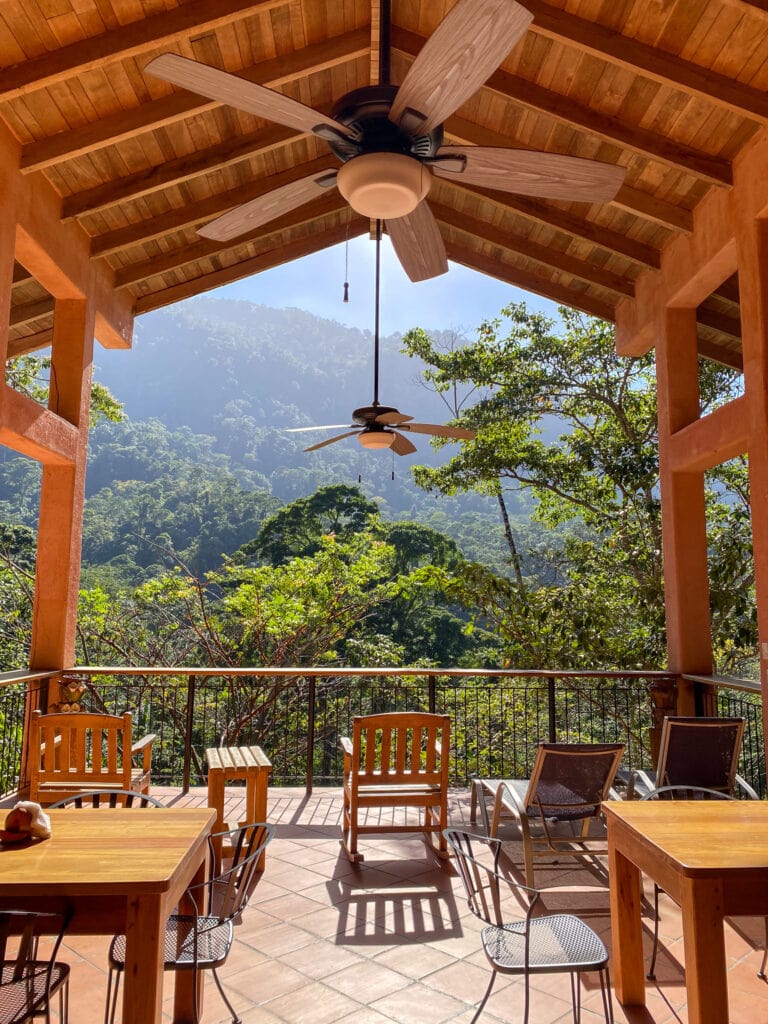
Checking In | An Ecotourism Adventure at Hotel Rio in Honduras
Thank you for this super helpful post!
My boyfriend and I are are thinking about attempting this in a couple weeks but in reverse – Leaving Nicaragua and crossing over to Costa Rica in the hope of making it to La Fortuna in one day.
You may not know as you were travelling in the opposite direction but do you know how frequent the buses leave Penas Blanca in Costa Rica?
Many Thanks & Happy Travels!
Hi! Thanks for reading. Unfortunately I’m not sure how frequently the bus goes from Penas Blancas to Upala. Sorry I can’t be more help. It may be worth asking in the Backpacking Central America FB group. If you do find out when you do your border crossing, would you mind leaving a comment here with the info? I’m sure other people are reading this and wondering the same!
Thank you for this! We are getting the Tica bus next week up to Granada! We are not US citizens, so I am baffled why they don’t take anything other than US dollars! How annoying – I may tell them this and risk them accepting colones… but I may not!
Good luck! I found a lot of places throughout Costa Rica accepted USD or explicitly asked for this. To the point that almost every ATM in Costa Rica will also give you USD if you select it. To be on the safe side, I’d try to get some USD out of an ATM before your border crossing, personally!
I just crossed the border (may 10th 2023) and would like to update: – you can pay the Costa Rica exit fee via qr code at the customs building itself with credit card. They raised it to 8$. Here is the link: https://www.bancobcr.com/wps/portal/bcr/bancobcr/personas/solicitudes_en_linea/pago_impuesto_salida_terrestre
– whole process took us like 20 mins including waiting and walking. – entry fee in Nicaragua was 13$ per person -no atm around, bring cash also for the bus and food you want to buy – on the Nicaraguan side we unfortunately followed a guy from the bus and said we only pay in the bus. Unfortunately the scamming system is very profound and he then charged us in the bus 10$/pax. Later a different guy (in uniform!) came around and charged all the locals a different amount. When he saw that we watched him to check the amount he turned his back towards us. The locals watched the scam and were laughing, not the best welcome —> make sure to ask the price before you head into the bus. Peñas to Managua should not be 10$/person but I do not know the correct price. Also do Not pay anyone without uniform
The guide above helped us quite a lot and I would like to thank you for your work!
– whole process took us like 20 mins including waiting and walking. – entry fee in Nicaragua was 13$ per person -no atm around, bring cash also for the bus and food you want to buy – on the Nicaraguan side we unfortunately followed a guy from the bus and said we only pay in the bus. Unfortunately the scamming system is very profound and he then charged us in the bus 10$/pax. Later a different guy (in uniform!) came around and charged all the locals a different amount. When he saw that we watched him to check the amount he turned his back towards us. The locals watched the scam and were laughing, not the best welcome —> make sure to ask the price before you head into the bus. Peñas to Managua should not be 10$/person but I do not know the correct price.
Anyway the guide above helped us quite a lot. Thank you for that effort!
Two hours in line sounds like a breeze to me!
I have spent literal hours at this border every time I crossed it. I have crossed this border to both directions in 2010, 2012 and 2015. The first time we were stuck at the Costa Rican side alone for about 6hours. Every single time the actual time spent from arriving at the border to leaving it has been 6+ hours. A lot of the time it was just random waiting around or waiting for the bus to be checked.
My favorite memory is from 2010 when me and a friend accidentally walked across the no man’s land (wasn’t this fancy looking back then) as we lost our TicaBus. So once we were at the Nicaraguan side and finally found the bus, the driver told us to go to this random building at the side of the complex, ask for Fernando and give him our passports. So that’s what we did and luckily it all turned out fine in the end.
So interesting to see from your pictures how much the Nicaraguan side has developed! It used to be sketchy af, and with minimal shade from the sun.
Hi, thanks for this! We are planning to cross the border later in the day, by the time we are ready to catch our bus to Rivas it may be 6/7pm or even later if there are delays. Do you know when is the latest bus going from the border to Rivas? Cant find any bus schedules anywhere online
Personally I wouldn’t recommend crossing any border at night due to safety concerns, better to wait until the next morning if possible!
Leave a Reply Cancel reply
Your email address will not be published. Required fields are marked *
Nicaragua Costa Rica Border Crossing: Complete Travel Guide
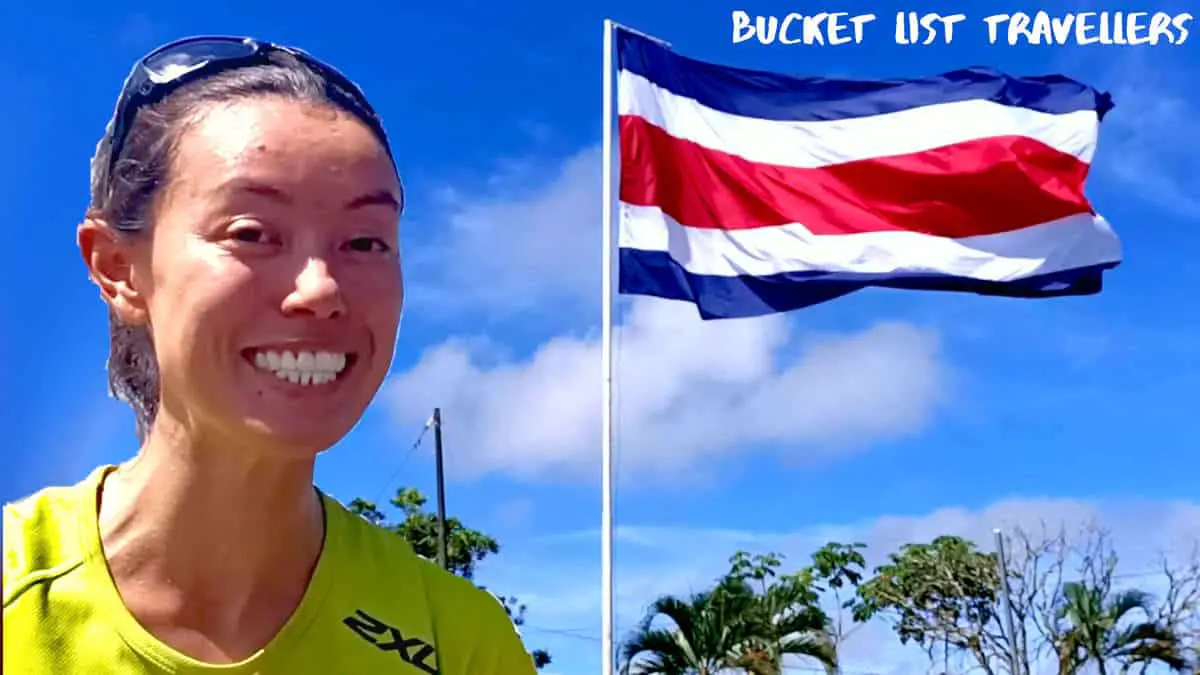
Land border crossings can be stressful experiences if you don’t know what to expect, but fortunately you’ve come to the right place! Read on to find out everything you need to know about crossing the border from Nicaragua to Costa Rica from start to end. This information is particularly useful for people travelling overland across Central America as well as people doing border runs between Nicaragua and Costa Rica. Specifically, we will be covering:
- Entry requirements for Costa Rica
- Entry requirements for Nicaragua
- Exit fees and entry fees for Nicaragua and Costa Rica
- Locations of Nicaragua / Costa Rica land border crossings
- How to get to the Nicaragua/Costa Rica land border crossing points
- Our experience of crossing the border from Nicaragua to Costa Rica
- Nicaragua visas – the CA4-90 day visa for Nicaragua as well as getting visa extensions in Nicaragua
Why do the Nicaragua to Costa Rica land border crossing
There are a number of reasons why people choose to cross the land border between Nicaragua and Costa Rica. The main reasons are as follows:
- Travelling overland across Central America – Central America is a great budget destination, especially if you travel overland. If you are planning to embark on this adventure, you will need to cross the land border between Nicaragua and Costa Rica during your trip.
- Border runs between Nicaragua and Costa Rica to renew visas – this is a common tactic of longterm visitors to Nicaragua as well as to Costa Rica. However with Nicaragua requiring Covid tests on entry it is much cheaper to get a visa extension if you can. We will outline how to get visa extensions in Nicaragua later on in this post.
- Flying in or out of Liberia Airport Costa Rica to go to Nicaragua – many people use Liberia Airport in Costa Rica when they want to go to Nicaragua. This is particularly the case during Covid where many flights to Managua Nicaragua are cancelled. Liberia Airport is around 1.5 hours drive from the Nicaragua Costa Rica border and is currently a much easier way to travel to Nicaragua.
Why we did the Nicaragua to Costa Rica border crossing
We came to Nicaragua in March 2020 as part of a year long trip around the world. Our plan was to travel overland from Mexico all the way through Central America to Panama. As part of this trip we planned to cross the border from Nicaragua to Costa Rica. We had originally planned to stay in Nicaragua for 3 weeks, but the world had other plans. When borders shut due to the Covid pandemic we found ourselves stuck in Nicaragua . We subsequently lived in Nicaragua for 18 months. During this time we immersed ourselves in this beautiful country.
We were on the CA4-90 day visa . During 2020 there were limited flights out of the country. Additionally, the land border to Costa Rica was closed between March 2020 and April 2021. As such the Nicaraguan government allowed us to keep extending our visas every 30 days. However in July 2021 we were given our final visa extension and told to leave the country in the next 30 days. We waited until the last possible day to leave Nicaragua . On August 22, 2021 we finally crossed the border from Nicaragua to Costa Rica .
Nicaragua Costa Rica land borders
Where are the land border crossings between nicaragua and costa rica.
The land border between Costa Rica and Nicaragua is also known as Frontera Nicaragua Costa Rica.
There are 2 main land border crossings between Nicaragua and Costa Rica:
- Peñas Blancas – the most popular border crossing is at Peñas Blancas on the Pacific side of Nicaragua. This border crossing is around 1.5 hours from Liberia Airport in Costa Rica. It is also the closest border crossing to the main tourist destinations in Nicaragua.
- San Pancho-Los Chiles – we did the crossing on the Caribbean side at San Pancho. This is a great option if you want to discover more off the beaten path destinations in Nicaragua such as the Indio Maíz Biological Reserve. It is also a convenient entry point for onward travel to La Fortuna in Costa Rica. In our experience, it was a fairly quick process when going from Nicaragua to Costa Rica at the San Pancho-Los Chiles border crossing. However if you are going from Costa Rica to Nicaragua the queues are very long.
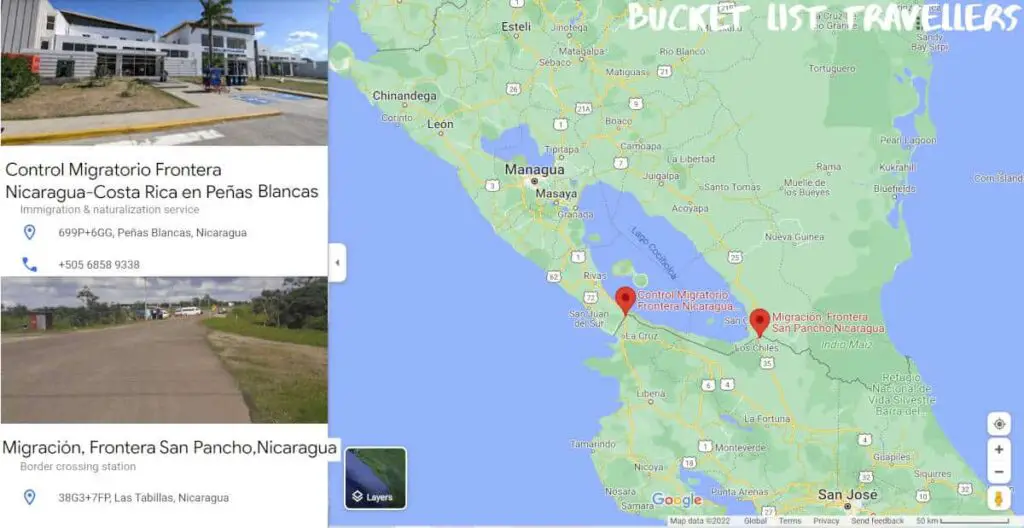
Is the Costa Rica Nicaragua land border open?
Yes. The land border between Costa Rica and Nicaragua is currently open. The land borders between Nicaragua and Costa Rica were closed from March 2020 to April 2021 due to the Covid pandemic. Since April 2021 the land borders are now open. Due to Covid, there are extra requirements when travelling between Nicaragua and Costa Rica . In order to have a smooth border crossing, preparation is key.
Preparing for the land border crossing between Nicaragua and Costa Rica
When preparing for the border crossing it is important to understand the entry and exit requirements for each country. The information we have is accurate as at January 2023. The situation is constantly evolving, so be sure to look up the current requirements if you are planning this trip yourself.
Costa Rica Entry Requirements
As at January 2023 the Entry Requirements for Costa Rica are as follows:
Costa Rica Entry Requirement 1: Valid Covid vaccination or valid Health Insurance NO LONGER REQUIRED
From 1 April 2022 Costa Rica has removed all Covid related requirements to enter Costa Rica. This means you do not need to provide proof of vaccination, recovery or health insurance to enter the country. There are also no Covid requirements for travel within the country.
Costa Rica Entry Requirement 2: Online Health Declaration (Costa Rica Health Pass) NO LONGER REQUIRED
From 1 April 2022 Costa Rica has removed all Covid related requirements to enter Costa Rica. As such, there is no requirement to fill out an online health declaration before arriving in Costa Rica.
Costa Rica Entry Requirement 3: Proof of onward journey
Proof of onward journey is a requirement for entry into Costa Rica . This can be in the form of a plane ticket or a bus ticket. This is not always asked for, but is technically a requirement. We were not asked for this when we entered Costa Rica.
Costa Rica Entry Requirement 4: Proof of finances
Costa Rica requires visitors to be able to demonstrate that they have funds of at least $100 USD per person per month of stay. We were not asked for this when we entered Costa Rica .

Costa Rica Entry Requirement 5: Valid passport
To enter Costa Rica , you will need to ensure you have your passport with at least 3 months validity beyond the date you enter Costa Rica .
Costa Rica Entry Requirement 6: Check whether you require a Costa Rica visa or need to pay an entry fee
Costa Rica visa requirements vary by country. You can check your visa requirements for Costa Rica here . We have heard of Nicaraguan nationals not being granted access when flying in from the USA as they did not have a green card for the US.
As Australians we did not have to pay an entry fee for Costa Rica .
Costa Rica Entry Requirement 7 (only for temporary or permanent residents): valid DIMEX and up to date caja payments
If you have a Costa Rican temporary or permanent residency you will also need the following:
- A valid DIMEX (Costa Rican residency card)
- Evidence that your Caja payments are up to date. If your Caja payments are not up to date you will still be able to enter. However, you will have 22 days to pay. You will also need to purchase valid Health Insurance to cover Covid medical expenses and Covid related lodging for the 22 day grace period.
Nicaragua Entry Requirements
Nicaragua entry requirement 1: valid passport.
A valid passport with at least one blank page and at least 6 months validity from the date of entry into Nicaragua
Nicaragua Entry Requirement 2: Proof of Covid vaccination or negative Covid PCR test
Nicaragua requires unvaccinated travellers to provide a negative PCR Covid test taken less than 72 hours before entry or 96 hours before entry if you’re travelling from Asia, Africa or the Oceania region.
From 16 June 2022 vaccinated travellers are no longer required to provide a Covid test to enter the country. They only need to provide their vaccination card or certificate showing two or more doses (or one dose in the case of Sputnik Light or Janssen/Johnson & Johnson). There are no limitations in terms of the year the vaccinations were received.
You can find a video of our experience getting a Covid test in San Jose Costa Rica here .
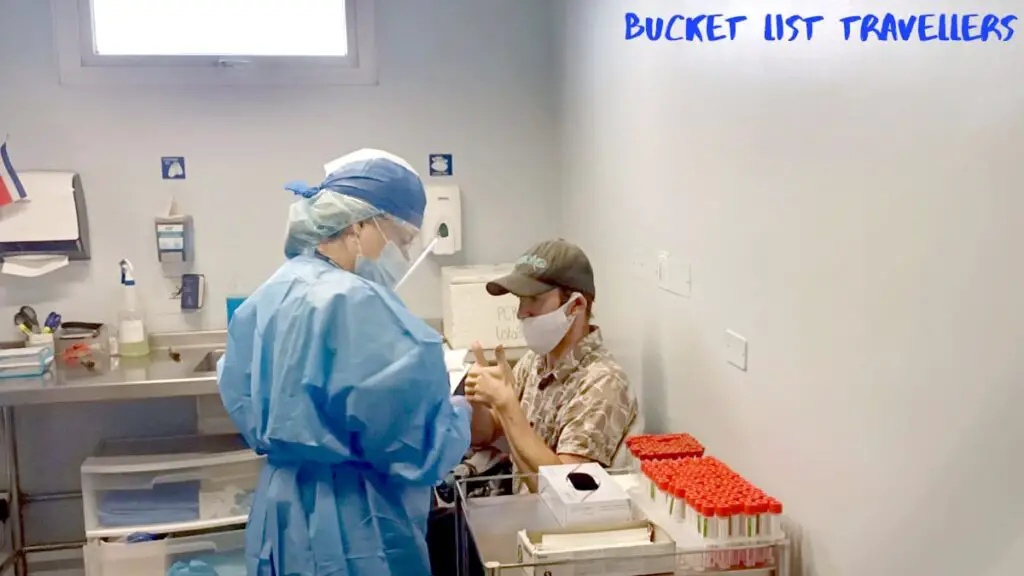
Nicaragua exit fee
We paid $3 USD per person for the exit at San Pancho. There’s an additional $1 USD building fee at the Peñas Blancas exit.
Costa Rica exit fee
The Costa Rica exit fee is $10 USD if exiting overland.
Nicaragua entry fee
There is a $13 USD entry fee to enter Nicaragua. There’s an additional $1 USD building fee at the Peñas Blancas border.
Costa Rica entry fee
There is no entry fee for Costa Rica.
How to get to the Nicaragua-Costa Rica border crossing
There are two official border crossings between Nicaragua and Costa Rica – at Peñas Blancas as well as at San Pancho Nicaragua / Los Chiles Costa Rica. Below are some options for how to get to both border crossings.
How cross land border from Nicaragua to Costa Rica by private transfer
For a completely hassle free experience, you can use a private transport company to drive you between Nicaragua and Costa Rica. Alex Ruiz of Pacific Tours (WhatsApp +505 8918 1935) has an excellent reputation for providing private transport between Nicaragua and Costa Rica. He goes above and beyond to ensure that you reach your destination safely. A number of people in the Nicaragua expat community have said that Alex has also assisted them in dealing with airlines when there has been a problem with their flights. Private transfer is more expensive than other options, but you get full door-to-door service.
How cross land border from Nicaragua to Costa Rica by coach
One of the easiest ways to cross the land border from Nicaragua to Costa Rica is by coach. There are two coach companies that operate in Nicaragua – Nicabus and Tica Bus.
Nicabus operates buses between Nicaragua and Costa Rica:
- Managua (Nicaragua)-San Jose (Costa Rica) – fares are US$28.75 one way or US$57.50 return (prices as at January 2022)
- Chinandega (Nicaragua)-San Jose (Costa Rica) – fares are US$35 one way or US$70 return (prices as at January 2022)
Tica Bus operates buses throughout Central America as well as Mexico.
- Managua (Nicaragua)-San Jose (Costa Rica) – fares are US$29 one way or US$58 return (prices as at January 2022). There are a number of pick-up and drop-off points to choose from in both countries
How cross land border from Nicaragua to Costa Rica at Peñas Blancas border crossing by public transport
How to get from nicaragua to peñas blancas border crossing by public transport.
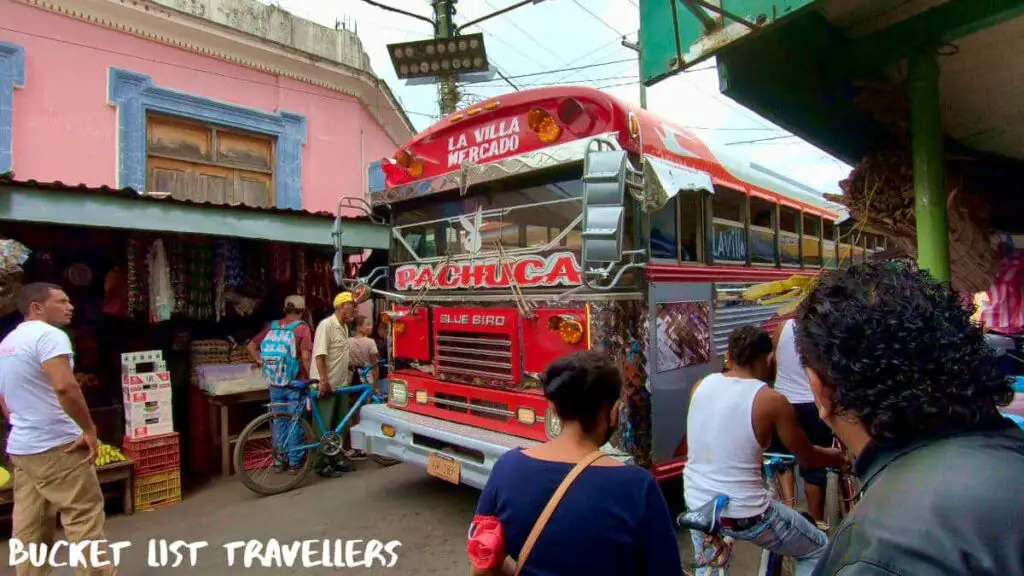
The Peñas Blancas Border Crossing is in the south west of Nicaragua in the department of Rivas. The cheapest way to get to Peñas Blancas is by local bus. The bus to Peñas Blancas goes from Rivas, which is a major bus terminal in Nicaragua. You can get buses to Rivas from Managua, Granada , San Juan del Sur, Ometepe Island, Popoyo and many other popular destinations in Nicaragua. As an example, here is what you need to do to get a local bus from Granada to Peñas Blancas:
- Bus from Granada to Rivas – this costs 50 cordobas (as at 2022) and takes about 2 hours. The location of the bus stop in Granada is listed at “Nueva terminal de buses a Rivas” in Google maps.
- Bus from Rivas to Peñas Blancas – this costs 40 cordobas (as at 2022) and takes less than an hour.
How to get from the Peñas Blancas border crossing to Liberia Airport Costa Rica by public transport
Liberia Guanacaste Airport (airport code LIR) is an airport in Costa Rica which is close to the Nicaraguan border at Peñas Blancas.
From Liberia Guanacaste Airport, these are the buses you need to take:
- 521 bus from Peñas Blancas to Liberia. The travel time is approximately 1.5 hours and there’s a bus every 45 minutes from 5am until 6:30pm. Bus fare is 1750 colones (approximately US$3) per person (as at 2022).
- 513 bus from Liberia to Liberia Guanacaste Airport. The travel time is approximately 18 minutes and buses run every 1-2 hours. Bus fare is approximately 500-600 colones (around US$1). Alternatively a taxi takes around 16 minutes and costs US$16-20 and Uber costs around US$7.50 (as at 2022).
Bus timetable – 521 bus Liberia to Peñas Blancas Costa Rica
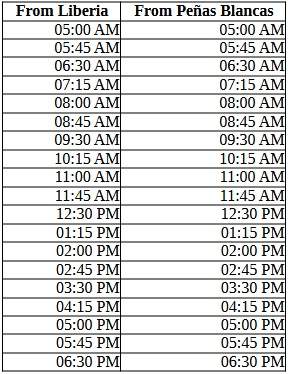
Note – this bus also stops at Santa Rosa National Park turnoff, Cuajiniquil turnoff and La Cruz. La Cruz is 1 hour by bus from Liberia and around 30 minutes by bus from Peñas Blancas.
For more information, see this website: https://grupotranbasa.com/
Bus timetable – 513 bus Liberia to Playa Matapalo via Liberia Guanacaste Airport Costa Rica

* From or to Nuevo Colon rather than Playa Matapalo.
Note – Liberia Guanacaste Airport is 18 minutes by bus from Liberia and around 45 minutes – 1 hour by bus from Playa Matapalo.
For more information, see this website .
How cross land border from Nicaragua to Costa Rica at San Pancho-Los Chiles border crossing by public transport
How to get from nicaragua to san pancho-los chiles border crossing by public transport.
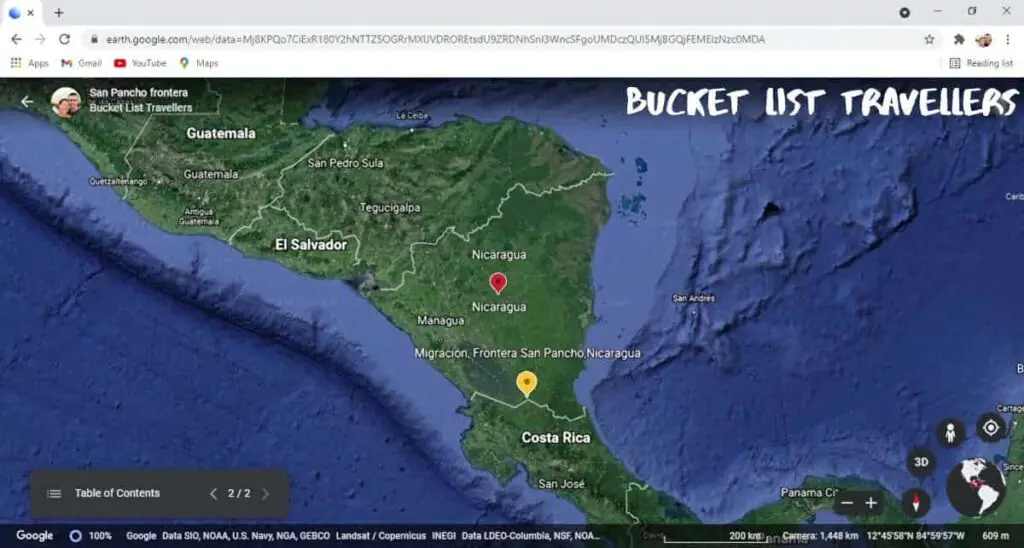
The San Pancho-Los Chiles Border Crossing is in the south east of Nicaragua in the department of Rio San Juan. In order to get to the San Pancho border crossing you will first need to get to San Carlos. The town of San Carlos is the gateway to San Pancho.
How to get to San Carlos Nicaragua by public transport
San Carlos is located on Lake Nicaragua and is also on the banks of the San Juan River. As such, it can be reached by land or by water.
Getting to San Carlos from Managua by bus
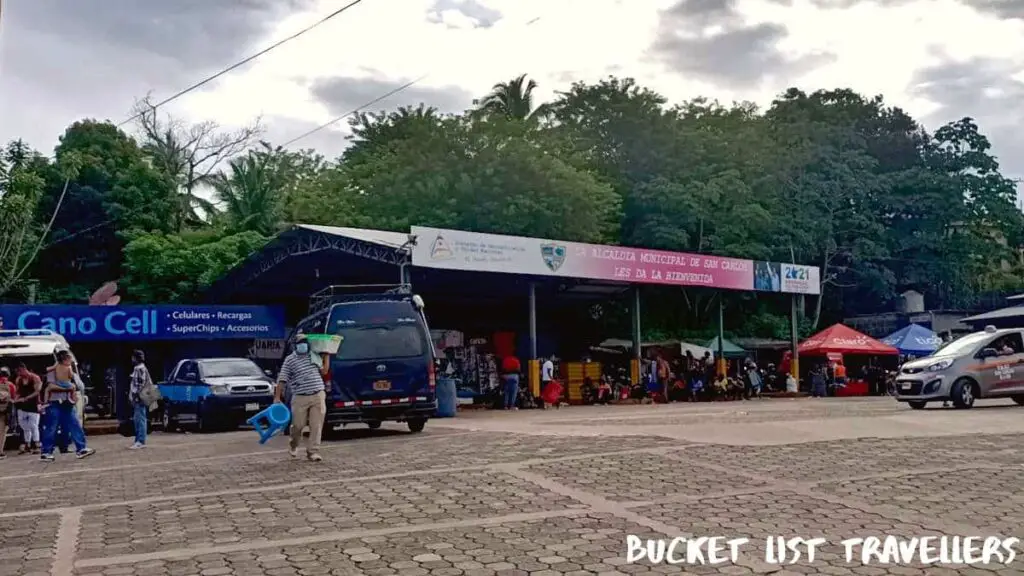
You can get to San Carlos from Managua by bus. This journey is around 280km and will take around 8 hours.
Getting to San Carlos from Granada by ferry
There are ferries from Granada to San Carlos via Ometepe Island . These ferries recommenced in October 2021 after being suspended for several years due to low water levels in Lake Nicaragua. The ferry between Granada and San Carlos runs once a week in each direction.
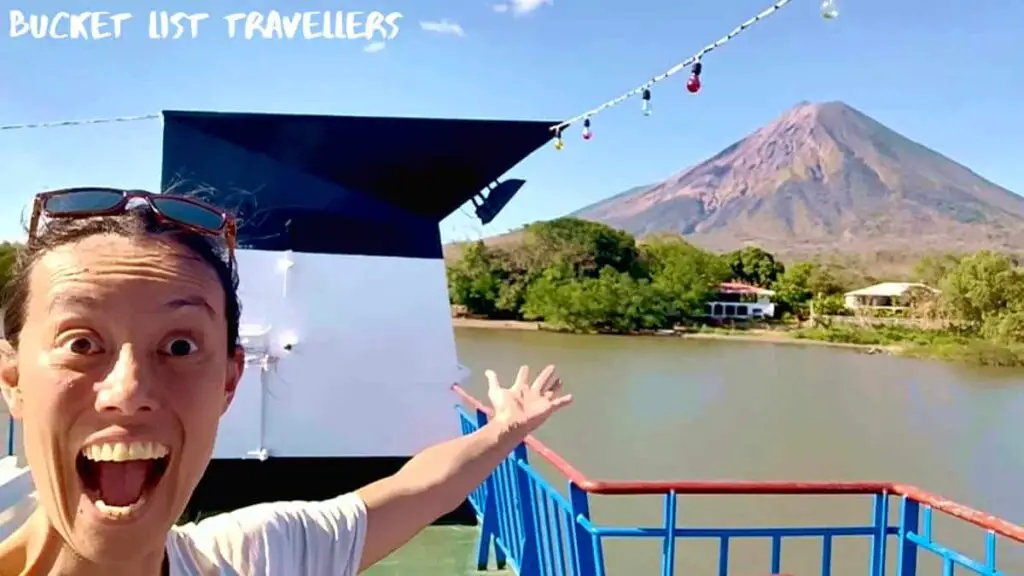
Getting to San Carlos from Granada by bus
From Granada you can also get to San Carlos by taking a few local buses. The buses you will need are:
- Granada to Masaya
- Masaya to Tipitapa
- Tipitapa to San Carlos
We slowly travelled along this journey by bus over the space of 2 weeks stopping at Boaco, Camoapa and Juigalpa along the way. Each leg of the journey took between 1-4 hours. This is a less visited part of the country but there are some lovely spots along the way. To see a different side of Nicaragua , we highly recommend taking some time to explore this part of the country.
How to get from San Carlos to the San Pancho border crossing
To get to the border from San Carlos, there are a number of different options:
- Bus to San Pancho
- Take a boat down the Rio Frio to San Pancho
- Catch a lancha boats to Santa Fe bridge and then catch a micro bus to San Pancho
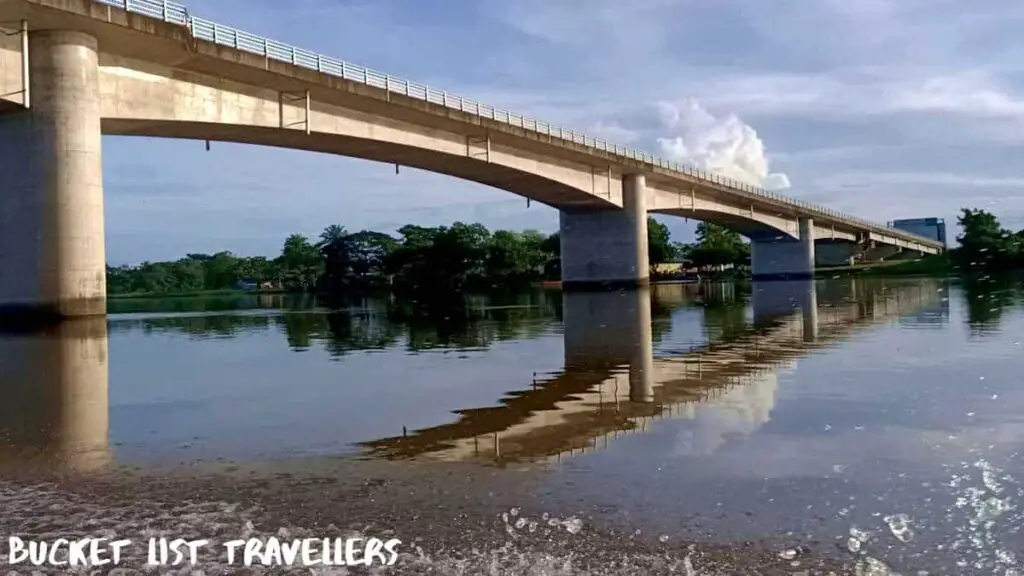
How to get from the San Pancho border crossing to Los Chiles Costa Rica by bus
Once you cross the border into Costa Rica at San Pancho there is a bus stop just across the road from border control. Buses to the nearby border town of Los Chiles leave from this bus stop. The bus ride takes about 10 minutes and costs 275 colones per person. There are people that will exchange money for you at the border. We asked the bus driver and he pointed us to a person that was able to exchange money for us.
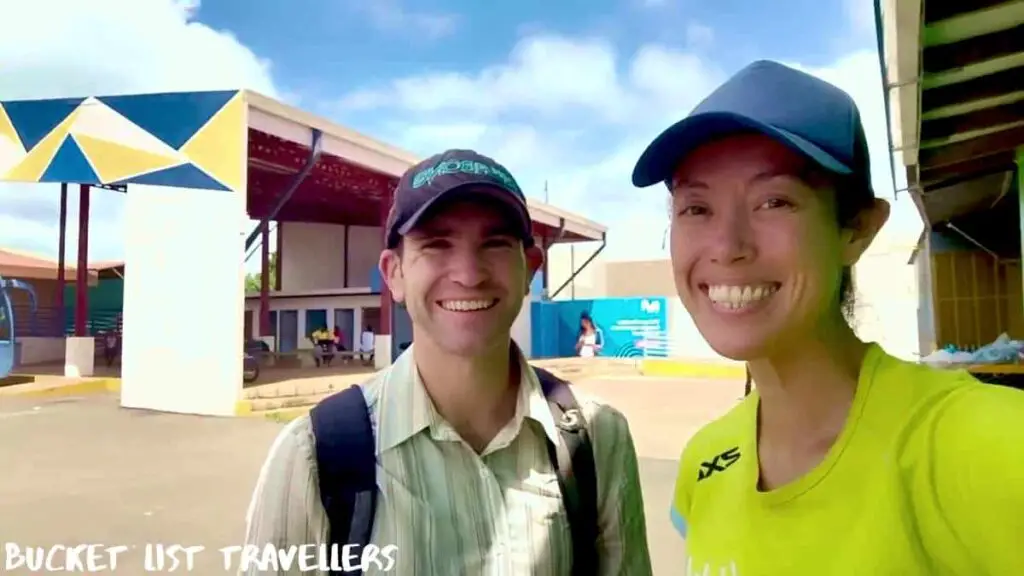
How to get from the San Pancho border crossing to other parts of Costa Rica
The bus from the border at San Pacho also goes to Ciudad Quesada. This is a major major city in Costa Rica and from here you can get buses to La Fortuna, San Jose and other parts of Costa Rica.
Our experience: San Pancho-Los Chiles border crossing from El Castillo
We decided to spend a few days at El Castillo on Rio San Juan before doing the border crossing. El Castillo is a 2-3 hour lancha boat ride from San Carlos along Rio San Juan.
Lancha from El Castillo to Sante Fe bridge and microbus to San Pancho
From El Castillo we took the 5am lancha to the Sante Fe bridge and a microbus from there to the border crossing at San Pancho. We did the border crossing on a Sunday and the other lancha times from El Castillo that day were at 9am and 1pm. Only slow lanchas operate on weekends, which means more stops along Rio San Juan. The full trip from El Castillo to the port at San Carlos takes 3 hours rather than 2 hours. Santa Fe is around half an hour before San Carlos if you are coming from El Castillo . There are a couple more lanchas on weekdays.
The ferry from El Castillo to Puente Santa Fe cost 100 cordobas each and the microbus from Santa Fe to San Pancho cost 50 cordobas each (prices as at August 2021).
Police checkpoint at Santa Fe bridge
There is a police check point just after the Santa Fe bridge. As such, once the microbus crosses the bridge everyone has to get out of the microbus and walk over to a tent to go through the police check point. For us this took around 10 minutes. The police asked us to show us the contents of some of our bags, they looked through our passport and asked us a few questions about where we were from and where we were going. If you are catching the microbus from Puente Sante Fe it might be easier to just walk over the bridge and go through the police checkpoint before catching the microbus.
Arriving at San Pancho Nicaragua
As the microsbus approaches the San Pancho border, they will make 2 stops. The first stop is for people crossing the border illegally and the second stop is for people crossing the border legally.
Exiting Nicaragua overland
After getting out of the microbus at San Pancho, we were greeted with hundreds of people waiting to get in at the border. The border control building was a large white building that appeared to be newly built. The road leading up to it was yet to be constructed and was a muddy dirt path. We joined the queue outside border control, anticipating that the next few hours would be a long wait.
A few minutes passed, and we decided to check with a border official to make sure we were in the right line. Fortunately for us, he lead us to a much shorter line which only had a few people in it. Even better, we were able to get into the air-conditioned building rather than standing outside in the heat of the day. Within about five minutes we paid our $3 USD exit fee each, our passports were processed and it was time to leave Nicaragua.
Entering Costa Rica overland
After exiting Nicaragua, we moved on to no mans land in between Nicaragua and Costa Rica. From there it was a short walk to the Costa Rica border control buidling. There was only one person in the queue ahead of us. Once we got to the front of the queue we handed over our passports, showed our QR codes and answered a few questions about our travel plans. Our passports got stamped and we were officially in Costa Rica.
Bus to Los Chiles Costa Rica from the Costa Rica border
Our first stop in Costa Rica was Los Chiles. The bus stop was just across the road from the Costa Rica border control building. We walked over to the bus stop and there was a bus there waiting for us. We had to pay the bus fare in the local currency colones and the bus driver pointed us to a man nearby who was able to exchange our remaining Nicaragua cordobas for colones. It was a very comfortable ride to Los Chiles and we were impressed with the condition of the buses in Costa Rica. The bus took about 10 minutes to reach Los Chiles and we paid 275 colones per person for the bus fare. The same bus continued on to Ciudad Quesada, which is a major transport hub with buses to La Fortuna, San Jose and other parts of Costa Rica.
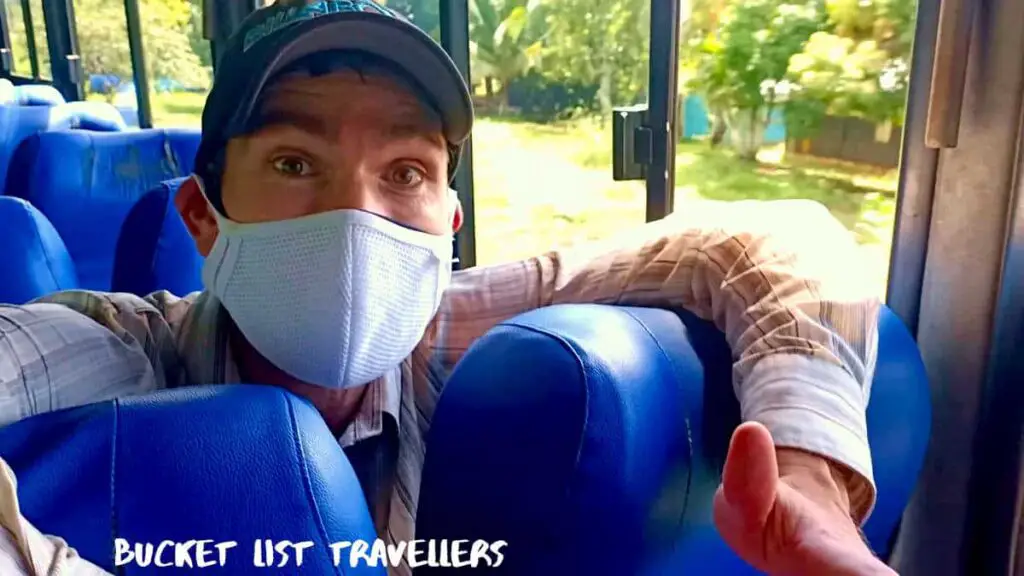
Where to stay when doing the Nicaragua-Costa Rica border crossing at San Pancho-Los Chiles
We recommend the following low to mid budget accommodation near the San Pancho border crossing:
Where to stay in San Carlos Nicaragua
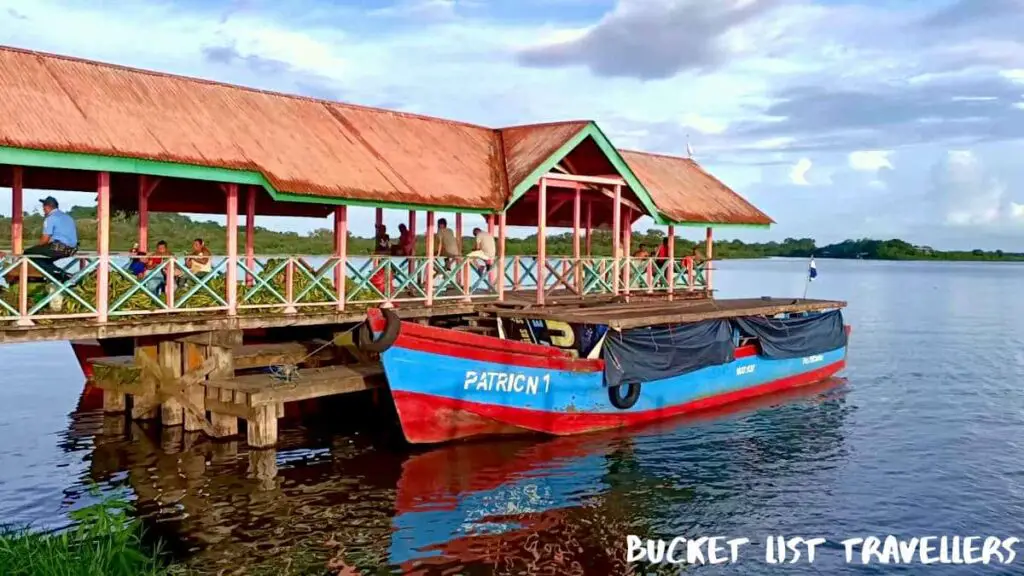
San Carlos is a vibrant lakeside town on the banks of Lake Nicaragua. The malecon area is a beautiful place to watch the sun set and see views of Ometepe Island .
For comfortable low budget accommodation, we recommend Hotel Gran Lago. Expect to pay around 700 cordobas per room for a couple.
Where to stay in El Castillo Nicaragua
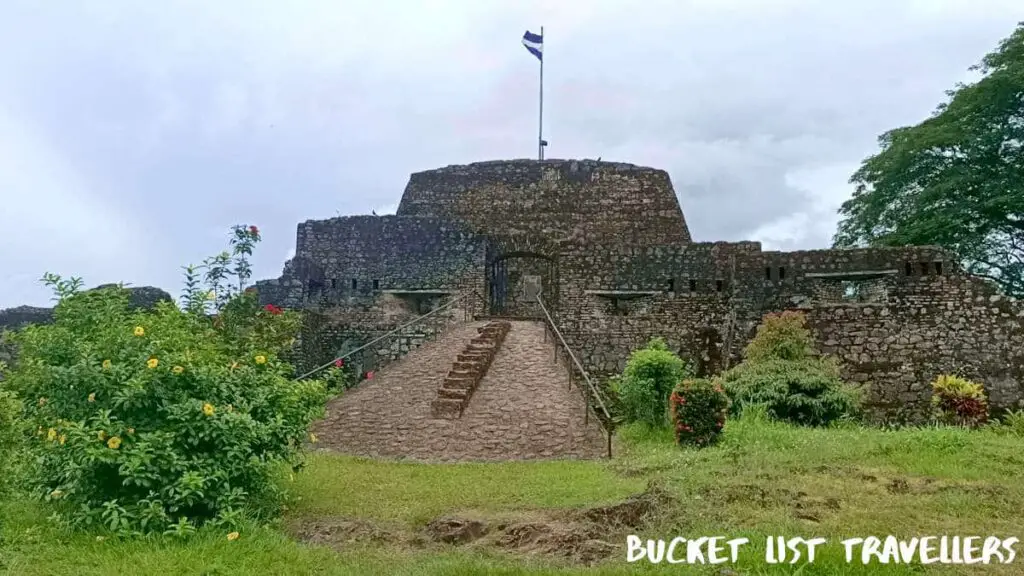
El Castillo is a sleepy riverside town with plenty of history and natural beauty. An impressive fort towers over the town and has a lot of interesting history. The all day boat tour of the nature reserve Indio Maiz was one of the best tours we did in Nicaragua .
For a comfortable mid budget accommodation we recommend Hotel Victoria. Expect to pay between $40-$60 per night per couple including breakfast.
Where to stay in Los Chiles Costa Rica
Los Chiles is the border town in Costa Rica . There are a few nice restaurants and accommodation options in town. The main attraction is the nature reserve Caño Negro. You can hire a boat to take you down the river on a wildlife spotting tour for around $100 for 2 hours. This will cover the cost of the boat and the captain. We saw plenty of wildlife on this tour including 3 toed sloths, birds, an alligator and various types of monkeys.
While staying in Los Chiles we recommend staying at Hotel Heliconia. It’s conveniently located a short walk from the bus terminal and from the main part of the town. Rooms are comfortable and reasonably priced. Expect to pay around 25,000 colones for a room for a couple including breakfast or 18,000 colones excluding breakfast.
Is the Nicaragua-Costa Rica border crossing safe?
General safety considerations for travel near the Nicaragua-Costa Rica Border:
- Drinking water – The tap water on the Nicaragua side of the Border Crossing is not safe to drink. Hotels may provide bottled water for guests to use. The taps water on the Costa Rica side of the border is safe to drink
- Mosquitoes – we did not have an issue with mosquitoes in the area around the border crossing. Nevertheless, we recommend bringing insect repellent with you on your trip
- Road safety – We often travelled standing up in the back of vans or in vehicles without helmets or seat belts. Be aware that this does come with an element of risk
- Water safety – If you visit any of the coastal areas or lakes, take care when swimming as currents and waves may be stronger than you expect. On lanchas and boats life vests are provided
- Sun safety – The UV Index is very high in Central America . Sun protection such as sunscreen, a hat and sunglasses is very important to ensure you don’t get burnt.
- Dogs – In many countries in Central America , stray dogs are common. For more on dog safety while travelling, check out this video .
As with any destination, take all of your normal safety precautions.
Visas in Nicaragua: The CA4-90 day visa
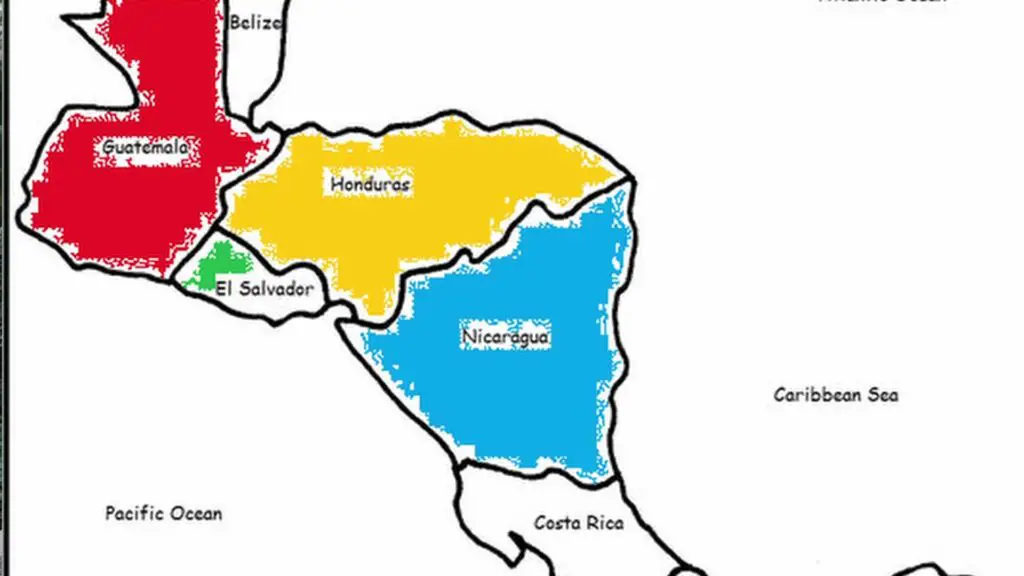
If you’re visiting Nicaragua, you will probably be on a CA-90 day visa. Tourists on the CA4-90 day visa are permitted entry to the CA4 countries for a period of 90 days. The CA4 countries are Nicaragua , Honduras, El Salvador and Guatemala . After the initial 90 days, 30 day visa extensions may be granted up to a maximum of 90 additional days. We have also heard of some people being granted getting 60 day or 90 day visa extensions, which means less trips back to the immigration office for renewals. This is not standard practice at the moment, but it doesn’t hurt to ask.
It is reasonably common for perpetual tourists to do border runs between Nicaragua and Costa Rica every 90 days in order to reset their 90 day visas. Technically you are supposed to leave Nicaragua for at least 3 days in order to get another 90 day visa. However we have heard of people crossing the border and then returning in the same day.
How to get visa extensions in Nicaragua
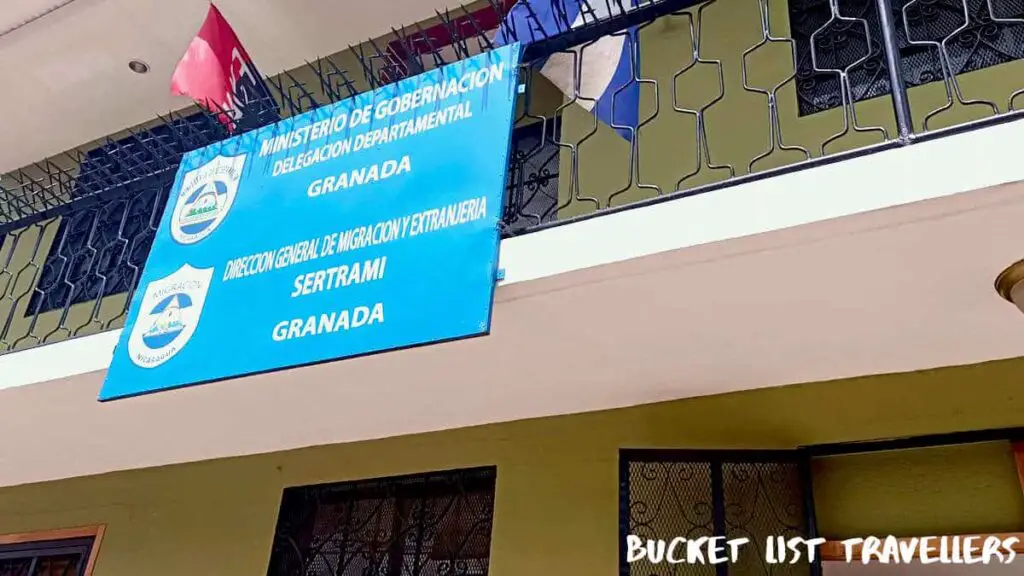
Rather than doing a time consuming visa run, it may be possible to get a visa extension in Nicaragua. Visa extensions can be done at the immigration office in most major cities in Nicaragua . As at 2022 a 30 day visa extension costs $25 US plus 5 cordobas for the form. We have successfully renewed our visas in the immigration offices at Granada , Rivas, Estelí as well as the head office in Managua. Additionally, we tried to renew our visas in Ocotal, but they would not renew our visas at that office and instead sent us to Managua.
Same day visa renewals at Managua Nicaragua
Visa extension applications submitted at the head office in Managua are processed on the same day. The visa renewal application and approval process usually takes 1-2 hours.
Visa renewals in cities outside Managua Nicaragua
Regardless of where you submit your application for a visa renewal, all Nicaragua visa renewals are processed in the head office in Managua. You can apply for a visa extension in other cities in Nicaragua , however your passport will still need to be sent to the head office in Managua for processing. This process can take up to 2 weeks but is typically 5-6 business days. While your visa is being processed you will not have possession of your passport. You will also need to pay an extra 50 cordobas for postage.
Where are the immigration offices in Nicaragua?
An interactive map with the addresses and opening hours of immigration offices in Nicaragua can be found on this website . Most tourists get visa extensions in Managua head office, Granada or Rivas. One complicating factor is that addresses in Nicaragua can be difficult to understand. They are expressed not with street numbers but in relation to major landmarks. Below are the official address, our translation, the Google maps name of the location and the Plus code you can use in Google maps for the exact location.
Location of Managua Nicaragua immigration head office
Official address for immigration head office in Managua Nicaragua: Semáforos de la Tenderí 300 metros al lago. (This means it’s at the traffic lights 300 metres from the lake).
Google maps name for immigration head office in Managua Nicaragua: Directorate General of Immigration and Nationality.
Plus code for Google maps location of immigration head office in Managua Nicaragua: 4PXX+6PP, Avenida Xolotlan, Managua, Nicaragua.
Location of Granada Nicaragua immigration office
Official address for immigration office in Granada Nicaragua : De la capilla María Auxiliadora media Cuadra abajo Calle Real Xalteva. (This means it’s half a block below the Maria Auxiliador church on Calle Real Xalteva).
Google maps name for immigration office in Granada Nicaragua: Ministerio de Migración.
Plus code for Google maps location of immigration office in Granada Nicaragua: W2QV+4QR, Calle Atravesada, Granada, Nicaragua.
Location of Rivas Nicaragua immigration office
Official address for immigration office in Rivas Nicaragua: De la rotonda Jesús del Rescate 1/2 cuadra al sur. (This means it’s half a block south of the Jesús del Rescate roundabout).
Google maps name for immigration office in Rivas Nicaragua: Migration Nicaragua.
Plus code for Google maps location of immigration office in Rivas Nicaragua: C5VF+CH8, Rivas, Nicaragua.
What are the opening hours of immigration office in Nicaragua?
Most immigration offices in Nicaragua open from 8am-5pm Monday to Saturday. The immigration offices in Managua also open on Sundays from 10am-1pm.
Requirements for visa extensions in Nicaragua

We have applied for visa extensions in Granada , Rivas, Managua, Esteli and Ocotal. The requirements for getting a visa extension can vary depending on the immigration officer that processes your application.
The Ocotal office did not process our visa extension application. They sent us back to the head office in Managua. We have heard of someone having a similar experience in Matagalpa.
Requirements for visa renewals in Nicaragua
From our experience you need to provide the following in order to get a visa extension in Nicaragua :
- Your passport
- A photocopy of the front page of your passport. This is the page with your photo and personal details
- A photocopy of the most recent visa stamp for Nicaragua . This is either the most recent visa extension stamp or the entry stamp if this is your first visa extension in Nicaragua
- Some offices may also require a photocopy of your initial entry stamp for the CA4-90 day visa
- Some offices may also require proof of accommodation. Proof may be in the form of a photocopy of the receipt from your accommodation. It should include the cedula number of the owner of the accommodation. If you are in a couple or family you may need a separate photocopy of your receipt for each person applying for a visa extension
- Some offices may question you about your income, your travel plans and how much you pay for your accommodation
A basic level of Spanish will be very helpful in going through this process. The immigration officers may only speak Spanish and all of the forms are in Spanish. Google Translate helped us a lot in navigating this process.
Applying for a visa extension in Managua Nicaragua
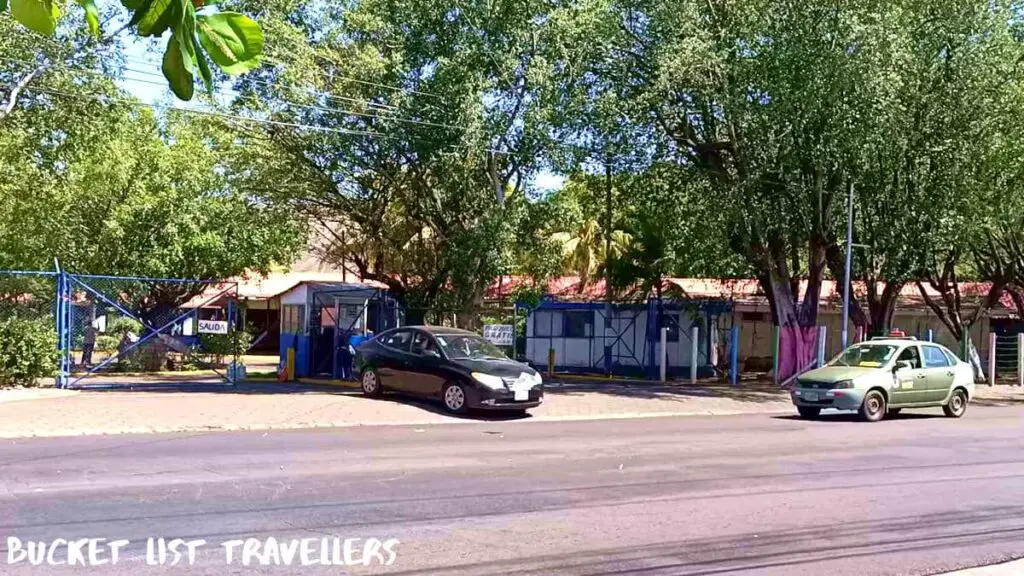
For most immigration offices in Nicaragua , the one immigration officer will process your visa extension application from start to finish. However the process is different in Managua. In Managua there are a few different queues you need to line up in. This is because different people process different parts of the application. This process is a bit more complicated, but the steps are:
- Buy the form for 5 cordobas. This is from one of the windows in the middle of the room. Window 21 if memory serves me correctly
- Fill out the form
- Go to the front desk so that they can check your forms and give you a number
- Sit in the waiting area just in front of the front desk and wait for your number to be called. This will be in Spanish, but sometimes there is a television screen at the front displaying the ticket number and the window where that ticket is currently being processed
- Once your number is called, go to the relevant window. Hand in your paperwork and answer any questions that they have
- Go back to window 21 to pay the $25 USD for the visa extension. You will get 2 receipts – one for you and one that you need to hand in
- Go back to the window that processed you and hand in the receipt for them
- Go and sit back down and wait for your visa extension to be processed
- Once they call your name, go back to the window that processed your visa application. They will show you the stamp with your new exit date. You will need to either apply for a visa extension on that date or leave Nicaragua by that date
Final thoughts on the Nicaragua-Costa Rica border crossing
If you want to learn more about the Nicaragua-Costa Rica Border Crossing, check out our Nicaragua-Costa Rica Border Crossing video .
Costa Rica Blogs
You can find out Costa Rica travel blogs below.

Nicaragua Blogs
You can find our Nicaragua blogs below.
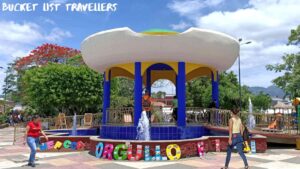
Esteli Nicaragua Destination Guide (2024): What You Need to Know
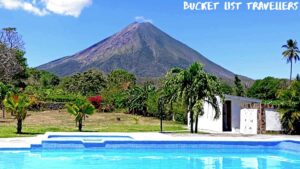
Ometepe Island Nicaragua Destination Guide (2024): What You Need to Know
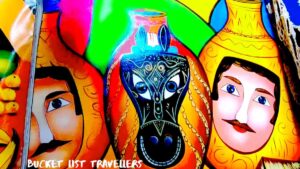
Masaya Nicaragua Destination Guide (2024): What You Need to Know

San Juan del Sur Nicaragua Destination Guide (2024): What You Need to Know
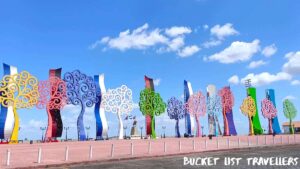
Managua Nicaragua Destination Guide (2024): What You Need to Know

Leon Nicaragua Destination Guide (2024): What You Need to Know
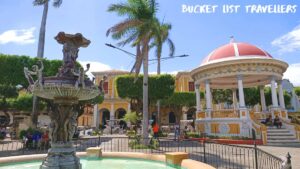
Granada Nicaragua Destination Guide (2024): What You Need to Know
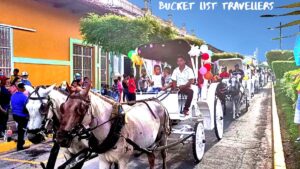
Transport in Nicaragua – Complete Guide to Nicaragua Transportation (2024)

Where should I live in Nicaragua?
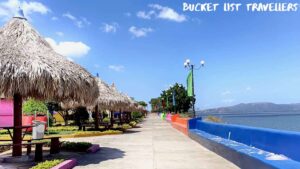
Top 5 Things to do in Managua Nicaragua (2024)
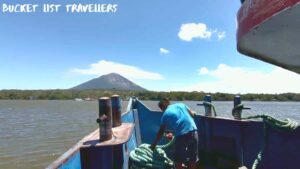
Granada Ferry: How to get to Ometepe Island


Home Invasion in Granada Nicaragua

Ojo de Agua: Paradise in Nicaragua!
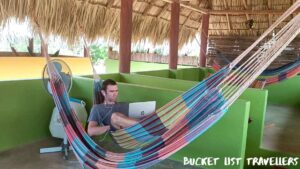
How Good is the Internet in Nicaragua?
Affiliate links.
This website contains affiliate links, which means we may earn a commission on any purchases at no additional cost to you. Your support helps us continue our travels and make more travel blogs and travel videos , thank you!
Similar Posts
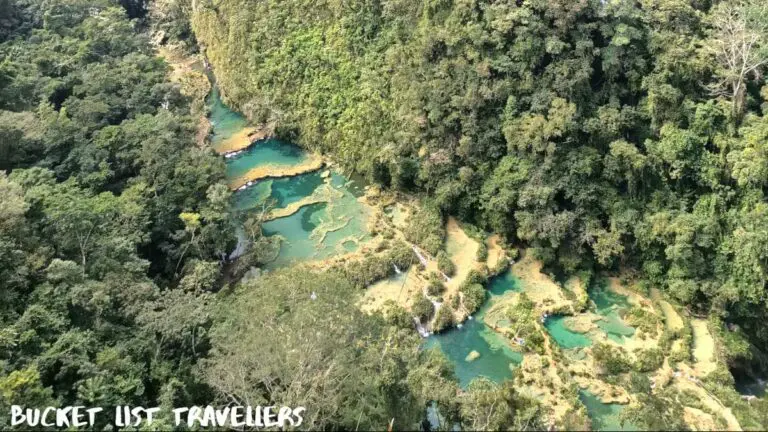
Semuc Champey Guatemala: A Hidden Oasis
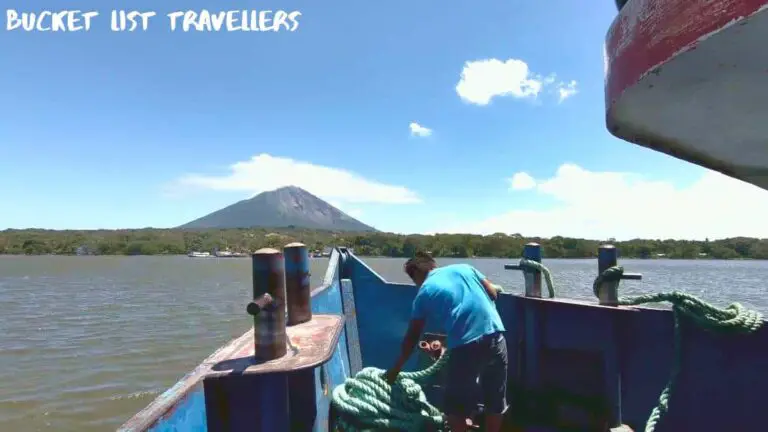
Top 5 Things to do in Antigua Guatemala
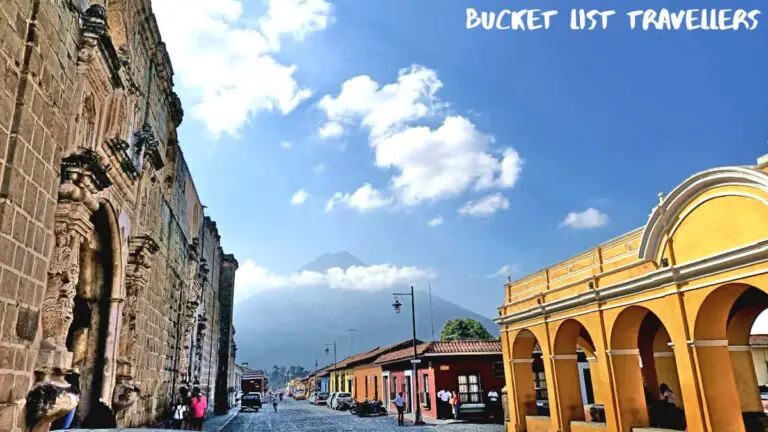
Why you need to visit Guatemala right now!
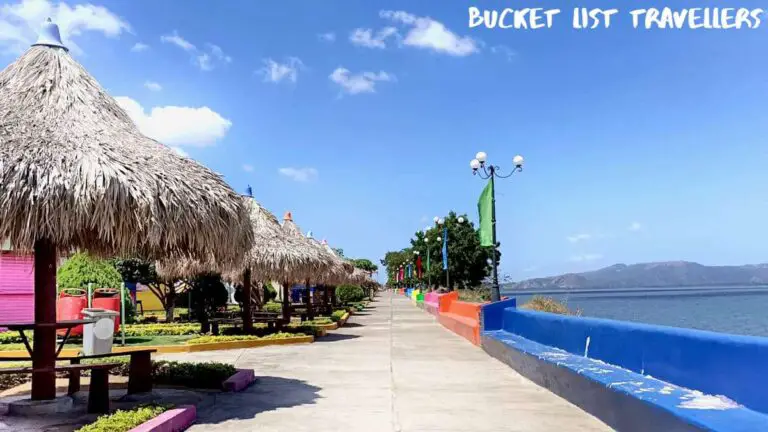
How to Get Money in Nicaragua
Leave a reply cancel reply.
Your email address will not be published. Required fields are marked *
Save my name, email, and website in this browser for the next time I comment.

We’re sorry, this site is currently experiencing technical difficulties. Please try again in a few moments. Exception: request blocked
Update April 12, 2024
Information for u.s. citizens in the middle east.
- Travel Advisories |
- Contact Us |
- MyTravelGov |
Find U.S. Embassies & Consulates
Travel.state.gov, congressional liaison, special issuance agency, u.s. passports, international travel, intercountry adoption, international parental child abduction, records and authentications, popular links, travel advisories, mytravelgov, stay connected, legal resources, legal information, info for u.s. law enforcement, replace or certify documents.
Before You Go
Learn About Your Destination
While Abroad
Emergencies
Share this page:
Travel Advisory January 11, 2024
Nicaragua - level 3: reconsider travel.
Reissued with updates to information on arbitrary enforcement of laws.
Reconsider travel to Nicaragua due to arbitrary enforcement of laws, the risk of wrongful detention, and limited healthcare availability . Exercise increased caution in Nicaragua due to crime.
Country Summary : Throughout Nicaragua, government and law enforcement officials continue to target individuals and organizations seen as opponents of President Daniel Ortega and his wife, Vice President Rosario Murillo. U.S. citizens, including dual Nicaraguan-U.S. citizens, have been subject to revocation of Nicaraguan citizenship, reentry bans, expulsion, and other actions. The government and its affiliated groups have been reported to:
- Arbitrarily prevent individuals from entering or departing Nicaragua by air or land for perceived associations.
- Search personal phones, computers, and documents for anti-government content, limit photography of government property, and sometimes seize devices.
- Systematically target individuals for political reasons, regardless of nationality, including former allies, political activists, business representatives, clergy, human rights advocates, civil society leaders, academics, and members of the press.
- Arbitrarily target pro-democracy advocates and their family members.
- Confiscate privately-owned land, residences, financial assets, and personal property without warning or due process.
- Arbitrarily detain, accuse, and charge individuals with terrorism, money laundering, and organized crime offenses for political reasons without respect for fair trial guarantees.
U.S. citizen residents of Nicaragua also report increased scrutiny of alleged political speech.
U.S. citizens arrested in Nicaragua may find themselves subject to prolonged detention without charges or respect of fair trial guarantees. The judicial process lacks transparency, especially in politically motivated arrests and property dispute cases. Political influence and pressure may influence the outcome of legal proceedings.
The Department has determined the risk of wrongful detention of U.S. nationals by the Government of Nicaragua exists.
Travelers should exercise increased caution and be alert to the risks of crime, including violent crimes such as sexual assault and armed robbery.
Poor infrastructure in parts of the country limits the Embassy’s ability to assist U.S. citizens in emergencies. U.S. government personnel under Chief of Mission security responsibility may be subject to restrictions on their movements at any time.
Read the country information page for additional information on travel to Nicaragua.
If you decide to travel to Nicaragua:
- Consider arrangements to depart the country quickly.
- Ensure your U.S. passport is valid and available for a quick departure from the country, if needed.
- Avoid demonstrations and restrict unnecessary travel.
- Do not attempt to drive through crowds, barricades, or roadblocks.
- Maintain adequate supplies of food, cash, potable water, and fuel in case you need to shelter in place.
- Use caution when walking or driving at night.
- Keep a low profile.
- Do not display signs of wealth such as expensive watches or jewelry.
- Be aware of your surroundings.
- Visit our website for Travel to High-Risk Areas .
- Enroll in the Smart Traveler Enrollment Program ( STEP ) to receive Alerts and make it easier to locate you in an emergency.
- Follow the Department of State on Facebook and Twitter .
- Review the Country Security Report for Nicaragua.
- Prepare a contingency plan for emergency situations. Review the Traveler’s Checklist .
- Visit the CDC page for the latest Travel Health Information related to your travel.
Embassy Messages
View Alerts and Messages Archive
Quick Facts
Length of stay.
One page per stamp.
No (90 days or fewer). Tourist card at airport. See Entry, Exit & Visa Requirements below.
Yellow fever (in some cases, see Entry Requirements section).
Must declare $10,000 USD or more in cash.
Embassies and Consulates
U.S. Embassy Managua
Km 5 ½ Carretera Sur Managua, Nicaragua Telephone: +(505) 2252-7100 Emergency After-Hours Telephone: +(505) 2252-7100 Fax: +(505) 2252-7250 Email: [email protected]
Email: [email protected]
Destination Description
Learn about the U.S. relationship to countries around the world.
Entry, Exit and Visa Requirements
The Government of Nicaragua has denied entry to or expelled U.S. citizens, including dual U.S.-Nicaraguan citizens, for political reasons including perceived support for or association with disfavored people or organizations. The Government’s actions have been taken against NGO workers, academics, religious workers, journalists, and many others. The Nicaraguan government has revoked residency status for foreign nationals for actions or expressions it perceives as political. Travelers attempting to leave the country have been arrested or denied permission to travel for political reasons. Immigration authorities regularly review social media for evidence of political expression or activity and warn against such activities.
- For visitors other than tourists , the Government of Nicaragua recommends that you pre-register your trip by following the instructions available on the Nicaraguan immigration website (in Spanish only). See our website for additional information.
- All travelers should have an onward or return ticket and evidence of funds to support yourself while in Nicaragua. You must carry a valid identity document at all times, such as a U.S. driver’s license or U.S. passport.
- You must purchase a tourist card for $10 USD at the airport (exact change recommended), valid for up to a total of 90 days in any of the member countries of the Central America-4 Border Control Agreement . Visitors remaining longer must obtain an extension from Nicaraguan immigration or be subject to large fines.
- Individuals traveling from countries at risk of yellow fever transmission must show proof of yellow fever vaccination administered at least 10 days before travel to be permitted entry to Nicaragua.
- If you use a passport of a different nationality than you did on prior trips to Nicaragua, Nicaraguan authorities may deny you entry. If you possess multiple nationalities, you should carry a valid passport for all of them. If you have Nicaraguan nationality, you should have both your U.S. and Nicaraguan passports with you.
- You must exit Nicaragua with the same passport used for entry . If your U.S. passport is lost or stolen while in Nicaragua, you will need to get a new entry stamp from Nicaraguan Immigration before you can depart by following instructions available on the Nicaraguan immigration website (in Spanish only). This cannot be done at the airport on departure.
- There is a $42 USD tax that must be paid upon exiting (this tax is normally included in the price of the plane ticket for air travelers).
- See the U.S. Embassy website for information regarding departure requirements for children under 18 who also are Nicaraguan citizens .
- Nicaraguan government authorities may search personal phones, computers, and documents for anti-government content and sometimes seize such private property. Equipment such as binoculars, drones, or other items will generally be confiscated without a mechanism to retrieve these items later.
Advanced Coordination Required for Volunteer Groups: Please note that the Government of Nicaragua has forced the closure of more than 3,500 NGOs and charitable organizations. Groups engaged in these types of activities, including the apolitical provision of basic services, may be denied entry. You should email both the Embassy of Nicaragua in the United States ( [email protected] ) and the Nicaraguan Ministry of Foreign Affairs ( [email protected] ) to inform them of your trip and secure advance permission if you are leading one of the following types of trips, even if your group has worked in Nicaragua previously or has a local office:
- Volunteer mission;
- Charitable or medical brigade (the latter also need permission from the Nicaraguan Ministry of Health); or
- Assistance visit organized by NGOs, religious groups, schools, or any other group doing this type of work in Nicaragua.
For the latest visa and entry requirements, visit the Nicaraguan immigration website (Spanish only).
HIV/AIDS Restrictions: The U.S. Department of State is unaware of any HIV/AIDS entry restrictions for visitors or foreign residents in Nicaragua.
Dual Nationality and International Parental Child Abduction : Find information on dual nationality , prevention of international child abduction , and customs regulations on our websites.
COVID-19 Information: As of July 21, 2023, the Nicaraguan government lifted all COVID-19 related travel restrictions. Travelers arriving in Nicaragua do not need to provide proof of vaccination or a negative COVID-19 test.
Safety and Security
The Government of Nicaragua is authoritarian, limits freedom of expression and peaceful assembly, represses internal dissent, and monitors and responds to perceived threats to its authority. Nicaragua’s Sovereign Security Law and its Terrorism and Money Laundering law allow for discretionary interpretation of often vaguely defined unlawful activities, such as threatening the peace and economic stability of Nicaragua. Convictions under these laws have often been arbitrary and result in long prison sentences.
Nicaraguan authorities and armed civilians in plain clothes known as “para police” may monitor, detain, deny entry to, expel, or question U.S. citizens concerning their activities, including their contact with Nicaraguan citizens. Visitors should avoid any commentary on Nicaraguan politics or governance. Nicaraguan authorities have subjected U.S. citizens, including dual U.S.-Nicaraguan citizens, to prolonged detentions which are often politically motivated or arbitrary. Especially in politically motivated arrests, the judicial process has regularly been criticized as neither fair nor transparent.
Demonstrations or strikes may occur throughout the country; in the past, the Nicaraguan government has violently suppressed them. Avoid demonstrations and exercise extreme caution around large gatherings.
Roads may be closed, and public transportation may be disrupted due to large crowds celebrating the following holidays:
- Semana Santa (the week before Easter);
- Repliegue Historico a Masaya (early July);
- July 19 celebration of the Sandinista Revolution;
- Celebration in Managua of Santo Domingo, the Patron Saint of the city (August 1st and August 10th);
- Day of the Nicaraguan Army (September 2);
- Nicaraguan Independence Day (September 14 and 15); and
- Immaculate Conception (December 8).
Crime: Vehicle burglaries, pick-pocketing, and occasional armed robberies occur in store parking lots, on public transportation, and in open-air markets like the Oriental and Huembes Markets in Managua. Petty street crime is common. Police presence is extremely limited outside of major urban areas. The Caribbean Coast’s geographical isolation further limits the U.S. Embassy’s ability to provide emergency services to U.S. citizens living in or visiting the area. Uniformed police and para-police commit violence and intimidate civilians throughout the country for political reasons.
U.S. citizens have been sexually assaulted in beach resort areas. There are no forensic doctors on the Corn Islands , so victims of violent crimes, including sexual assault, must travel to Bluefields at their own expense for medical examinations and collection of evidence. In several recent cases, police were reluctant to produce police reports or pursue charges . Please report such incidents to the Embassy.
Medical services outside Managua are limited, including for victims of crime.
Exercise extreme caution when renting or driving vehicles. In one common scam, “Good Samaritans” pull over to help change a flat tire. While the driver is distracted, an accomplice steals the driver’s possessions.
Due to crime and other illicit activity, U.S. government personnel under Chief of Mission security responsibility are prohibited from entering Managua’s Oriental Market and gentlemen’s clubs throughout the country.
International Financial Scams: See the Department of State and the FBI page for information.
Victims of Crime: Report crimes, including sexual assault, to the local police at 118 (Nicaraguan equivalent of “911,” in Spanish). Report serious crimes to the U.S. Embassy at 2252-7100 immediately and minor crimes during business hours.
Local authorities are responsible for investigating and prosecuting crimes.
See our webpage on help for U.S. victims of crime overseas .
The U.S. Embassy can:
- Help you find appropriate medical care.
- Assist you in reporting a crime to the police.
- Contact relatives or friends with your written consent.
- Provide a list of local attorneys.
- Share information on victim’s compensation programs in the United States .
- Provide an emergency loan for repatriation to the United States and/or, limited financial support in cases of destitution.
- Help you find accommodation and flights home.
- Replace a stolen or lost passport.
Domestic Violence: U.S. citizen victims of domestic violence are encouraged to contact the U.S. Embassy for assistance.
Coastal Disputes: Be aware of the following border disputes:
- Nicaragua and Colombia have an ongoing dispute over waters surrounding the San Andres Islands.
- The Nicaraguan Navy has challenged vessels passing through its exclusive economic zone.
- Nicaragua and Costa Rica have stationed security forces at Harbor Head (also called Isla Calero) at the eastern end of the San Juan River.
- Nicaragua, Honduras, and El Salvador have maritime and land disputes over islands and access to fishing rights in the Gulf of Fonseca on the Pacific Coast, a closed sea under international law.
Tourism: The tourism industry is unevenly regulated, and safety inspections for equipment and facilities are uncommon. Hazardous areas/activities are not always identified with appropriate signage, and staff may not be trained or certified. In the event of an injury, appropriate medical treatment is typically available only in major cities. In the event of a diving injury, the only hyperbaric chamber is in Puerto Cabezas, over 100 miles from Corn Island where most tourists dive. U.S. citizens are encouraged to purchase medical evacuation insurance. See our webpage for more information on insurance providers for overseas coverage .
Beach Safety: Exercise caution at the beach. U.S. citizens have drowned at Nicaraguan beaches, and in lagoons and lakes. Warning signs are not always posted. Lifeguards and rescue equipment are not normally available.
Hiking in volcanic or remote areas is dangerous. Wear appropriate clothing and footwear. Carry sufficient food, water, and communication equipment. If you travel to remote areas, hire a reputable local guide. Nicaraguan law requires tourists hire a local guide for several volcanoes, including the two volcanoes on Ometepe Island (Maderas and Concepcion).
Disaster Preparedness: Nicaragua is prone to earthquakes, hurricanes, floods, and volcanic eruptions. If you are at a coastal area when an earthquake occurs, move swiftly to higher ground (when safe to do so) to avoid possible tsunamis.
In the event of an earthquake, volcanic eruption, or other natural disaster, U.S. citizens should pay close attention to local media reports.
- Follow the guidance of local authorities and monitor the websites of the Nicaraguan Institute for Territorial Studies ( INETER ) and the Nicaraguan Emergency Alert System ( SINAPRED ).
- Enroll in the Smart Traveler Enrollment Program (STEP) to receive important emergency information.
- See the U.S. Federal Emergency Management Agency (FEMA) website for information about disaster preparedness.
Local Laws & Special Circumstances
Criminal Penalties: You are subject to local laws. If you violate local laws, even unknowingly, you may be expelled, arrested, or imprisoned. Furthermore, some crimes are also prosecutable in the United States, regardless of local law. For examples, see our website on crimes against minors abroad and the Department of Justice website.
- Penalties for possessing, using, or trafficking in illegal drugs in Nicaragua are severe, even for possession of small amounts of illegal drugs.
- Even with a prescription, marijuana is illegal in Nicaragua.
There are severe penalties, including imprisonment, for domestic violence, psychological abuse, and non-payment of child support.
Arrest Notification: Nicaraguan authorities do not always notify the U.S. Embassy when a U.S. citizen has been arrested or detained, especially if the arrestee has dual nationality. If you are arrested or detained, ask both police and prison officials and friends or family to notify the U.S. Embassy. After the U.S. Embassy learns of an arrest, it may be several days or weeks before the Government of Nicaragua permits a consular official to visit. In the case of dual U.S.-Nicaraguan nationals, the U.S. Embassy may be denied consular access. See our webpage for further information.
- The judiciary does not enjoy independence from political influence. U.S. citizens who have been arrested in Nicaragua may find themselves subject to prolonged detention without charges, often for political reasons.
- Authorities have ignored or significantly delayed implementing judicial orders to release, deport, expel, or transfer prisoners.
Purchasing Property: Exercise extreme caution before investing in property. The Nicaraguan government may confiscate privately owned land or residences without warning or compensation. Armed individuals have taken over privately owned land. U.S. citizens have been arrested or threatened over property disputes. See our website for more information.
Customs Regulations: U.S. citizens planning to import items should contract a recognized local customs broker for assistance well in advance of their visit. The U.S. Embassy is unable to assist with the customs or import process.
- Nicaraguan customs officials may delay or block import of goods, including items intended for donation.
- If you are planning to bring vehicles or household goods, consult Nicaraguan customs officials prior to shipment.
- When entering with your vehicle, you must have the original registration and title.
- Drones and similar devices are not permitted and will be confiscated by Nicaraguan customs authorities.
- Photography equipment, videography equipment, and binoculars may be subject to seizure by the Nicaraguan customs authorities.
- Approval from the Ministry of Health’s Pharmacy Department is required to import large quantities of medicine, even for charitable purposes.
- Before excavating archaeological materials or buying historical artifacts, you must consult with the National Patrimony Directorate of the Nicaraguan Institute of Culture. Otherwise, severe criminal penalties may apply.
Faith-Based Travelers: See the following webpages for details:
- Faith-Based Travel Information
- International Religious Freedom Report
- Human Rights Report
- Hajj Fact Sheet for Travelers
- Best Practices for Volunteering Abroad
LGBTQI+ Travelers: There are no legal restrictions on same-sex relations or the organization of LGBTI events in Nicaragua. While violence against LGBTQI+ travelers is uncommon, widespread discrimination exists. See our LGBTQI+ Travel Information page and the Department of State's Human Rights report for further details .
Non-Governmental Organizations (NGOs): The government of Nicaragua recently forced the closure of more than 3,500 NGOs and charitable organizations. Employees of NGOs and volunteers supporting NGOs may be denied entry to Nicaragua. Please see “Advanced Coordination Required for Volunteer Groups” above.
Travelers Who Require Accessibility Assistance: There is limited or no accessibility assistance for public transportation and in many public areas. There are few sidewalks and pedestrian road crossings.
While Nicaraguan law prohibits discrimination against persons with physical and mental disabilities, in practice such discrimination is widespread in employment, education, access to health care, and the provision of state services.
Students: See our Students Abroad page.
Women Travelers: See our travel tips for Women Travelers .
Government hospitals are understaffed and some hospitals throughout the country may not be able to assist in emergencies. Only basic, limited emergency medical services are available outside Managua.
- Ambulance services provide transportation and basic first aid only and are unreliable throughout the country.
- Physicians and hospital personnel frequently do not speak English.
- Tap water is not reliably potable. Drink only purified bottled water.
The following diseases are prevalent:
- Mosquito-borne diseases (e.g., Zika , Dengue fever , and Chikungunya )
- Upper respiratory viruses (e.g., Influenza)
- Infectious bacterial diseases (e.g., Typhoid fever and Leptospirosis)
- Intestinal illnesses (e.g., Giardia)
- Rabies
The Department of State does not pay medical bills. Please be aware that U.S. Medicare/Medicaid does not apply overseas.
Medical Insurance: Make sure your health insurance plan provides coverage overseas. Even with health insurance, most care providers overseas require cash payments prior to providing service. See our webpage for more information on insurance providers for overseas coverage . We strongly recommend supplemental insurance to cover medical evacuation.
If traveling with prescription medication, review the Nicaraguan Ministry of Health's Pharmacy Department guidance on entering with pharmaceutical products. Always carry your prescription medication in original packaging labeled with your doctor’s prescribing information.
Vaccinations: Be up-to-date on all vaccinations recommended by the U.S. Centers for Disease Control and Prevention.
Further health information:
- World Health Organization
- U.S. Centers for Disease Control and Prevention (CDC)
COVID-19 Testing Information:
- PCR tests are available only through the Nicaraguan Ministry of Health. The Nicaraguan government prohibits the import of COVID-19 tests. The U.S. Embassy has received reports of tests being confiscated from U.S. citizen travelers upon arrival in Nicaragua.
- All testing in Nicaragua is carried out at the National Center for Diagnosis and Reference (CNDR) and the Nicaraguan Institute for Health Investigation (INIS) from 8:00 a.m. to 11:00 a.m. Test results are returned the same day between 3:00 p.m. and 5:00 p.m. and can usually be downloaded after 4:00 pm.
- Travelers wishing to be tested must present an identification card (cedula) or passport and their flight itinerary. The $150 fee must be deposited in either Banpro account 10010012253774 (U.S. dollars) or 10010002253784 (cordobas), both registered under TGR-MINSA. Cash payments can be made at Conchita Palacios National Health Complex or at the INIS cashier.
COVID-19 Vaccine Information:
Sputnik V, AstraZeneca, Covishield, and Pfizer Vaccines are available in Nicaragua for U.S. citizens to receive. Visit the FDA’s website to learn more about FDA-approved vaccines in the United States.
Covid-19 Medical Evacuation:
Click here for a list of private companies offering medical evacuation of COVID-19 patients from Nicaragua to the United States. U.S. citizens seeking information about medical evacuation of COVID-19 patients should contact these private companies directly.
LOCAL RESOURCES:
- The health ministry has created a 24/7 hotline to call regarding COVID-19 in Nicaragua. To reach the hotline, call +505-8418-9953.
- Managua Airport website with airline contact information.
Travel and Transportation
Road Conditions and Safety: Main roads between major cities are generally paved and in good condition. Other roads may have potholes, lack shoulders, be poorly lit and narrow. Speed bumps are often poorly marked. During the rainy season, roads may become flooded or have additional damage. Horse carts, livestock, and pedestrians crossing roads in front of oncoming traffic are common, even on major roads in the main cities. Most roads on the Caribbean Coast are unpaved. Road signs throughout the country are limited or non-existent. Road travel after dark is hazardous in all areas. Carry a cellphone in case of emergency, but understand cell reception may be spotty in many areas of the country. Do not drive outside urban areas after dark.
Traffic Laws: If you are involved in a traffic accident, you must wait for the police and insurance company representatives to arrive before you move your vehicle. However, especially during overnight hours, police and insurance companies may not respond. Do not move your vehicle, unless a police officer tells you to do so, or you will be legally liable for the accident.
Nicaraguan law requires that police take a driver into custody for:
- Driving under the influence of drugs or alcohol (the legal limit is 0.05% blood alcohol content); or
- For being involved in an accident that causes serious injury or death.
The minimum detention period is 48 hours. In fatal accidents, drivers are held until they reach a legal settlement with the victim’s family. To avoid liability, consider hiring a professional driver through a reputable hotel.
All drivers must carry:
- Driver’s license;
- Proof of insurance;
- Vehicle registration;
- Emergency triangle;
- Fire extinguisher; and
- Inspection and registration stickers
These regulations also apply to drivers in rental vehicles. Penalties for not having any of the above include fines and towing. For more information, check with the Nicaraguan National Police or the Embassy of Nicaragua.
Traffic Stops: Transit police often stop vehicles with either local or foreign license plates.
- If transit police demand a bribe in lieu of a fine, request a receipt and the officer’s name and badge number.
- To report mistreatment by police, email a complaint to Nicaragua’s National Police and forward a copy to the U.S. Consular Section in Managua .
- If you receive a traffic violation, police will confiscate your driver’s license until you pay the fine at a bank. Depending on your length of stay, you may not be able to recover your license in a timely manner.
Public Transportation: Buses, moto-taxis, and ferries often lack proper safety equipment.
- U.S. government personnel are not permitted to use public buses and most taxis (including moto-taxis) due to safety and crime concerns.
- Use only licensed taxis recommended by airport authorities, major hotels, restaurants, or other trusted sources.
- Exercise caution in the face of possibly overloaded or unsafe ferries and boats. Check with local naval or police authorities about the safety of being on the water in local weather conditions. Most vessels provide insufficient numbers of life vests and other safety equipment.
Airports in remote locales often have short airstrips, minimal safety equipment, and little boarding security.
See our Road Safety page for more information and the Nicaraguan Institute of Tourism and National Transit Authority .
Aviation Safety Oversight: The U.S. Federal Aviation Administration (FAA) assessed the government of Nicaragua’s Civil Aviation Authority as compliant with International Civil Aviation Organization (ICAO) aviation safety standards for oversight of Nicaragua’s air carrier operations in 2015. Further information may be found on the FAA’s safety assessment page .
Maritime Travel: Mariners planning travel to Nicaragua should also check for U.S. maritime advisories and alerts on the Maritime Administration website. Information may also be posted to the websites of the U.S. Coast Guard and the National Geospatial Intelligence Agency .
For additional travel information
- Enroll in the Smart Traveler Enrollment Program (STEP) to receive security messages and make it easier to locate you in an emergency.
- Call us in Washington, D.C. at 1-888-407-4747 (toll-free in the United States and Canada) or 1-202-501-4444 (from all other countries) from 8:00 a.m. to 8:00 p.m., Eastern Standard Time, Monday through Friday (except U.S. federal holidays).
- See the State Department’s travel website for the Worldwide Caution and Travel Advisories .
- Follow us on Twitter and Facebook .
- See traveling safely abroad for useful travel tips.
Review information about International Parental Child Abduction in Nicaragua . For additional IPCA-related information, please see the International Child Abduction Prevention and Return Act ( ICAPRA ) report.
Travel Advisory Levels
Assistance for u.s. citizens, nicaragua map, learn about your destination, enroll in step.

Subscribe to get up-to-date safety and security information and help us reach you in an emergency abroad.
Recommended Web Browsers: Microsoft Edge or Google Chrome.
Make two copies of all of your travel documents in case of emergency, and leave one with a trusted friend or relative.
Afghanistan
Antigua and Barbuda
Bonaire, Sint Eustatius, and Saba
Bosnia and Herzegovina
British Virgin Islands
Burkina Faso
Burma (Myanmar)
Cayman Islands
Central African Republic
Cote d Ivoire
Curaçao
Czech Republic
Democratic Republic of the Congo
Dominican Republic
El Salvador
Equatorial Guinea
Eswatini (Swaziland)
Falkland Islands
France (includes Monaco)
French Guiana
French Polynesia
French West Indies
Guadeloupe, Martinique, Saint Martin, and Saint Barthélemy (French West Indies)
Guinea-Bissau
Isle of Man
Israel, The West Bank and Gaza
Liechtenstein
Marshall Islands
Netherlands
New Caledonia
New Zealand
North Korea (Democratic People's Republic of Korea)
Papua New Guinea
Philippines
Republic of North Macedonia
Republic of the Congo
Saint Kitts and Nevis
Saint Lucia
Saint Vincent and the Grenadines
Sao Tome and Principe
Saudi Arabia
Sierra Leone
Sint Maarten
Solomon Islands
South Africa
South Korea
South Sudan
Switzerland
The Bahamas
Timor-Leste
Trinidad and Tobago
Turkmenistan
Turks and Caicos Islands
United Arab Emirates
United Kingdom
Vatican City (Holy See)
External Link
You are about to leave travel.state.gov for an external website that is not maintained by the U.S. Department of State.
Links to external websites are provided as a convenience and should not be construed as an endorsement by the U.S. Department of State of the views or products contained therein. If you wish to remain on travel.state.gov, click the "cancel" message.
You are about to visit:
- EXPLORE Random Article
How to Travel from Costa Rica to Nicaragua
Last Updated: December 16, 2020 References
This article was co-authored by wikiHow staff writer, Hannah Madden . Hannah Madden is a writer, editor, and artist currently living in Portland, Oregon. In 2018, she graduated from Portland State University with a B.S. in Environmental Studies. Hannah enjoys writing articles about conservation, sustainability, and eco-friendly products. When she isn’t writing, you can find Hannah working on hand embroidery projects and listening to music. There are 7 references cited in this article, which can be found at the bottom of the page. This article has been viewed 2,977 times.
Nicaragua is a beautiful country in Central America that borders Costa Rica. If you are planning a trip to Costa Rica or live there already, getting to Nicaragua is fairly easy. Make sure your passport is valid and that you keep all of the receipts for your entrance and exit taxes to enjoy both of these dazzling countries one after the other.
Getting to the Border at Penas Blancas

- If you do plan on leaving your car at the border, take all of your valuables with you before you go.

- The taxi cannot drive you across the border, they can only drop you off.
- If you are coming from the Guanacaste beaches, the fee for a taxi can cost as much as $150 to get to the border.

- Buses will drop you off at the border so that you can cross on foot.
Tip: These buses get packed and can turn into standing room only. Get to your bus stop early to ensure you get a seat.

- You can purchase TicaBus tickets ahead of time by visiting https://www.ticabus.com/Reservation
- TicaBuses stop in Rivas, Granada, Managua, and San Jose.

- Check flights from the San Jose airport by visiting https://sjoairport.com/en
Exiting Costa Rica

- Always count your money after you exchange it to make sure you have been given the full amount.
Tip: Download the app XE Currency Exchange for current exchange rates to make sure you are getting the right amount of money back.

- It may be helpful to carry a pen with you to fill out this form.

- Look for a sign that says “Departure Taxes Here” to find the Exit Office.
- If you are crossing the border by foot, there is usually little to no line.
- There is a public restroom outside of the Exit Office that you can use for free.

- If you plan on staying longer than 90 days in Nicaragua, contact your embassy to find out how you can get a visa.
Entering Nicaragua

Tip: Don’t worry if you aren’t fluent in Spanish. The most important part is to show them your passport.

- The immigration office is air-conditioned and can be a nice reprieve from the hot weather.

- The restrictions vary year by year and you may have to ask the border patrol guard if you can bring a certain food item in with you.

Expert Q&A
- Most border patrol officers are very friendly, especially on the Nicaraguan side. Thanks Helpful 0 Not Helpful 0
- Border patrol officers are used to tourists who don’t speak fluent Spanish. Try to have your passport and paperwork out and ready to avoid confusion. Thanks Helpful 0 Not Helpful 0
You Might Also Like

- ↑ https://www.worldtravelguide.net/guides/north-america/nicaragua/travel-by/
- ↑ https://www.ticabus.com/Reservation
- ↑ https://sjoairport.com/en
- ↑ https://travel.state.gov/content/travel/en/international-travel/International-Travel-Country-Information-Pages/CostaRica.html
- ↑ https://www.worldtravelguide.net/guides/north-america/nicaragua/passport-visa/
- ↑ https://travel.state.gov/content/travel/en/international-travel/International-Travel-Country-Information-Pages/Nicaragua.html
- ↑ https://www.lonelyplanet.com/costa-rica/transport/getting-there-away/land
About this article

Did this article help you?

- About wikiHow
- Terms of Use
- Privacy Policy
- Do Not Sell or Share My Info
- Not Selling Info

Costa Rica vs Nicaragua: A must-read comparison for travelers
Feb 3, 2020 | Costa Rica vs Nicaragua , Ecotourism , Nicaragua
Are you dreaming about the pristine beauty of Central America, with its lush jungles, magnificent volcanoes, marvelous beach scenes and diverse wildlife? You might be thinking about Costa Rica when envisioning your dream destination, but have you ever considered its neighbor Nicaragua for your next unforgettable travel experience?
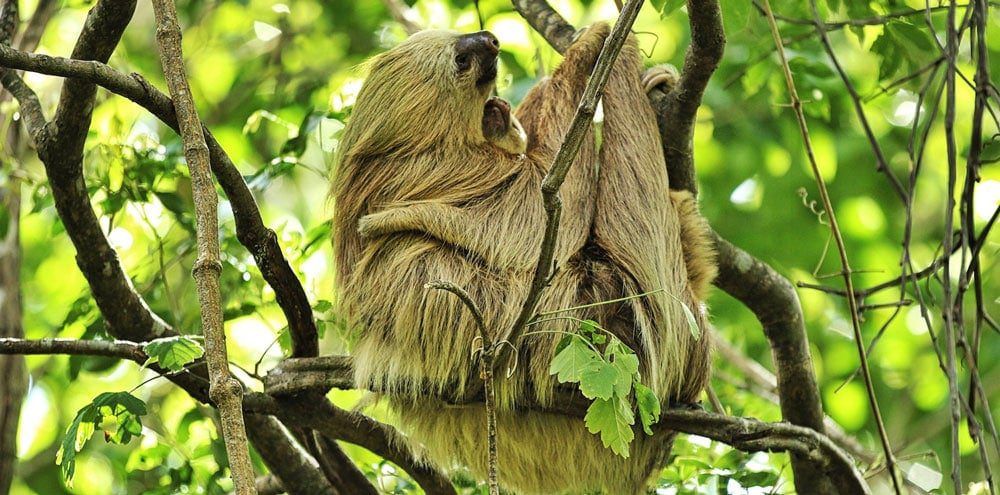
Sloth mom and baby in a natural park in the south of Nicaragua
Discover our top five main reasons why nicaragua is your travel dream coming true, 1. costa rica vs nicaragua: the beaches, waves & biodiversity.
All beaches are not created equal. But Costa Rica and Nicaragua share both a Pacific and Atlantic coastline and so in this case beaches are created equal. Whereas the Gulf of Fonseca creates a stark break in the coast between Nicaragua and El Salvador, and Costa Rica’s southern border with Panama doesn’t share the coastal qualities that tourists flock to in the central and northern regions, much of Nicaragua’s south-Pacific coast is a carbon copy of Costa Rica’s busiest tourism beaches – minus the excess of people.
Costa Rica is well known as an ecotourism destination to find quiet beaches and lush jungles, while it is actually Nicaragua that has the largest rainforest of Central America (home to 7 % of the worlds biodiversity!). Costa Rica and Nicaragua are two beautiful places with jaw-dropping beaches and friendly locals. But if you’re looking to enjoy the marvelous sunsets, immersed in nature, while surfing uncrowded breaks, you’ll have a much easier time finding that in Nicaragua.
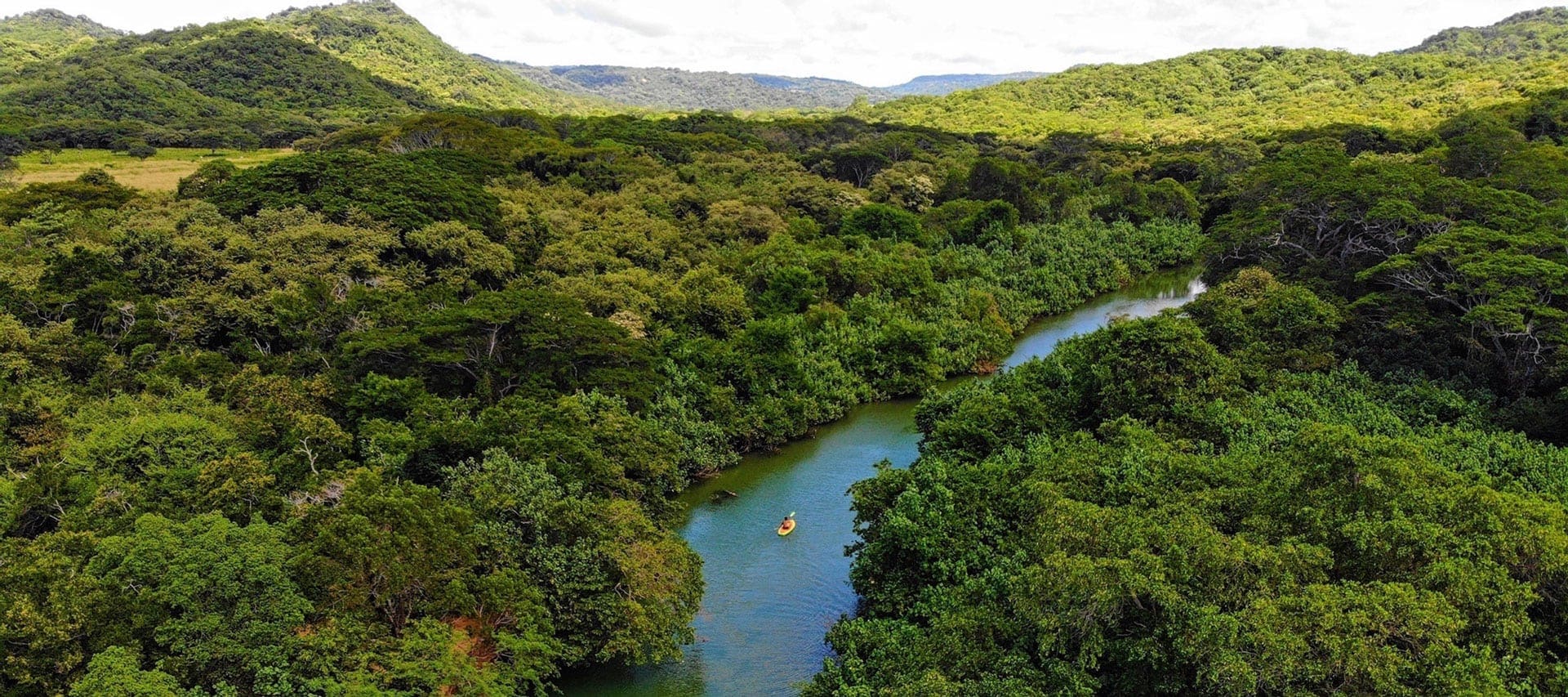
Natural Immersion into the untouched jungle of Nicaragua
2. costa rica vs nicaragua: safety first.
Both Nicaragua and Costa Rica are quite safe destinations, especially when one uses some travel sense. The violent crime rates in both nations are less than many North American states and cities. And they are even significantly lower in Nicaragua than in Costa Rica (According to Wikipedia, Nicaragua actually has the lowest violent crime rate in all Central America). The tension between this safe reality on the ground and the misperception of danger online makes Nicaragua a hidden gem – a Costa Rica as experienced by its early discoverers – ready to be found by those willing to stretch beyond the powerful confines of group thought. A bit of history helps uncover some of the layers.
Nicaragua has had a troubled history with the United States government ever since the U.S.-appointed dictator who ruled Nicaragua for 40 years was overthrown in 1979. Media and public perceptions thus sensationalize any danger or unrest in the country. Although the political tensions subsided in 1989, it took 15 years for the first tourists to begin visiting. More recently, social unrest in areas far removed from the country’s prime Pacific tourism beaches led to a media frenzy in North America. This led to fewer tourists, creating an even better situation for travelers seeking pristine beaches and authentic natural and cultural vacations: fewer travelers, better value and local hosts as grateful as ever to show off their peaceful and beautiful land and culture.
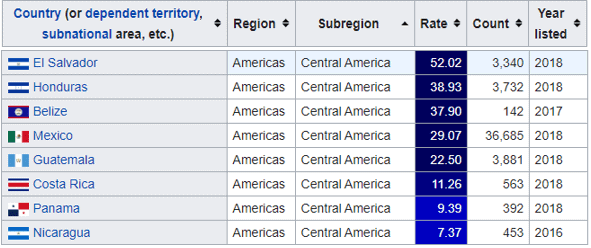
Nicaragua has the lowest homicide rate in Central America .
Source: https://en.wikipedia.org/wiki/List_of_countries_by_intentional_homicide_rate
3. Costa Rica vs Nicaragua: Local connections and culture
Many people see their vacation simply as an escape from a busy North American urban life. Most of us need a time out at some point. We want a beach, sun, margaritas, good food, a cozy bed and not much else. The standard tourism cycle reflects the power of this need. Early in the cycle, a place is discovered by adventurers for its natural, social and cultural purity. In the middle of the cycle, word of this grows and more people visit because of these purities. Eventually, people visit not because of the purities but because a place is popular.
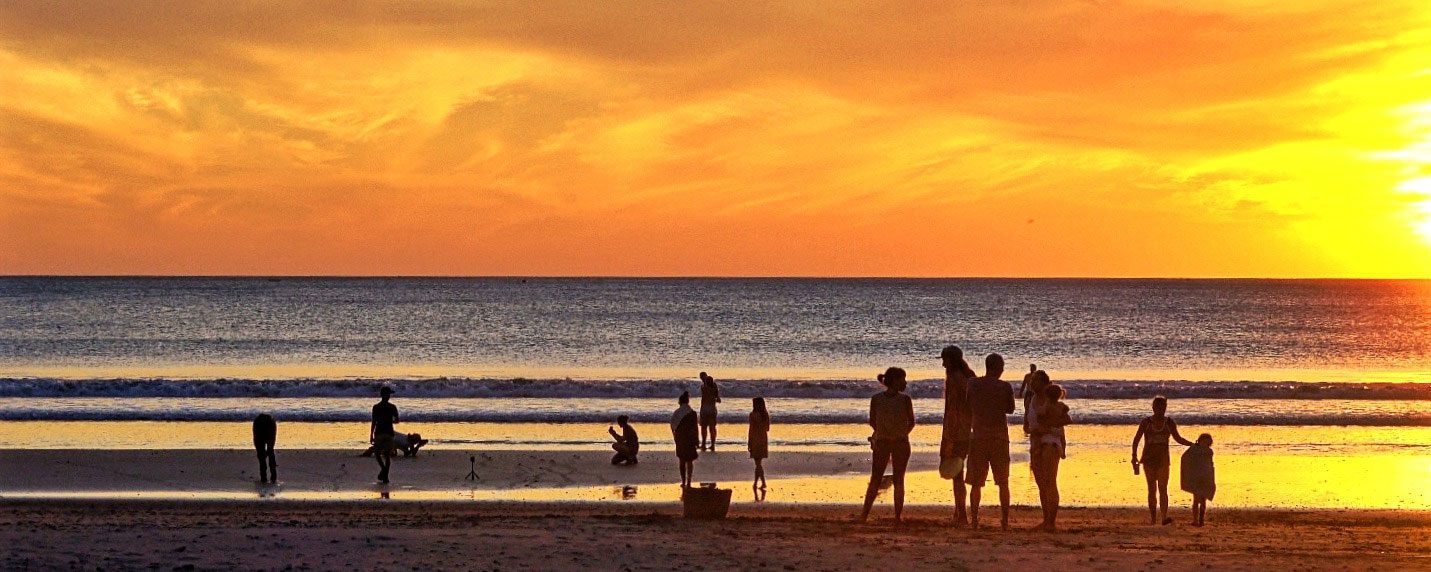
Feel the amazing vibe of locals and tourists sharing the world’s best sunsets
Nicaragua has very few fast food chains, but instead a lot of healthy and fresh, vegan/vegetarian options. Another of the benefits of Nicaragua’s slower tourism curve is that the tremendous hospitality experiences are delivered in a distinctly Nicaraguan way. Connections are genuinely made with tourists not because they are tourists but because they are human and because the people genuinely want to share and connect with other cultures and people.
4. Costa Rica vs Nicaragua: Value for money
Nicaragua and Costa Rica share much more than a border that spans from coast to coast. The wildlife, ocean activities, and available eco-wellness experiences are similar among the two countries. Plopped at random in either country, one might have a hard time identifying which country they are in. There is a cleare difference though and that is price: Costa Rica is about twice as expensive as Nicaragua.
Like Costa Rica, Nicaragua has a range of tourism infrastructure, from budget hostel to 5-star resorts. Expenses for a backpacker’s vacation at a busy beach-town in Costa Rica will likely end up costing a similar amount than an all-inclusive eco-retreat experience at a private, pristine beach in Nicaragua. Matched for value a Nicaragua experience will exceed your price – value expectations and will be considerably more affordable. This allows many travelers who choose Nicaragua to stay longer and experience more of what they’re looking for in a Central American vacation.
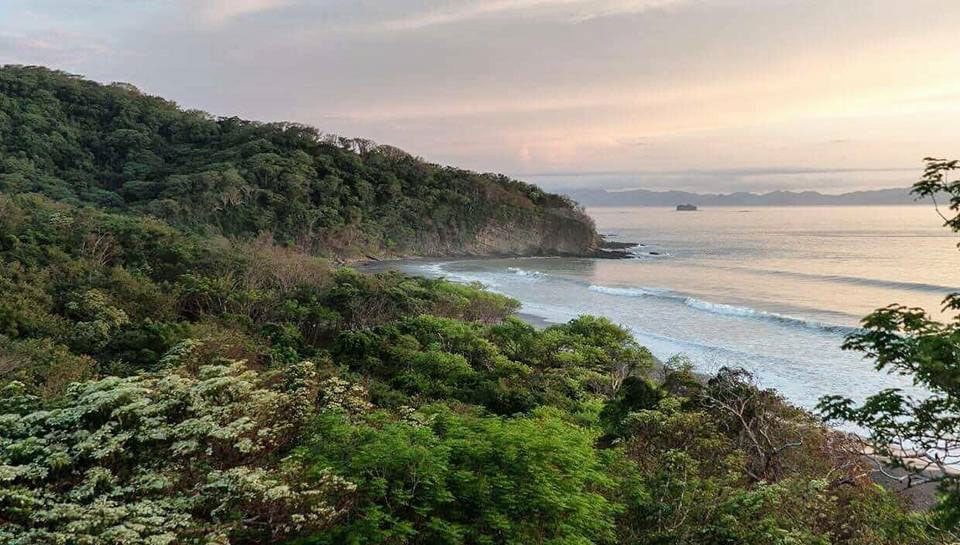
Foto of Escameca beach in Nicaragua, with Costa Rica in the background.
5. costa rica vs nicaragua: getting to the best parts of the country by airfare.
Liberia’s International Airport is Central America’s busiest airport for beach seekers. It’s only 75 kilometers from the border with Nicaragua. Since many of Nicaragua’s best beaches are in the south of the country, close to that border, by looking at possible destinations there a traveler opens up to nearly double the potential beaches within the Liberia airport catchment area. And, since most beach travelers who de-board at Liberia head to a select few beaches in Costa Rica, those who expand their horizon ever so slightly have access to some of the most pristine and tranquil beach experiences that are difficult to find on the Costa Rican side. Many resorts in Nicaragua arrange a transfer directly from the airport in Liberia to their front door, which takes only an hour more than a trip to one of the nearest by Costa Rican beaches.
So when thinking about your next retreat experience, don’t book the Central America retreat that pictures sell you on. Book the one your mind envisions.
Read more reviews and experiences of your fellow travelers here !
Inquire now to book your dream Central American surf and yoga retreat , watching whales during meditation and listening to nothing but the precious sounds of nature.
UPDATE: Traveling to Costa Rica vs Nicaragua during COVID 19
(08.01.2024)
All COVID restrictions, in both Nicaragua and Costa Rica, were lifted last year. You no longer need to worry about PCR tests or proof of vaccination.
(03.12.2020)
Costa Rica is open to everyone from everywhere and does not require a negative Covid-19 test. You do need a specific health insurance though which you can buy per day. The official insurance by Sagicor costs a little over $10 per day which quickly adds up if you want to stay for more than a few days.
You also need a filled out health pass (this one here https://salud.go.cr ) and proof of onwards travel, for example your outward flight or a bus ticket. Equipped like that you are free to enter Costa Rica.
Everyone who enters Nicaragua, no matter if through an airport or over a land border, needs a negative Covid-19 test not older than 72 hours. That measure greatly reduces the risk of tourists spreading the coronavirus. You don’t need anything else – no insurance, no onward travel, no health pass.
Looking at the number of Covid-19 cases and deaths, Nicaragua is doing much better than Costa Rica, which might be due to Nicaraguan people living in quite spread out villages with only little close contact inbetween communities. That makes it easier to single out affected communities without having a countrywide spread.
If you decide to travel to Costa Rica, we can only recommend one thing: Take a bus or a taxi, head to Peñas Blancas and come on over to Nicaragua. 🙂
https://www.nicaragua.com/travel/eco-tourism/
https://www.tripadvisor.com/ShowTopic-g294477-i2982-k6784336-Costa_Rica_vs_Nicaragua_vacation_destination-Nicaragua.html
https://theculturetrip.com/central-america/nicaragua/articles/the-best-surfing-spots-in-nicaragua/
Nicaragua vs Costa Rica – which one should I travel to?
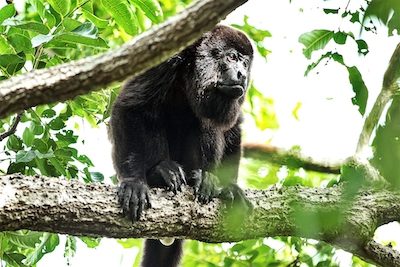
19 Comments
I am thinking of moving to nicaragua. In about a year. Hopefully this coronavirus thing will be under control. I’m 71 and retired.
Hi Stephen! Nicaragua is a great place to spend your retirement, as it is low cost and perfect climate! The only thing is that you should be relatively fit as there aren’t many shops or so that are for example wheelchair friendly. We know quite some people who live their best life here and actually get to enjoy their days even now during coronavirus times.
Who says Nicaragua doesnt have the franchise burger anf pizza joints McDonalds. Pizza Hut, Are and many more. We skip all of them and eat local Like at La Cascada at Pelican Eyes San Juna Del Sur and La Frontera Granada both have amazing food service and each have best hamburgers in their area. Dont forget Las Peñitas for great pizza. I can go on…. Many great places to eat, chill and enjoy Nicaragua
Quality and availability of health care?
In Nicaragua health care is a mixed system of free from the government as well as private paid hospitals. The closest hospital to our resort was built in 2019, modern and clean.
Me gustaria comprar un terreno para construir una casa y despues mudarme y me tambien saber si el seguro social me es sufficiente pues soy Puertoriqueño?
It is COVID safe as good as any place now. I visited twice this year. People may be wearing masks but it is by choice. You no longer need the PCR test. Now just proof of vaccination. The only place that required a mask was the ATM machine 🙂
Thinking moving to Nicaragua .
Who says Nicaragua doesn’t have the franchise burger and pizza joints McDonalds. Pizza Hut, Are and many more. We skip all of them and eat local like at La Cascada at Pelican Eyes San Juan Del Sur and La Frontera Granada both have amazing food service and each have the best hamburgers in their area. Don’t forget Las Peñitas for great pizza. I can go on…. Many great places to eat, chill and enjoy Nicaragua
Why do you want McDonalds in Nicaragua? The local food is infinitely better.
I’ve been to Nicaragua and I actually witnessed quite a lot of international fast food chains in the capital so I’m curious as to why the articles says that Nicaragua doesn’t have any, it’s just completely untrue.
Hi Alberto! That really only applies to the capital. You’re right, there you can definitely find more international things. Out here in the countryside where we are, you will have difficulty finding anything like that. 🙂
There are hardly any fast food chains here. Some in the capital. A few scattered about. Nothing compared to surrounding countries..
How does the weather compare to the Central Valley of Costa Rica??
I long for the 72-82 degree year round days!
Please advise
Paul, why are you talking about burgers and pizza at 5:30am…
How do I get around in Nicaragua? is public transport well set up? Are buses safe? Can I book organized tours to hike up a volcano? What tour companies do you recommend? What are the best places to visit?
Thank you for any tips.
Is there a covid vaccine requirement to enter or will a negative test do? If you are not vaccinated will I have to quarantine? Are masks required while out?
I am glad that I saw this post. It is informative blog for us and we need this type of blog thanks for share this blog.
I was surfing net and fortunately came across this site and found very interesting stuff here. Its really fun to read.
Submit a Comment Cancel reply
Your email address will not be published. Required fields are marked *
Save my name, email, and website in this browser for the next time I comment.
Submit Comment
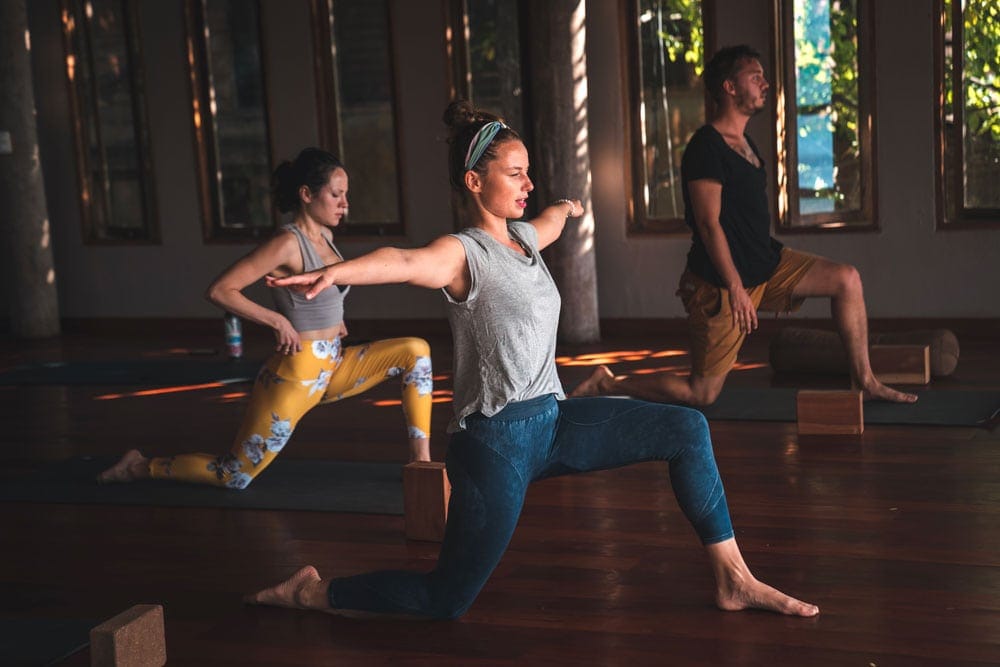
Yoga Retreat Packages
Yoga is a crucial element of our life here at Costa Dulce since it is the foundation of the holistic lifestyle we embody. Yoga and wellness is the key to take care of ourselves, our surroundings, and the people we love. Learn more about our Yoga Retreat Program .
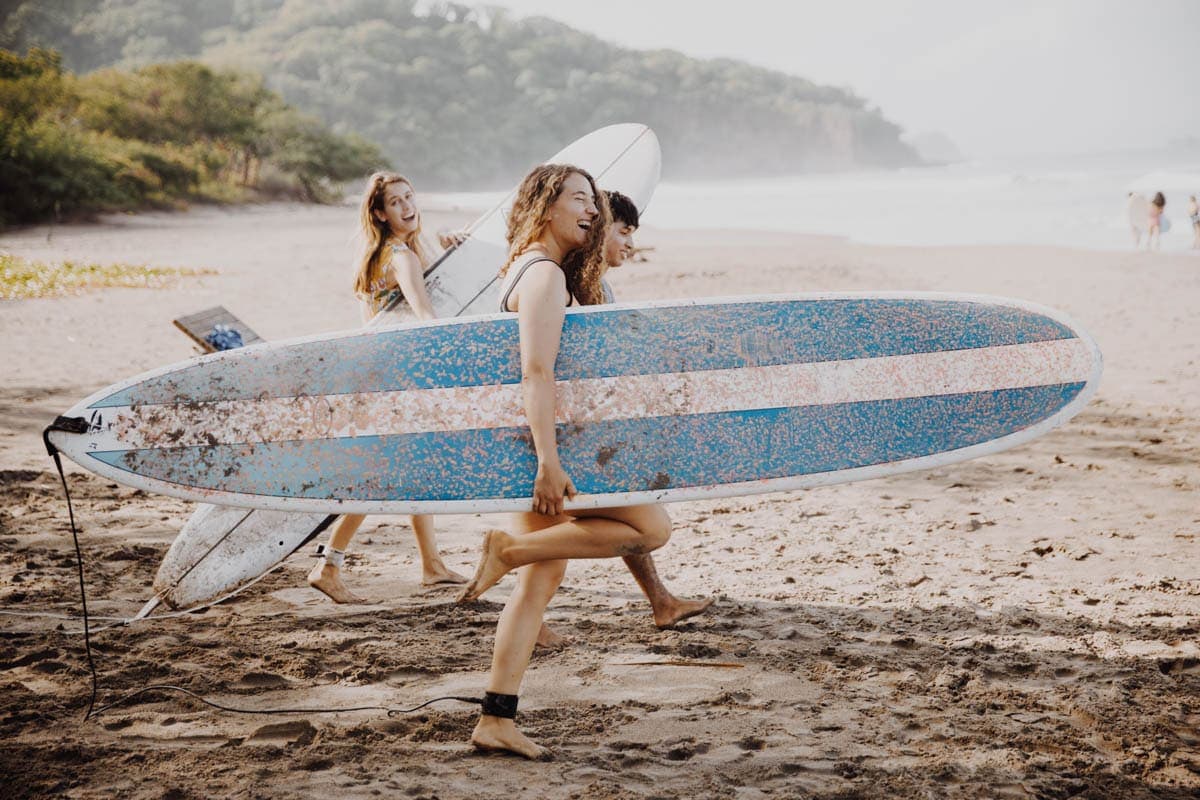
Surf in Private Paradise
Costa Dulce provides the perfect opportunity to learn how to surf. This is your chance! Nicaragua is a great place to learn but many try and do it at the crowded and more popular surf breaks. Learn more about our Surf Camp Program .

Relax with our Spa Treatment
Treat your body with a relaxing massage, nourish your body/face with a natural mask or energize your body and skin with our signature coffee/ coconut oil scrub, two of Nicaragua’s finest ingredients. Learn more about our Spa & Wellness services.
Recent Posts

Surf and Yoga: A Match made in Tropical Heaven by Shruti Shah (@flowithshruti)
by Costa Dulce Team | Oct 28, 2022 | Surfing , Yoga
As a yoga teacher who surfs on occasion, I have realised that being on the surfboard out in the water gives me the same feeling that comes from being on my yoga mat. Surfing allows me to connect with nature and be truly present in the moment, the same way flowing with...

Holistic Wellness Center
by Costa Dulce Team | Mar 6, 2024 | Wellness , Yoga
Are you looking for a place to rejuvenate your mind, body, and soul? Holistic wellness centers have become increasingly popular as people seek a comprehensive approach to health and well-being. These centers focus on your overall well-being, catering to various...

Yoga Twice A Day: The Benefits & Why
by Costa Dulce Team | Feb 1, 2024 | Retreat , Yoga
Yoga Twice A Day: The Benefits & Why Yoga, an ancient practice with a history spanning thousands of years, has evolved into a holistic approach to well-being embraced by people worldwide in our modern age. Beyond a mere series of poses, yoga offers a path to...

How To Get From Costa Rica to Nicaragua
by Costa Dulce Team | Jan 1, 2024 | Costa Rica vs Nicaragua , Ecotourism , Nicaragua , Safety , Travel Plans , Vacation
You’ve most likely done some research to get to this point, and yes it is better to travel through Costa Rica to get to Nicaragua. Liberia, Costa Rica, or in some cases San Jose, Costa Rica. Both have international airports with many more flight options, direct flights and in many cases cheaper prices.
Stay in touch
Sign up for our newsletter, stay in touch with the Costa Dulce family and get updates, news + discounts on your next stay.
Thank you for subscribing!
Pin it on pinterest.

How To Get From Costa Rica To Nicaragua In 2024: Answered!
- Post author: Nicoletta
- Reading time: 22 mins read
- Post last modified: February 10, 2024
- Post comments: 0 Comments
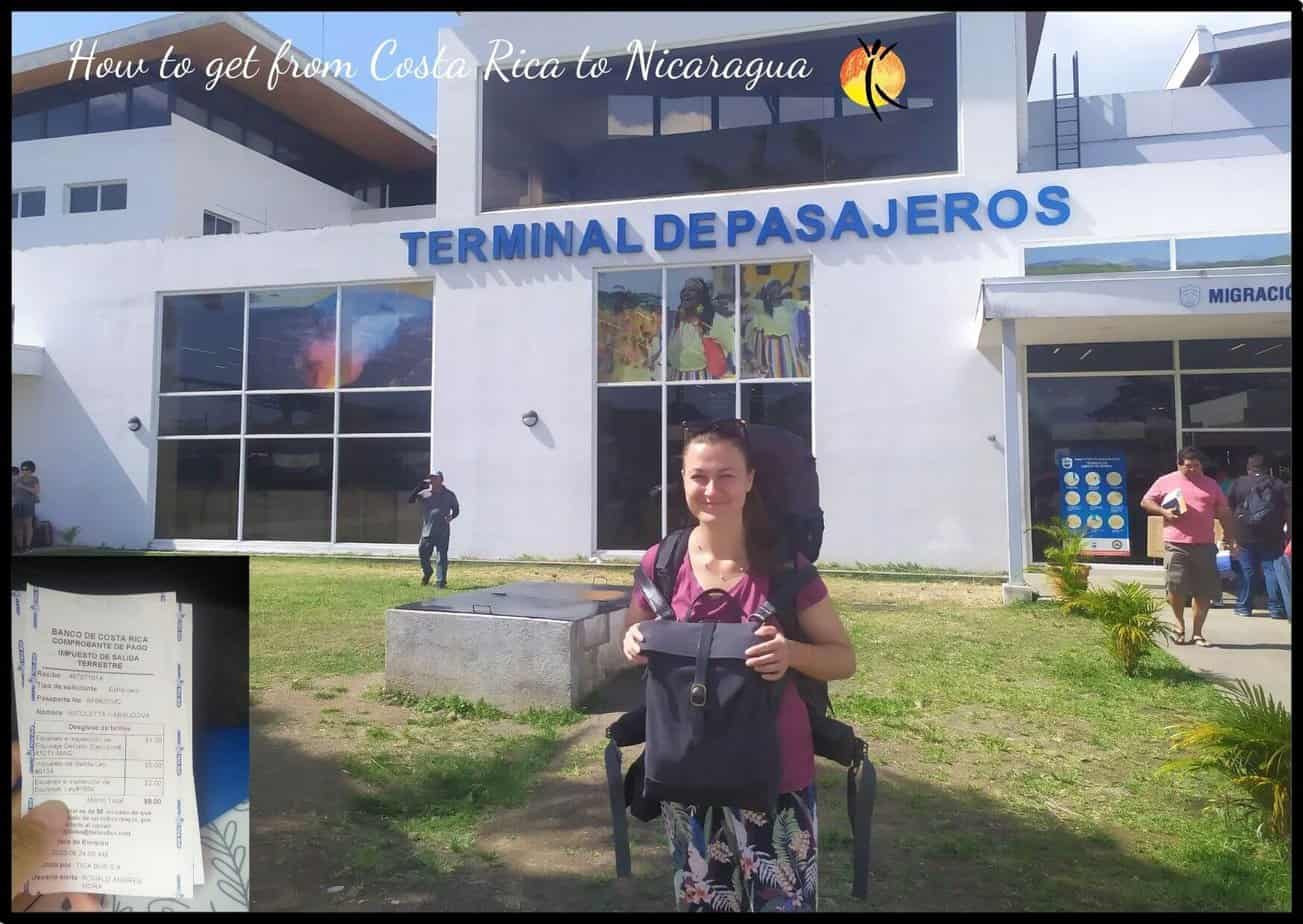
Getting around Central America is fun. Flights are slightly more expensive, yet some buses take you almost everywhere . You can book bus tickets online, too. Today, I’ll tell you how to get from Costa Rica to Nicaragua and save time.
This article will be for those planning on traveling from Costa Rica to Nicaragua by bus . It’ll explain the entire process step-by-step , from booking your tickets to crossing the borders, the documents you need, and where the bus stations are located.
I traveled from Costa Rica to Nicaragua and made the entire journey on my own. So here is all the information from my experience.
✈ Travel Resources For Your Trip ✈
Here are some of my favorite travel resources I use for my travel adventures.
How To Get From Costa Rica To Nicaragua
The best way to get from Costa Rica to Nicaragua is by Tica Bus . Another option is to fly from San Jose (Costa Rica) to Managua (Nicaragua).
Flying To Nicaragua
You can fly from San Jose (Costa Rica) to Managua (Nicaragua). It’s the easiest, fastest, and most convenient way to get to Nicaragua. Once you land, get a taxi to your hotel. However, flights to Managua are quite expensive . But if you don’t mind, you’re good to take a flight.
➡ Get the best flight deals to Nicaragua (Managua) by clicking this link.
Getting To Nicaragua By Bus
Tica Bus is an official company operating in the entire Central America. No matter where you are, you can travel from Panama to Costa Rica or Nicaragua via El Salvador and Guatemala to Mexico. Tica Bus will take you to every country .
Three different bus companies are operating the route from Costa Rica To Nicaragua:
➡ Tica Bus ➡ Central Line ➡ Nica Expresso
Tica Bus is the biggest one with the most buses and schedules. I traveled from Costa Rica to Nicaragua with Tica Bus . Even though you’ll find many bad reviews online, I didn’t have any single issue. The bus was clean, departed, and arrived on time. The border passing went smoothly, stopped on the way, and everything went well.
Costa Rica to Nicaragua Bus Time: about 10 hours . It departs from San Jose from this location: Tica Bus, Transversal 26, Pitahaya, San Jose .
Is It Safe To Travel From Costa Rica To Nicaragua?
Yes, it’s very safe to travel from Costa Rica to Nicaragua. I made this journey on my own and didn’t have any problems. People are friendly ; they advise you on what you need to bring, take care of your luggage, the bus stops on the way, and everything runs smoothly. There is nothing to be afraid of.
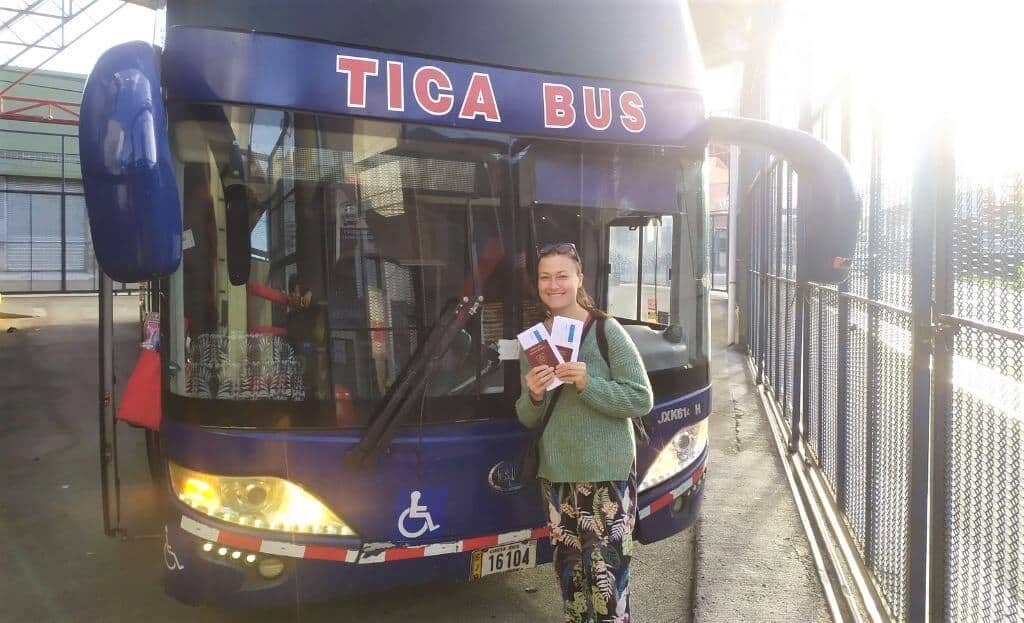
Getting To Nicaragua By Boat
The last option is to take a boat from Costa Rica to Nicaragua. It’s one of the most adventurous yet longest ways to get to the country.
You can take a boat from San Carlos port in Costa Rica and travel to Granada, Nicaragua . The entire journey takes 16 hours because the boat stops on many islands along the way. It costs around $10 for the entire ride.
I haven’t made this journey as we took the bus, but I’ve heard from other travelers that it’s possible.
Shuttles From Costa Rica To Nicaragua
There are also shuttles that will take you from Costa Rica to Nicaragua. It’s one of the most convenient ways because it’s easier and faster than taking a bus . You’ll be directly in contact with the shuttle company, and it’ll answer all your questions and doubts.
So, if you prefer taking a small shuttle to Nicaragua, check out Caribe Shuttle and request a ride.
Travel Itinerary Planning Services
How to book tickets to get from costa rica to nicaragua.
Assumming, you’ll take a bus, you can book tickets directly at the company office or on the Tica Bus website . I suggest buying tickets online. Because until you get to Costa Rica to their office, tickets might be sold out. As I have experienced, they sell out quickly . So, it’s better to secure your spot before buying it online.
When buying tickets online, you’ll have to fill out the form they ask you for (name, occupation, passport number, etc.). There are different departure times throughout the day (usually 3 connections in the morning), so select one, pay for the ticket online , and you’re good to go.
I recommend printing your ticket and showing it to them once you board the bus.
Documents You Need To Travel From Costa Rica To Nicaragua
To get from Costa Rica To Nicaragua, you’ll need the following documents:
✅ Passport ✅ Visa ✅ Fill out the entry form online ✅ Printed bus ticket ✅ Confirmation of your hotel/hostel in Nicaragua (printed)
I recommend you have all documents in the printed version . You never know; sometimes, they don’t accept it from your phone, or it may die. Just be prepared.
Check if you need a Visa to Nicaragua online.
Before traveling, you must also fill out an official form on the Nicaraguan government website. You can do so at this website . After you fill it out, it’ll generate a code for you. I recommend printing this paper with the code on it. You’ll also get a confirmation email . They didn’t ask me for this code anytime when crossing the border.
They’ll ask you where you’ll be accommodated in Nicaragua. Some might want a printed confirmation. So be sure you also print your hotel or hostel booking .
➡ Check if you need Visa for Nicaragua by clicking this link.
Border Crossing Between Costa Rica & Nicaragua
The border crossing went pretty smoothly. Yet it takes more than 2 hours to finally get through. Because there are few people at the border control, it takes ages to get to the counter.
Here is how the border crossing works step-by-step:
- Costa Rican border – pay $8 to leave Costa Rica & get a stamp (no need to carry your luggage from the bus), + there are toilets at the border.
- Nicaraguan border – pay $14 to enter the country, take everything from the bus with you (luggage, carry-on, nothing stays on the bus), wait until you get to the counter inside the Terminal, get your passport stamped, go through security check (luggage scan), go back to the bus.
Costa Rican Border Information
Before boarding a bus in Costa Rica, they usually check all your documents at the office (passport and Covid documents). To leave Costa Rica, you have to pay a fee of $8 . Before boarding the bus, I paid for this at the Tica Bus office in San Jose.
Just know that you must pay this fee, so have US dollars . They may ask for it at the office (and give you a confirmation). Or you’ll pay it directly at the Costa Rican border. So keep the confirmation that you’ve paid with you.
Otherwise, it’s straightforward. You go to the border counter, the police stamp your passport , ask you if you’ve paid the fee of $8, and you’re good to go.
Then you’ll hop on the bus again , and once everyone is done at the border, you’ll drive to the Nicaraguan border .
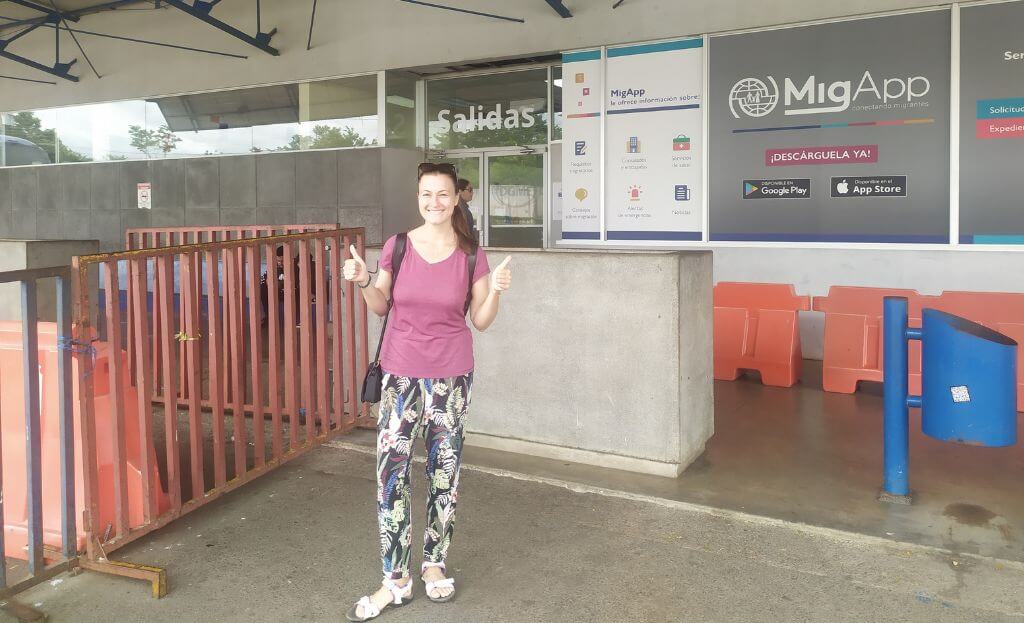
Nicaraguan Border Information
The process at the Nicaraguan border is slightly longer.
Once you arrive, you’ll have to take all your stuff from the bus . Don’t leave anything inside. Take your backpack, luggage, carry-on, and everything you have. Then you’ll walk towards the Terminal . Wait there until you get to the counter.
To enter Nicaragua, you’ll have to pay a fee of $14 . While standing in front of the Terminal in line, a random guy was collecting $1 from everyone in the line. Don’t worry, he’ll give you a small paper confirmation that you paid it. You’ll pay the rest, $13, directly at the border counter inside the Terminal.
What To Do At The Nicaraguan Border Counter
Once you reach the border counter , they’ll ask you for your passport, occupation, and where you’ll stay in Nicaragua. Afterward, they’ll give you stamps with paper confirmations (keep them in your passport) and ask you to pay the fee of $13 .
Once you have your passport back, you can proceed to security . It’s right in front of you. They’ll scan all your luggage . After, you can leave the Terminal and go to the bus .
There’ll be one more policeman in front of the bus , who will control your passports with the paper confirmations you obtained at the border counter. He’s just checking if you went through the border.
Then wait until everyone is on the bus, and… welcome to Nicaragua :). The border passing is done.
The bus will arrive in Nicaragua at the Tica Bus station. You’ll see the location when you type Tica Bus Managua into Google Maps. There will be many taxis , so you can ask one to drive you to your hotel. Negotiate the price . They almost always tell you more if you’re not local.

👉 READ ALSO: Best Of Nicaragua Itinerary: 7 Days With Map & Tips
I’ve also answered some of the most frequently asked questions to help you prepare for your journey from Costa Rica to Nicaragua. Check them out below.
What Is The Best Way To Get To Nicaragua?
The best way to get to Nicaragua is to fly or take a bus.
Flights to Managua, Nicaragua, are pretty expensive, but it’s the fastest and easiest way to get to Nicaragua. It only takes about an hour by plane. You can also take the Tica Bus , which takes over 10 hours. It’s the cheapest and most secure option.
Can You Take A Bus From Costa Rica To Nicaragua?
Yes , you can take Tica Bus from San Jose (Costa Rica) to Managua (Nicaragua). The entire bus journey takes 10 hours . Make sure you have all the necessary documents for the border crossing to Nicaragua.
Can I Cross From Costa Rica To Nicaragua?
Yes , you can cross from Costa Rica to Nicaragua. Whether you’re walking, taking a bus, or driving a car, it’s possible. Just follow the steps on each border. If you’re walking, once you get out of the Nicaraguan border, there are even some people or shuttles that will take you to your destination in Nicaragua.
Can You Take A Boat From Costa Rica To Nicaragua?
Yes , you can take a boat from San Carlos (Costa Rica) to Granada (Nicaragua). The entire boat ride takes about 16 hours and costs approx. $10 and leaves every Tuesday and Friday. The boat stops on several islands, so it takes such a long time.
WRAP-UP: How To Get From Costa Rica To Nicaragua
This is how to get to Nicaragua from Costa Rica. It’s a pretty nice journey and isn’t stressful at all, even if it looks like it. As long as you have all the documents prepared, you’ll be fine. Also, the companies you’ll travel with are super helpful . So they’ll also make sure you have everything to enter Nicaragua.
If you have any questions or need a customized travel itinerary, contact me at info(at)voicesoftravel.com . I’ll gladly help you.
Happy Travels!
More Tips For Nicaragua Travel
Looking to visit more places in Nicaragua? Check out my related articles:
Best Of Nicaragua Itinerary: 7 Days With Map & Tips
Is Nicaragua Safe To Travel To? Safery Tips For Travelers
11 Unique Things To Do On Ometepe Island
How To Get To Ometepe Island
Where To Stay In Ometepe Island
Where To Stay In Granada Nicaragua
Where To Stay In Leon Nicaragua
Where To Stay In Popoyo Nicaragua
Is It Safe To Fly From Lima To Cusco? Revealed!

About the author: Nicoletta is a travel enthusiast and passionate language learner. While traveling, she loves to connect with locals using her language skills to learn about new cultures. Look for her skiing, hiking in the mountains, or exploring new destinations as she designs travel itineraries for her clients.
NICARAGUA : Interested in more articles for Nicaragua? Check out my Nicaragua Travel Page .

You Might Also Like

21 Best Day Trips From Ljubljana For 2024
![travel to costa rica and nicaragua Read more about the article Where To Stay In Ometepe Nicaragua: Best Areas & Hotels [2024]](https://voicesoftravel.com/wp-content/uploads/2023/03/where-to-stay-in-Ometepe-1-300x213.jpg)
Where To Stay In Ometepe Nicaragua: Best Areas & Hotels [2024]
![travel to costa rica and nicaragua Read more about the article How To Get To Capri Italy: Full Guide & Tips For Visiting [2024]](https://voicesoftravel.com/wp-content/uploads/2023/12/how-to-get-to-capri-italy-21-1-300x213.jpg)
How To Get To Capri Italy: Full Guide & Tips For Visiting [2024]
Leave a reply cancel reply.
You must be logged in to post a comment.

For each tour, Native’s Way has carefully selected guides who have extensive knowledge of the area to guarantee an authentic Costa Rican experience for you.
Latest Posts
Tamarindo nightlife top 5 things to do.

Gulf of Papagayo Travel Guide
U.s./canada: 1 (800) 605-2806, [email protected].
Follow Us:
1-800-605-2806
C.R. 4000-3826

Nicaragua Tour from Costa Rica
Nicaragua's best highlights all in one day.
- INFORMATION
Nicaragua Tour from Costa Rica – One Day Tour
Book online now!
Explore all of Nicaragua’s most famous highlights all in one day on this Nicaragua tour from Costa Rica! You will see a dormant volcano crater, the active Masaya Crater, go shopping at the artisan markets, explore the colonial town of Granada, and go on a boat ride viewing the islets of Lake Nicaragua, and even get to feed monkeys!
NICARAGUA OVERNIGHT OPTION: Stay Overnight in Granada and come back any day you like!
Visit the highlights of Nicaragua in One Day
Look into the Masaya Active Volcano Crater
Visit to Colonial Town of Granada
Boat Ride in Lake Nicaragua
Shop Artisan Markets
Door-to-door service: Pick-up and Drop-off at your hotel
All Border Taxes included ($27)
Shared Tour:
Adults & Children – $190 per person
Overnight Option – $260 per person
Private Tour:
2-3 People $300 per person
4+ People $225 per person
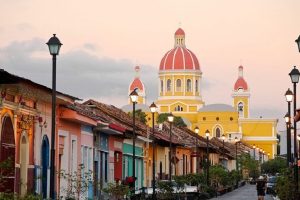
Overnight in Granada Option:
Book your Hotel in Granada and return any day you like with our tour! Hotel not included, we can help you with this upon request. $260 per person, Option Available at Checkout.
Nicaragua Tour from Costa Rica Itinerary
You will picked up from your hotel promptly and taken to the border where your guide will help you in every step of the crossing, which takes about 30 minutes. The guide will make the process easy for you and will take care of all of the passport paperwork and visas. From here we will travel to eat a hearty breakfast to start off the day.
Catarina Volcano Outlook Point:
Here you will enjoy an incredible view over the dormant volcano crater, Granada, and Lake Nicaragua. You will be allowed to walk around freely for a while before getting back in the bus and heading to the next stop.
Masaya Artisan Market:
Do some shopping for inexpensive souvenirs and experience the Nicaraguan life style before sitting down for a typical Nicaraguan lunch.
Masaya Volcano:
An active volcano where you will have the opportunity to stand right next to its crater and hear it rumbling and spewing of gases. An incredible, rare sight.
Next stop: Granada!
An old Colonial town near Lake Nicaragua. Stop at La Merced Church, considered one of the most beautiful buildings of Granada. It is flanked by a large tower that houses the church bells. You will ascend the stairs and reach the roof of the church. From here, you’ll have a panoramic city view of Granada, Mombacho Volcano, and Nicaragua Lake with the islets. This is the perfect place to take pictures of the beautiful city and the surroundings.
Lake Nicaragua:
Your last stop is a one hour boat ride in Lake Nicaragua viewing the Nicaraguan Islets around sunset. Your guide will stop by Monkey Island consisting only of monkeys that will come out and take food from your guide on the boat! You will then head back to Costa Rica, stopping on the way to pick up some snacks for the ride home.
Overnight option: – Hotel is NOT Included, but let us know if you need help with this. Please send us what hotel you will be staying at, what date you will be returning to Costa Rica and your drop off location in Costa Rica.
Entry to Nicaragua Requirement
SEND US A PHOTO OF YOUR PASSPORT to [email protected] or our WhatsApp
DISCLAIMER:
ASK OUR TEAM OF EXPERTS IF YOU NEED A SPECIFIC REQUIREMENT DUE TO YOUR NATIONALITY OR PASSPORT
Transportation Info:
We pick up from the hotels, condos and private residences in the following areas:
Hacienda Pinilla/JW Marriott: 4:00 AM Langosta/Tamarindo Hotels, Condos, Apartments, Houses: 4:30 AM Conchal (W/Westin Conchal), Brasilito Hotels, Condos, Apartments, Houses: 4:45 AM Playa Grande, Flamingo, Potrero Hotels, Condos, Apartments, Houses: 4:30 AM Catalinas: 4:15 AM ($60 extra per booking, not per customer/Viator $50) RIU Hotels Main Security Gate, Not the Lobby: 5:00 AM Playas del Coco Hotels, Condos, Houses: 5:20 AM Playa Hermosa & Panama (Occ/Secrts Papagayo, Villas Sol, Condovac, Mangroove): 5:30 AM Liberia Peri Supermarket: 6:00 AM Andaz, Four Seasons, Planet Hollywood: 5:20 AM ($50 extra per booking, not per customer) Dreams Las Mareas: 6:00am
Pick up times above are an estimate. We will send you an official pick up time the day before the tour. Please be ready outside 10 minutes before your scheduled pick up time, but it can take up to 20 minutes longer depending on the day’s pick up schedule and traffic.
Special Notes
- All border taxes are included
- Minimum to operate the shared tour is 4 people, if we don’t meet the minimum we will send options 1 or 2 days before
- It is prohibited to enter the country of Nicaragua with the following items: all kinds of Drones, all kinds of Binoculars, including those for Night vision, and any object considered for professional, journalistic, and similar audiovisual reproduction.
- Please advise any specific dietary requirements at time of booking
- A moderate amount of walking is involved
- Children must be accompanied by an adul
- Adult pricing applies to all travelers
Cancellation Policy
Departure time, return time, not included, from our gallery.
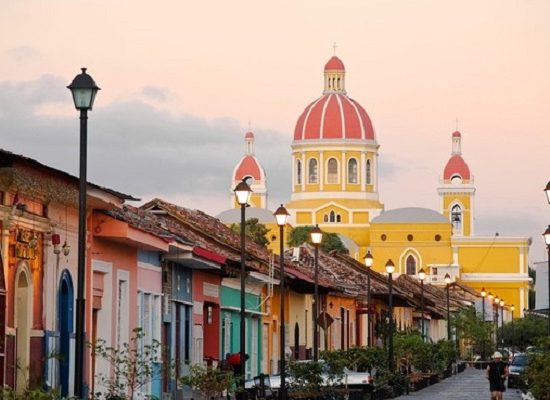
Hotel Pick up
Catarina volcano outlook point, masaya volcano, boat tour in lake nicaragua of isletas, tour location.
Granada, Nicaragua

Native's Way
You don't have permission to register
Winter is here! Check out the winter wonderlands at these 5 amazing winter destinations in Montana
- Travel Tips
Nicaragua To Costa Rica – Crossing Borders
Published: September 22, 2023
Modified: December 27, 2023
by Kelcey Laughlin
- Central & South America
- Plan Your Trip
- Travel Destinations
Introduction
Traveling from Nicaragua to Costa Rica is an exciting journey filled with adventure and discovery. Both countries offer stunning landscapes, rich cultural heritage, and countless opportunities for exploration. Whether you are a nature enthusiast, a history buff, or simply seeking relaxation on beautiful beaches, this cross-border journey has something to offer for everyone.
Nicaragua, known as the “Land of Lakes and Volcanoes,” is a captivating country with diverse attractions. From the colonial charm of Granada to the pristine beauty of Ometepe Island, Nicaragua is a hidden gem waiting to be explored. On the other hand, Costa Rica is famous for its ecotourism initiatives and incredible biodiversity. With its lush rainforests, breathtaking waterfalls, and abundant wildlife, Costa Rica is a nature lover’s paradise.
In this article, we will guide you through the process of crossing the border between Nicaragua and Costa Rica and provide you with useful tips to make your journey seamless and enjoyable. We will discuss the necessary travel preparations, the required documents, and share insider information to ensure a smooth transition between these two amazing countries.
Whether you are embarking on a backpacking adventure or a leisurely vacation, understanding the logistics of crossing the border will help you plan your trip more efficiently. So, let’s dive in and discover the wonders that await you as you journey from Nicaragua to Costa Rica.
Preparing for the Journey
Before embarking on your cross-border journey from Nicaragua to Costa Rica, it is essential to make some necessary preparations. Here are a few things to keep in mind to ensure a smooth and hassle-free trip.
- Research and Plan: Start by researching both countries’ customs, cultures, and local regulations. It is also essential to plan your itinerary, including the places you want to visit, the duration of your stay, and the activities you wish to engage in. This will help you make the most of your trip and manage your time efficiently.
- Check Travel Advisories: Stay updated on the latest travel advisories and any potential safety concerns in the regions you plan to visit. Government websites and local tourism boards are excellent resources for up-to-date information regarding travel alerts or restrictions.
- Pack Accordingly: Consider the climate variations and activities you will engage in during your trip. Pack lightweight, breathable clothing for warmer climates and layers for cooler regions. Don’t forget essentials like sunscreen, insect repellent, and comfortable walking shoes.
- Stay Healthy: Visit your doctor or a travel clinic before your trip to ensure you are up to date on necessary vaccinations and medications. It is also wise to carry a basic first aid kit with you.
- Learn Basic Language Phrases: While English is widely spoken in tourist areas, learning a few common Spanish phrases can go a long way in enhancing your cultural experience and interacting with locals.
- Notify Your Bank: Inform your bank or credit card company about your travel plans to avoid any issues with blocked cards due to suspicious activity. Additionally, carry multiple forms of payment, including cash in the local currency.
- Arrange Transportation: Research and pre-book transportation options, such as flights, buses, or private transfers, to ensure a smooth transition between different destinations. Keep in mind that there might be specific COVID-19 protocols in place, so check the latest regulations and make arrangements accordingly.
By taking the time to prepare adequately for your journey, you will have a more enjoyable and stress-free experience. Now that you are prepared, let’s delve into the border requirements and documents necessary for crossing from Nicaragua to Costa Rica.
Border Requirements and Documents
When crossing the border from Nicaragua to Costa Rica, it is important to have the necessary documents in order to ensure a smooth transition. Here are the key requirements and documents you will need:
- Passport: Your passport should be valid for at least six months beyond your planned stay in Costa Rica. Ensure that your passport is in good condition and has empty pages for immigration stamps.
- Visa: Most nationalities do not require a pre-arranged visa to enter Costa Rica. Visitors can stay for up to 90 days as tourists. However, it is essential to check visa requirements specific to your nationality before you travel.
- Proof of Departure: Costa Rica requires proof of onward travel, such as a return ticket or proof of ongoing travel to another destination. Make sure to have these documents readily available when crossing the border.
- Yellow Fever Vaccination Certificate: If you are arriving from or have spent time in a country with a risk of yellow fever transmission, you may be required to show a valid yellow fever vaccination certificate. Check if this requirement applies to you based on your travel history.
- Proof of Sufficient Funds: Immigration authorities might ask for proof of sufficient funds to support your stay in Costa Rica. This can be in the form of bank statements, credit cards, or cash.
- COVID-19 Requirements: Due to the ongoing pandemic, additional health measures and entry requirements may be in place. Check the latest COVID-19 guidelines, including any testing or quarantine requirements, before traveling to Costa Rica.
It is important to note that requirements and regulations can change, so be sure to verify the most up-to-date information from official government sources or consult with the nearest embassy or consulate.
Now that you know the essential documents required for crossing the border, let’s explore the process of crossing from Nicaragua into Costa Rica and the unique experiences that await you in each country.
Crossing the Nicaragua Border
When crossing the border from Nicaragua into Costa Rica, you will first need to navigate the Nicaraguan side of the border. Here are some tips to help you through this process smoothly:
- Timing: It is advisable to arrive early in the morning to avoid long queues and potential delays. Mornings are generally less crowded, and border officials tend to process travelers more efficiently.
- Exiting Nicaragua: Head to the immigration office on the Nicaraguan side of the border. Present your passport, filled-out exit form, and any required documents. The immigration officer will stamp your passport and officially exit you from Nicaragua.
- Customs Declaration: Before crossing the border, you will need to complete a customs declaration form. Declare any goods or valuables you are carrying, including currency exceeding the permitted limits, to avoid any issues during the process. Keep in mind that some items may require additional documentation or permits.
- Baggage Inspection: Your bags may be subject to inspection by customs officials. Be prepared to have your luggage searched, especially if you are carrying any restricted or prohibited items. It is always a good idea to familiarize yourself with the customs regulations of both Nicaragua and Costa Rica prior to your journey.
- Transportation: Once you have completed the immigration and customs procedures, you can proceed to the Costa Rican side of the border. Depending on the proximity of your destination, you can choose to take a bus, taxi, or private transfer to continue your journey.
Crossing the Nicaragua border can be a relatively straightforward process if you come prepared and follow the instructions of border officials. Remember to have all your required documents readily available, including your passport, exit form, and customs declaration. With Nicaragua behind you, get ready to explore the wonders of Costa Rica, your next destination.
Traveling through Nicaragua
As you traverse through Nicaragua on your journey to Costa Rica, you will have the opportunity to explore the diverse landscapes, vibrant culture, and historical sites that this beautiful country has to offer. Here are some highlights and tips for traveling through Nicaragua:
- Colonial Charm of Granada: Start your Nicaraguan adventure in the colonial city of Granada. Wander the colorful streets, visit charming cathedrals, and take boat tours on Lake Nicaragua. Don’t miss the opportunity to climb the bell tower of Iglesia La Merced for sweeping views of the city.
- Ometepe Island: Situated in Lake Nicaragua, Ometepe Island is a must-visit destination for nature lovers. Explore lush forests, hike volcanoes, and relax on beautiful beaches. The island is also home to archaeological sites and pre-Columbian petroglyphs.
- Adventures in León: Visit León, known for its rich cultural heritage and beautiful architecture. Climb the rooftop of the León Cathedral for panoramic views, explore local art galleries, and embark on thrilling volcano boarding on Cerro Negro.
- Nature in Masaya: Explore the natural wonders of Masaya, including the Masaya Volcano National Park. Witness the active crater, explore lava tunnels, and immerse yourself in the vibrant handicraft markets of Masaya town.
- Beaches of San Juan del Sur: Head to the coastal town of San Juan del Sur for a taste of Nicaragua’s beach paradise. Relax on stunning beaches, enjoy surfing or deep-sea fishing, and indulge in fresh seafood at beachside restaurants.
- Cultural Experiences: Immerse yourself in Nicaraguan culture by attending traditional festivals and events. Experience vibrant music, dance, and local cuisine, and engage with friendly locals who are proud to share their heritage.
While traveling through Nicaragua, it is important to exercise caution and adhere to safety guidelines. Stay informed about any potential political or social unrest, and avoid traveling alone at night in unfamiliar areas. By taking necessary precautions and respecting local customs, you can have a memorable and enjoyable journey through Nicaragua.
Now that you have explored the wonders of Nicaragua, it’s time to continue your adventure across the border into Costa Rica, where a different set of experiences and attractions await you.
Crossing the Costa Rica Border
As you approach the Costa Rican border, you are about to enter a country known for its abundant natural beauty and commitment to sustainable tourism. Here are some tips to help you smoothly navigate the Costa Rica border-crossing process:
- Arriving at the Border: When you reach the Costa Rican border, head to the immigration office. Keep your passport, proof of onward travel, and other documents readily available.
- Immigration Procedures: Present your passport to the immigration officer, who will stamp it and provide you with an entry permit. Make sure the entry stamp is clear and legible.
- Customs Declaration: Complete the customs declaration form, indicating any goods or valuables you are bringing into Costa Rica. Be honest and accurate in your declaration to avoid any issues.
- Baggage Inspection: Your luggage may be subject to inspection by customs officials. Be prepared to have your bags inspected, especially if you are carrying food, plants, or any restricted items.
- Entry Fee: Note that Costa Rica requires a mandatory entry fee, known as the “Tourist Visa.” This fee can be paid in cash or by credit card, and the amount varies depending on your nationality. Keep the receipt in a safe place during your stay.
- COVID-19 Health Measures: Due to the ongoing pandemic, Costa Rica has implemented additional health measures at the border. You may be required to present a negative COVID-19 test result or fulfill quarantine requirements. Stay updated on the latest guidelines and ensure compliance.
- Transportation Options: Once you have completed the immigration and customs procedures, you can continue your journey to your desired destination in Costa Rica. Choose from public buses, private shuttles, or rental cars to explore the country’s stunning landscapes and bustling cities.
Remember to keep all your necessary documents, including your passport, entry permit, customs declaration, and payment receipts, in a safe place throughout your stay in Costa Rica. It is also wise to have multiple copies of these documents, including digital copies stored on your phone or cloud storage.
Congratulations! You have successfully crossed the border into Costa Rica and can now embark on a memorable adventure in this tropical paradise. Get ready to explore its lush rainforests, stunning beaches, and captivating wildlife.
Exploring Costa Rica
Now that you have crossed the border into Costa Rica, get ready to immerse yourself in the country’s natural wonders and diverse landscapes. From pristine beaches to dense rainforests and majestic volcanoes, Costa Rica offers a wealth of experiences for every traveler. Here are some highlights and suggestions for exploring this enchanting destination:
- National Parks and Reserves: Costa Rica is renowned for its national parks and protected areas. Explore the lush rainforests of Corcovado National Park, hike the trails of Arenal Volcano National Park, or experience the cloud forests of Monteverde.
- Beaches and Coastlines: With both the Pacific Ocean and the Caribbean Sea, Costa Rica boasts an array of stunning beaches. Visit the lively surf town of Tamarindo, indulge in relaxation in Manuel Antonio National Park, or discover the untouched beauty of Playa Conchal.
- Adventure Activities: Costa Rica is a playground for adventure enthusiasts. Engage in thrilling activities like ziplining through the treetops, white-water rafting down rushing rivers, or soaking in hot springs near volcanoes.
- Wildlife Encounters: Discover Costa Rica’s incredible biodiversity. Explore Tortuguero National Park to witness sea turtles nesting, spot colorful birds in the Monteverde Cloud Forest Reserve, or take a boat tour through the mangroves of the Damas Island Estuary to see monkeys and crocodiles.
- Cultural Experiences: Immerse yourself in Costa Rican culture by visiting charming towns like San Jose, the capital city, or the historic city of Cartago. Engage with friendly locals, try traditional cuisine, and learn about the cultural heritage of this vibrant country.
- Eco-Tourism Initiatives: Costa Rica is a leader in sustainable tourism. Learn about the country’s environmental initiatives by visiting eco-lodges, participating in wildlife conservation programs, or taking educational tours that highlight the importance of conservation.
It’s important to respect and travel responsibly in Costa Rica. Follow designated trails, adhere to instructions provided by park guides, and participate in conservation efforts by minimizing your ecological footprint. By doing so, you can help preserve the natural beauty that makes Costa Rica such a remarkable destination.
As you explore Costa Rica, remember to stay hydrated, protect yourself from the sun, and carry essentials like insect repellent and comfortable walking shoes. Embrace the Pura Vida lifestyle, savoring the beauty of your surroundings and indulging in the laid-back charm of this Central American gem.
Congratulations on completing your journey from Nicaragua to Costa Rica! You have experienced the captivating beauty, rich culture, and diverse landscapes that these two countries have to offer. From crossing the border to exploring Nicaragua’s colonial towns and natural wonders, to immersing yourself in Costa Rica’s lush rainforests and stunning coastlines, your adventure has been nothing short of amazing.
Remember, thorough preparation and adherence to border requirements and regulations are essential for a smooth transition between countries. Keep your travel documents organized and readily available, and stay informed about any changes in visa requirements or health protocols.
As you explored Nicaragua, you witnessed the colonial charm of Granada, the volcanic landscapes of Ometepe Island, and the cultural richness of León. Upon crossing into Costa Rica, you embarked on thrilling adventures, encountered abundant wildlife, and relaxed on picturesque beaches. Whether you ziplined through the rainforest, surfed the Pacific waves, or simply soaked in nature’s tranquil beauty, the memories you’ve made will last a lifetime.
Costa Rica’s commitment to sustainability and eco-tourism initiatives has played a significant role in preserving its natural wonders. By traveling responsibly and respecting the environment, you have contributed to the conservation efforts that make Costa Rica a truly unique destination.
As you conclude your journey, take a moment to reflect on the incredible experiences, friendships made, and the deep appreciation you now have for the beauty of Central America. The memories and lessons learned will undoubtedly fuel your wanderlust and inspire future travel adventures.
Whether you choose to venture back to Nicaragua, further explore Costa Rica, or set your sights on new horizons, may your travels always be filled with awe, discovery, and the joy of immersing yourself in the wonders of the world.

- Privacy Overview
- Strictly Necessary Cookies
This website uses cookies so that we can provide you with the best user experience possible. Cookie information is stored in your browser and performs functions such as recognising you when you return to our website and helping our team to understand which sections of the website you find most interesting and useful.
Strictly Necessary Cookie should be enabled at all times so that we can save your preferences for cookie settings.
If you disable this cookie, we will not be able to save your preferences. This means that every time you visit this website you will need to enable or disable cookies again.
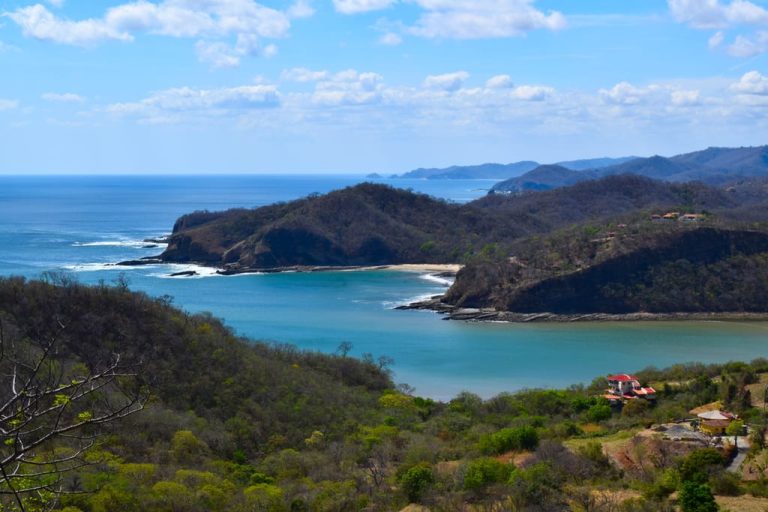
Costa Rica vs Nicaragua: Which Country Should You Visit?
So, you’re heading either to Costa Rica or Nicaragua!
As if narrowing it down that far wasn’t hard enough, now the real work begins: which one of these gorgeous Central American countries will you travel to?
As amazing as both destinations are, picking one can come down to a matter of travel style and personal preference.
Here are some of the differences to help you answer the question: Nicaragua or Costa Rica?
Table of Contents
Costa Rica vs Nicaragua: The Differences
Nicaragua vs costa rica: the similarities, safety in costa rica vs nicaragua, costa rica or nicaragua: the final decision, planning a trip.
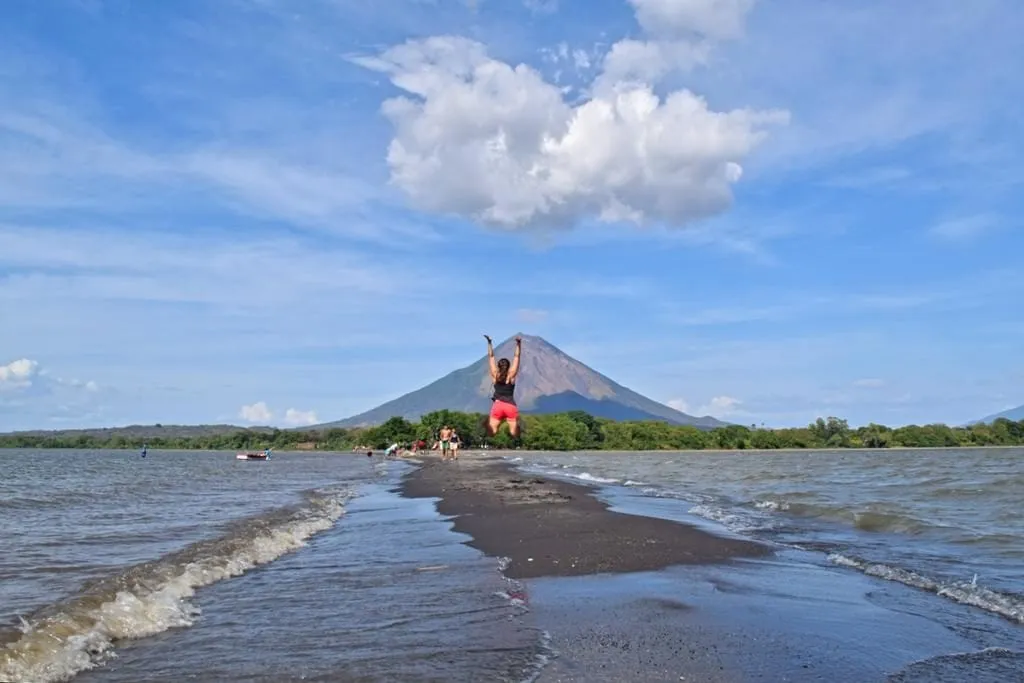
Some links in this post may be affiliate links. If you make a purchase through one of these links, we may earn a small commission at no extra cost to you. Please see our disclosure policy for more detail.
(It is important to note that I wrote this blog post before the civil unrest that impacted Nicaragua starting in 2018. Travel has since returned to the country–I wrote more updates about the safety situation here –but our personal recollections pre-date the unrest).
In Costa Rica, you can expect…
… more tourism infrastructure..
There’s no question about it: tourism is big business in Costa Rica, in a way that Nicaragua hasn’t really mastered yet.
While you certainly won’t have any shortage of tourist-friendly options in Nicaragua, Costa Rica has a simply overwhelming number of day trips, transport services, tours, and more to guide you through as much or as little of your trip as you could hope for.
From Arenal to Tamarindo and beyond, there are an overwhelming number of beautiful places in Costa Rica that are also relatively simple to access.
If it’s your first time outside your home country, or you’re on a family trip , this alone might be a big enough draw to pull you to Costa Rica.
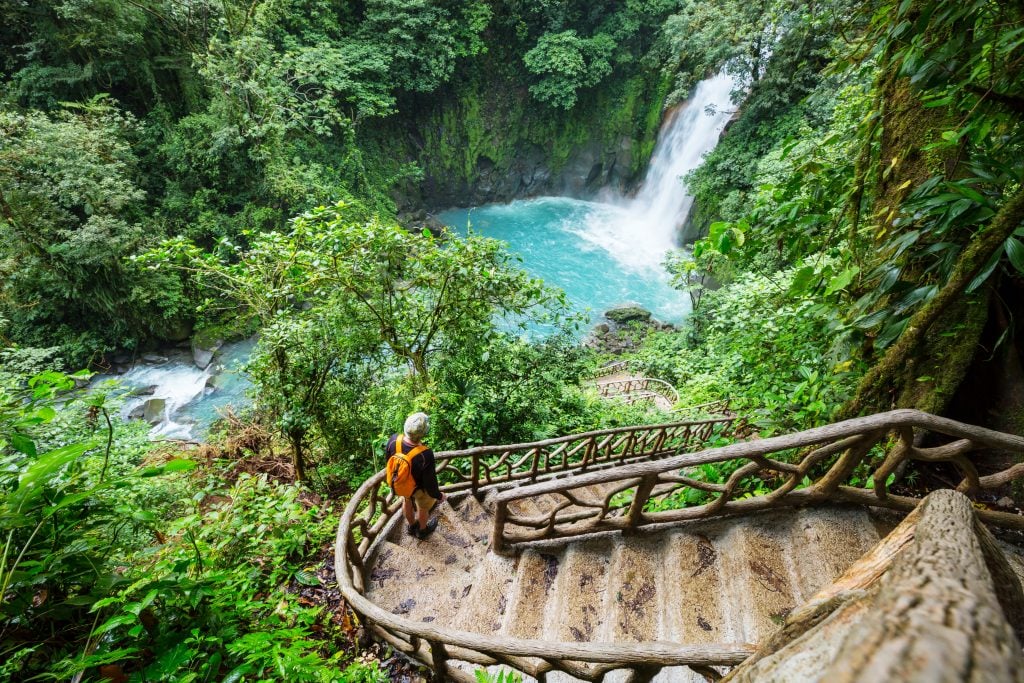
… more crowds.
The flip side of all that infrastructure? More crowds.
Costa Rica is officially on the list of places that have been discovered by big tourism, and as a result, national parks and other highlights can get crowded quickly–especially during the high season.
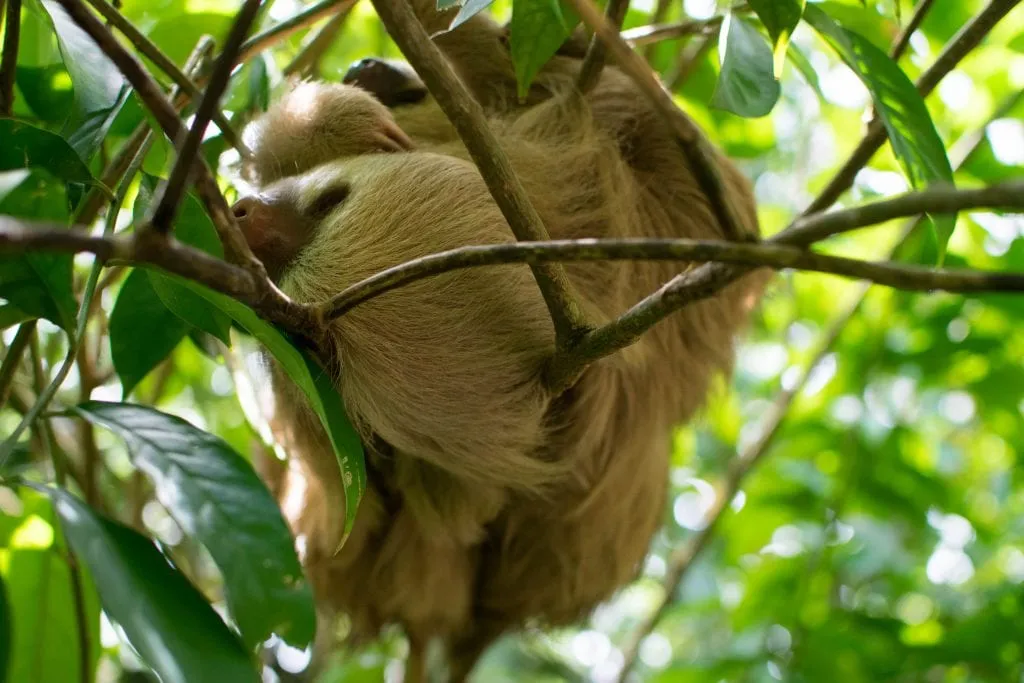
… higher prices.
More infrastructure, more crowds… it’s no surprise that this leads to higher prices.
Since Costa Rica is located in Central America, it’s easy to the impression that Costa Rica can be a bargain to travel through, but generally speaking, that is a mistake.
While you can save some money by taking local transport, shopping for some of your own meals, and staying in less expensive lodging, prepare to budget the same amount here that you would to travel in most parts of Central Europe .
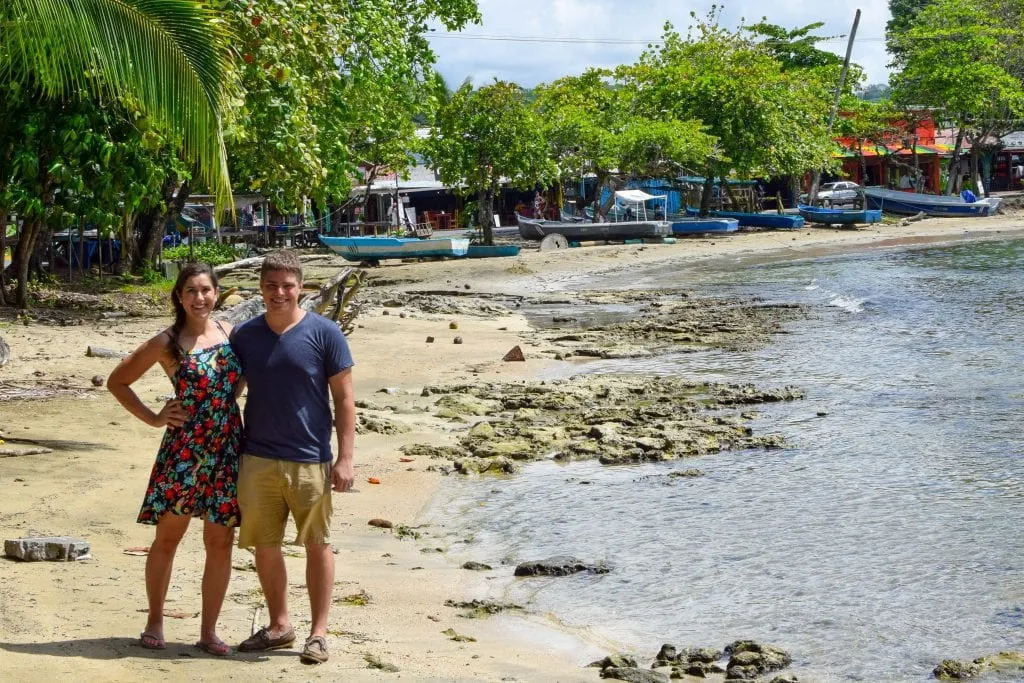
… more English speakers.
Partially as a result of all of the tourism infrastructure, you will find far more English speakers in Costa Rica than in Nicaragua.
Spanish is still very much the preferred spoken language of most of the population, but if you’d prefer to work with employees in the tourism industry who speak English, your odds go up by being in Costa Rica instead of Nicaragua.
Whichever country you travel to, however, we’d recommend learning at least some basic Spanish before you go–both you and the locals will be glad you did!
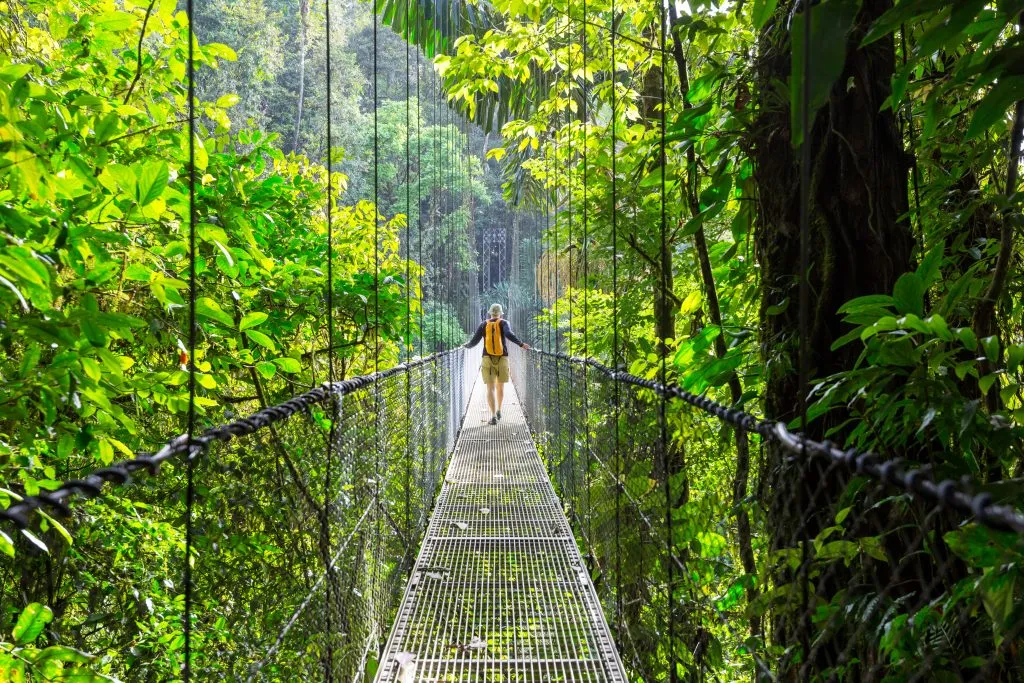
In Nicaragua, you can expect…
… significantly lower prices..
Considering that Nicaragua and Costa Rica offer many of the same natural highlights, it’s almost astonishing how different the prices are.
While Costa Rica requires a budget similar to that of a Central European country, Nicaragua is much more in line with other countries in Central America like Guatemala and Honduras .
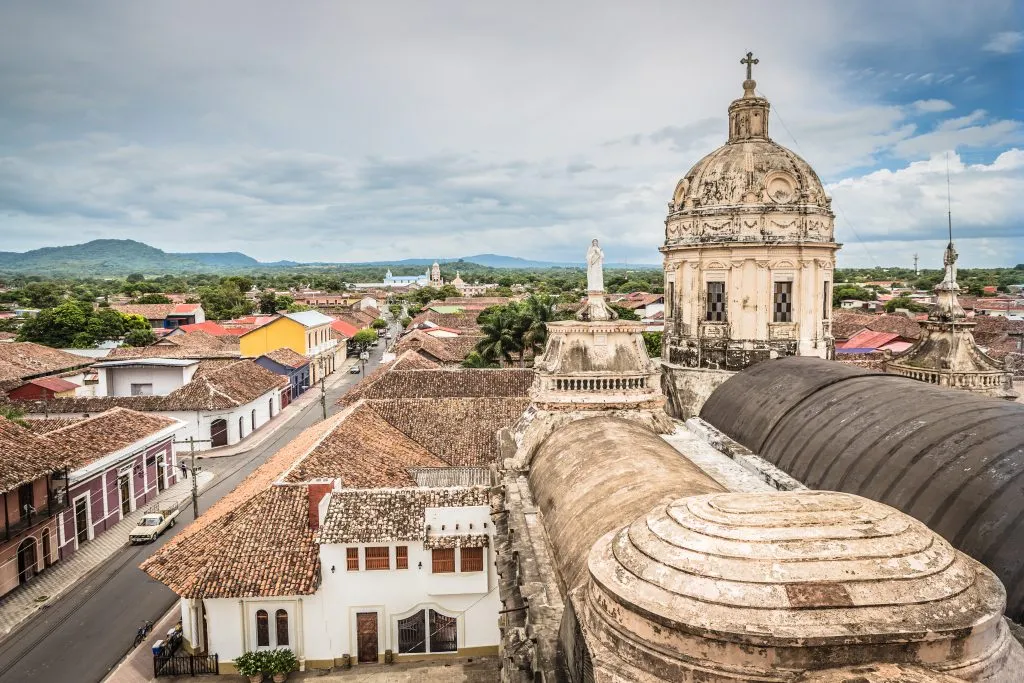
… fewer tourists.
While there is an established gringo trail that passes through Nicaragua (more or less concentrated in Leon, Granada, and San Juan del Sur, and to a lesser extent in Isla de Ometepe), the luxury properties and high-end resorts in Costa Rica are not present in Nicaragua.
While you will definitely see plenty of other tourists in Nicaragua, the bulk of them will be from other Central American countries, and most tourists from outside the region being backpackers and younger travelers who are traveling through Central America.
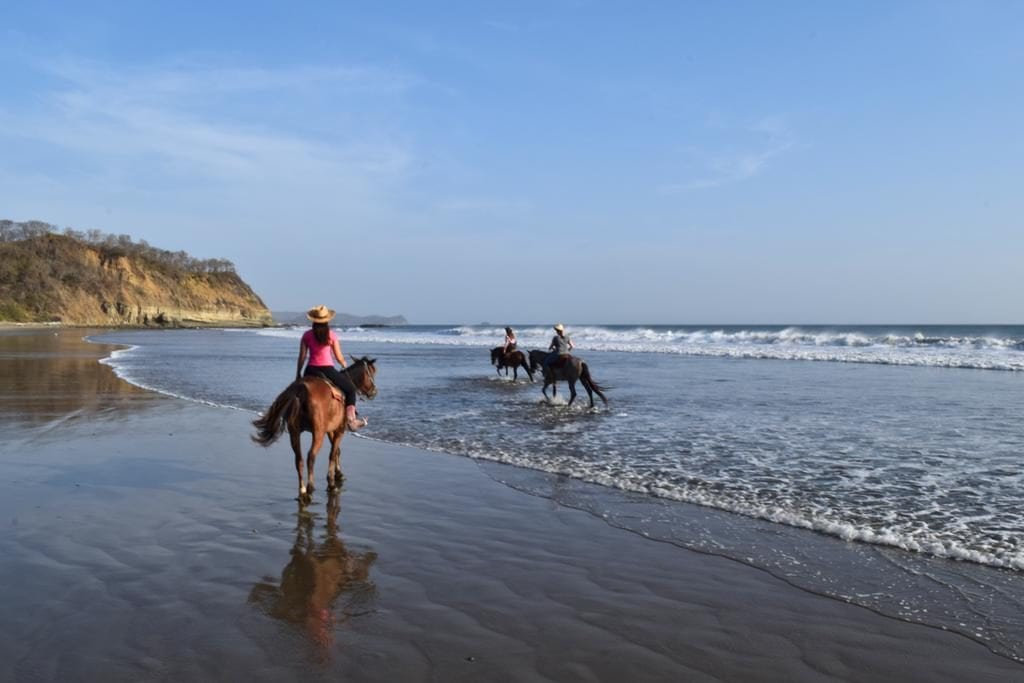
… More active volcanoes.
Nicaragua holds 19 active volcanoes to Costa Rica’s 6, and you’ll have plenty of opportunities to get up close and personal with them.
Whether it’s climbing a volcano on Isla de Ometepe, volcano boarding (basically sledding) down a volcano outside Leon, or peering into the lava-filled crater of a volcano at night near Granada, you will not leave Nicaragua without an incredibly memorable volcano experience if that’s what you’re after.
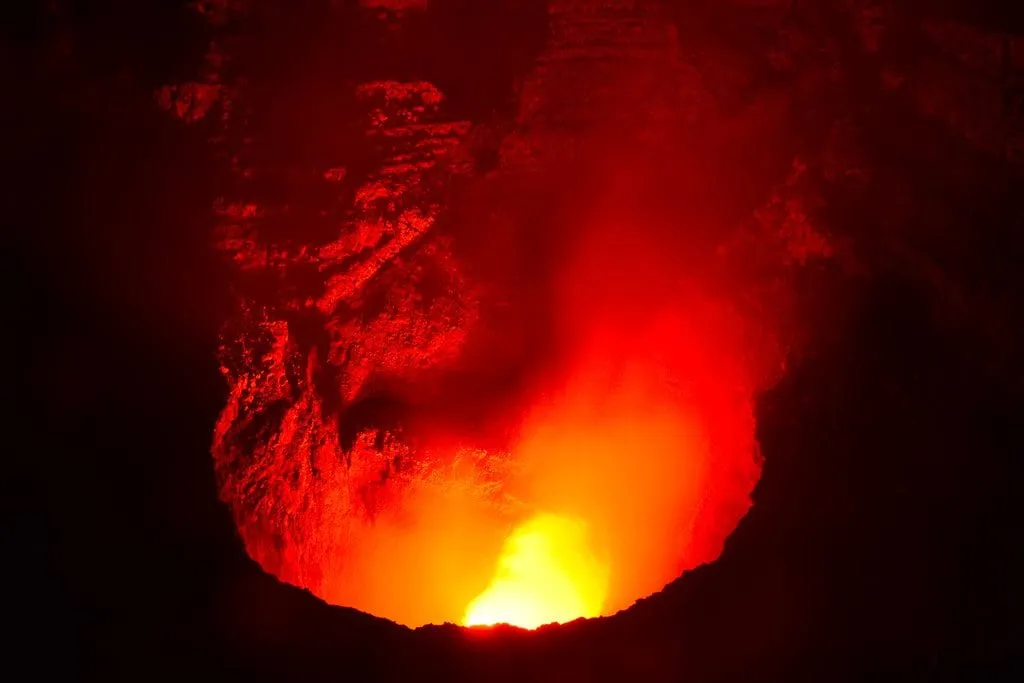
… the quirkiness of chicken buses.
And, really, all of the cultural quirks that come with them.
Costa Rica is a beautiful place, but in many ways, it didn’t feel quite as adventurous or exciting as being in Nicaragua, where decked out colorful buses drive you across the country for a couple of dollars and the desayuno tipicos in the markets come with a flourish, a smile, and a huge scoop of gallo pinto.
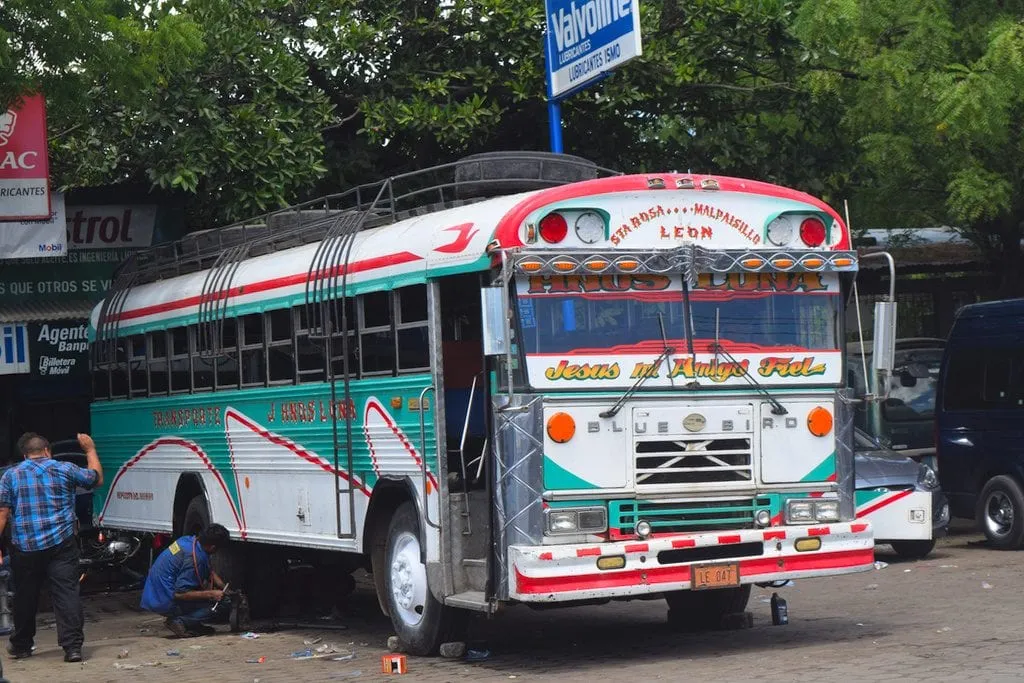
This, we readily admit, is partially our fault: we didn’t try hard to find offbeat Costa Rica away from the tourist trail, as we spent most of our time there with family.
But that’s the thing: in Nicaragua, we never had to go looking.
Even in very backpacker-heavy towns like San Juan del Sur, the area still had a very distinctive, Nicaraguan feel to it–something lacking in Costa Rica, which still ranks as the only country outside the USA in which we’ve ever seen a Taco Bell.
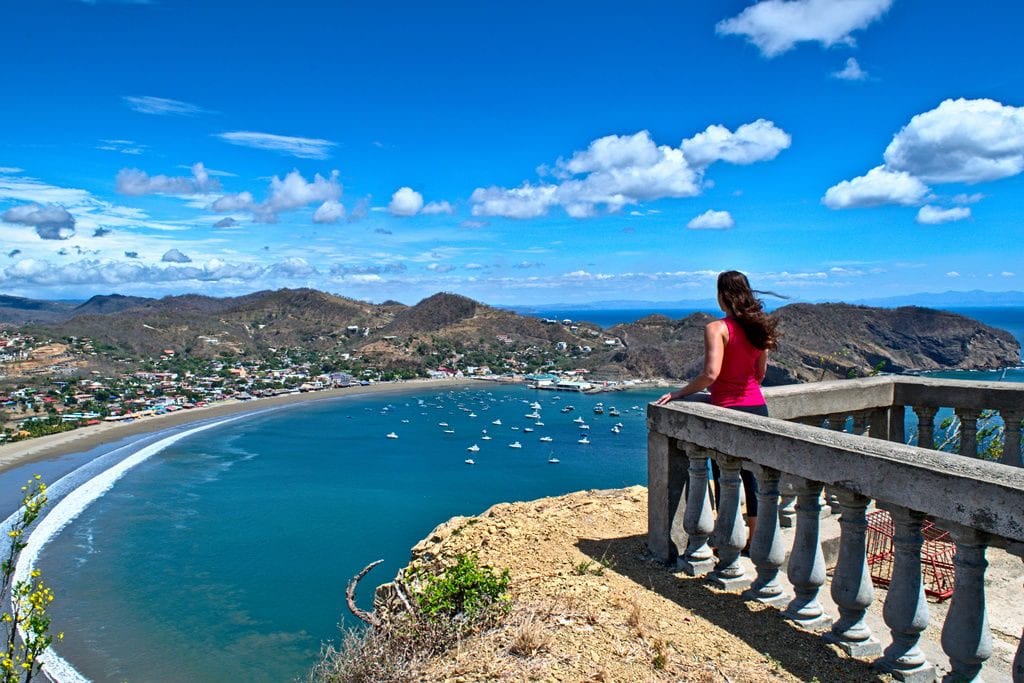
In both Nicaragua and Costa Rica, you can expect…
… adventure activities galore..
Volcano hikes, ziplining, kayaking, scuba diving, surfing, horseback riding… as pronounced as the differences between the two countries seem when deciding between putting together an itinerary for Costa Rica vs Nicaragua, the truth is, the two countries have far more similarities than differences when it comes to what kind of trip you will plan there.
Whichever you choose, you definitely won’t run out of fun things to do in Costa Rica or Nicaragua!
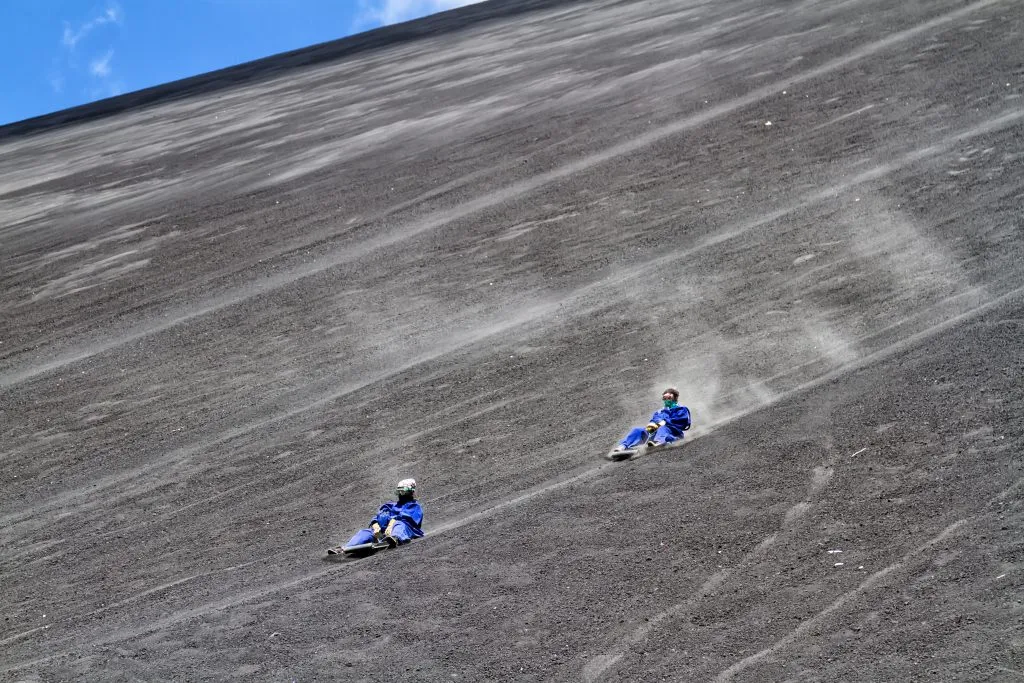
… beautiful beaches.
Whether you’re drawn to the wild Pacific coastline or laid-back Caribbean beaches, you will have plenty of options to choose from in both Costa Rica and Nicaragua!
In Nicaragua, we visited amazing Pacific beaches in and around San Juan del Sur, and have the Caribbean paradise of Little Corn Island on our wish list for next time.
In Costa Rica, we spent time in laid-back Caribbean Puerto Viejo, and have our sights set on the beautiful Pacific Guanacaste region ( Playa Junquillal looks delightful, for example) for our next visit!
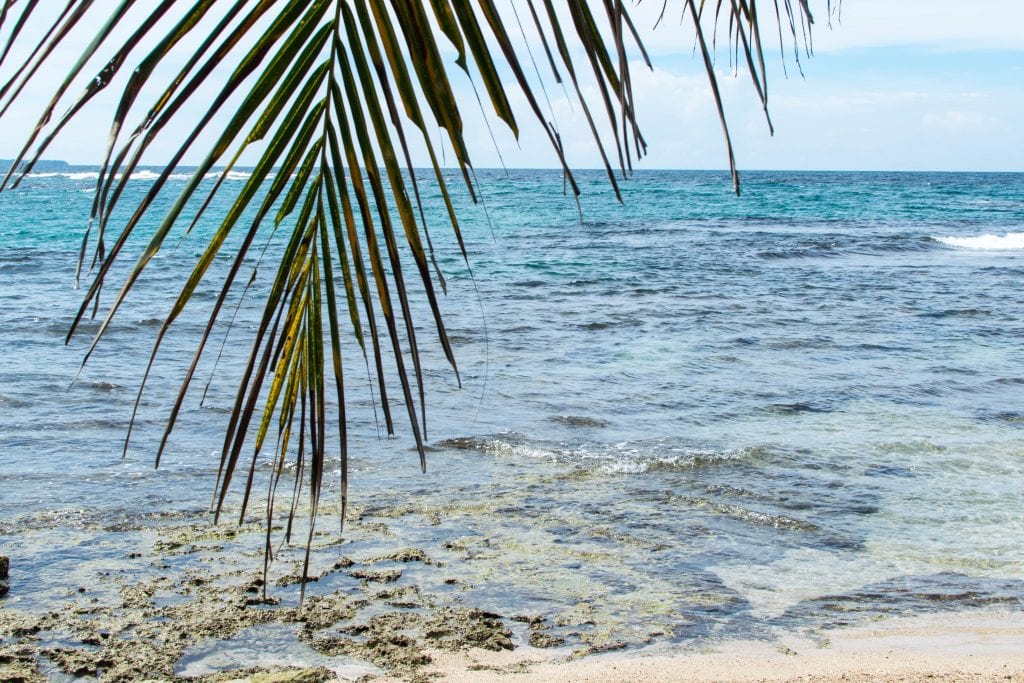
… acceptable food.
Sorry, guys–no one comes this far south in Central America for the cuisine!
There’s a saying among travelers in the region that the food is amazing in Mexico and gets worse the farther south you get, and we definitely agreed: Mexican food is delicious, Guatemalan food was great, and it is basically downhill from there.
You won’t starve, and there are several tasty Nicaraguan and Costa Rican foods , but we don’t sit around daydreaming about the cuisine in Nicaragua or Costa Rica either.
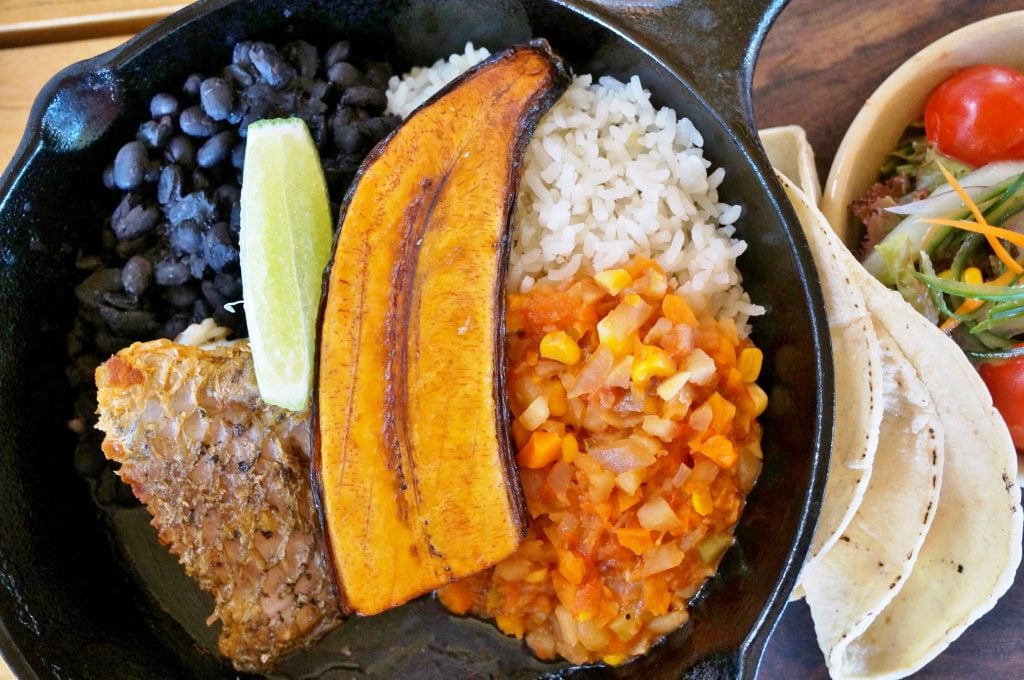
Technically, crime is lower in Nicaragua than in Costa Rica–especially petty crime, which always has a tendency to show up in places where hoards of tourists congregate.
However, we felt extremely safe in both countries, and both felt far more secure than Honduras or even Guatemala (which ranks as one of our two favorite Central American countries).
Though unpleasant situations can occur anywhere, if you take normal precautions and behave with discretion, there’s no reason to think you’ll attract trouble in either Nicaragua or Costa Rica.
That being said, one of our normal precautions when traveling is to purchase travel insurance from Safety Wing , and we definitely wouldn’t visit Costa Rica or Nicaragua without it!
Check prices for Safety Wing Travel Insurance in Costa Rica or Nicaragua!
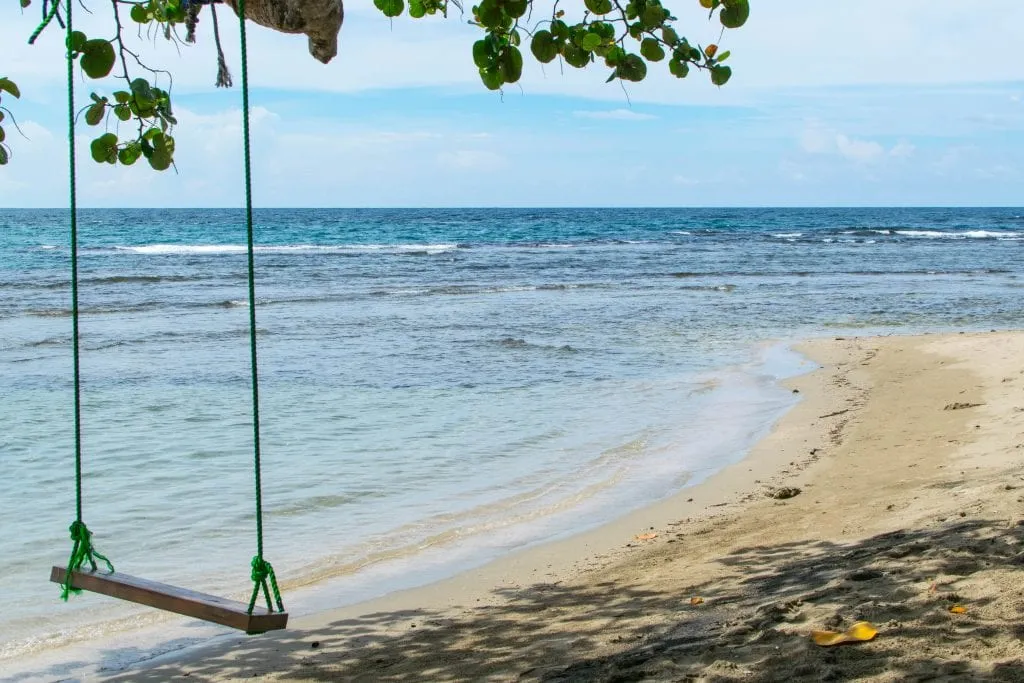
Personally, we greatly preferred traveling in Nicaragua vs Costa Rica.
We loved the culture, we loved the landscapes, we loved the adventure, we loved the cities and towns… and we also really, really loved the prices.
When we arrived in Costa Rica, it was after spending about 4.5 months backpacking south from Mexico City, passing through Mexico, Belize, Guatemala, Honduras, and Nicaragua along the way, and the sticker shock when we arrived in Costa Rica was enormous.
Prices appeared to almost double as soon as we crossed the border, and the most noticeable thing about it was the other than that… not much had changed.
In other words, Costa Rica provided a similar value with similar experiences to what we saw in Nicaragua, they just charged a lot more for it.
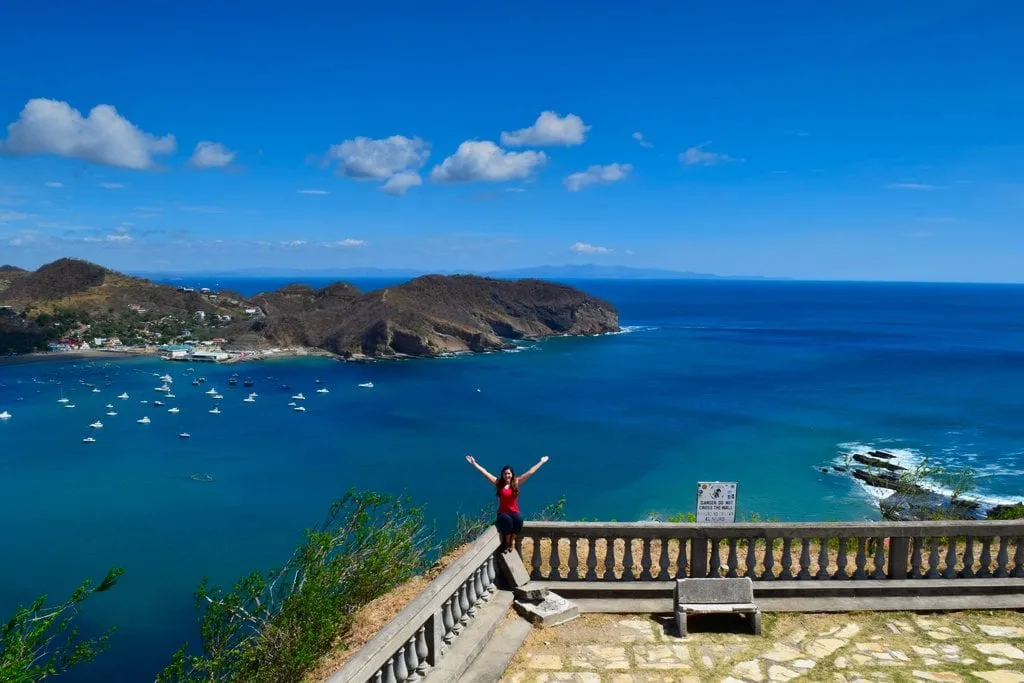
True, the greater tourism infrastructure and English-speaking presence, along with Costa Rica being the more popular destination for international travelers, all contribute to this, but after spending months in the region, we didn’t value those things enough to consider the extra cost worth it.
For people who are less accustomed to traveling in Central America or within the developing world in general, those tradeoffs may be absolutely worth it!
That is a completely valid option, and Costa Rica is absolutely a country worth exploring.
We don’t want to be negative about it, because it’s an incredibly beautiful place with lots to offer–but for travelers like us who prefer to be a tiny bit more off the beaten path in exchange for lower prices and less crowded adventures, Nicaragua is the clear winner in the contest of Costa Rica vs Nicaragua.
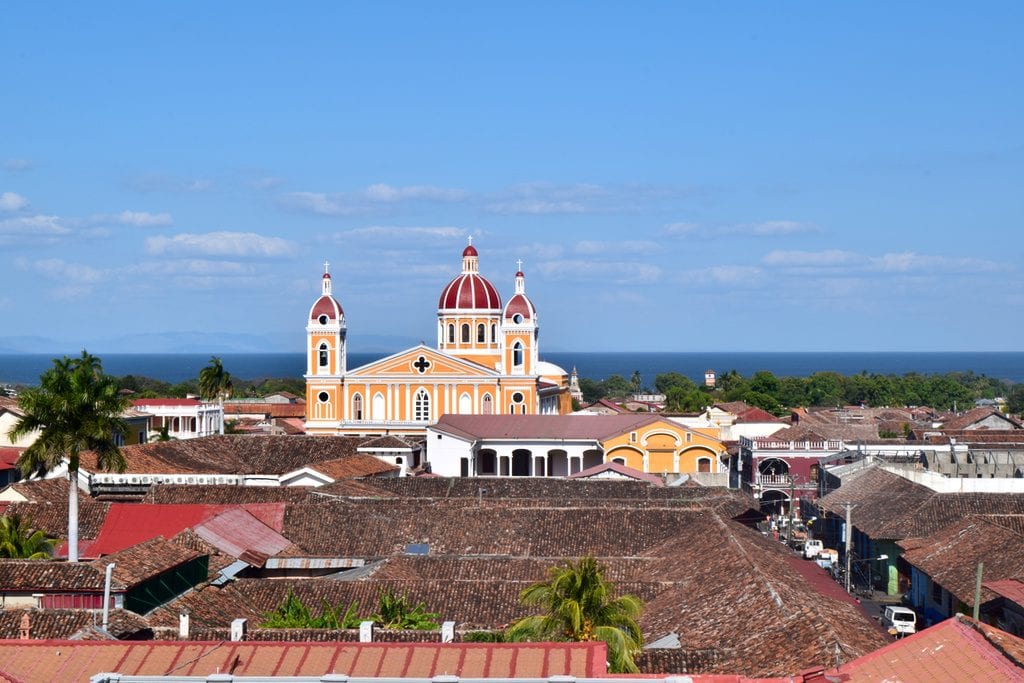
Subscribe to our newsletter to follow along with our travels and to receive tips and new content via email!
We won’t send you spam. Unsubscribe at any time.
About Kate Storm

In May 2016, I left my suburban life in the USA and became a full-time traveler. Since then, I have visited 50+ countries on 5 continents and lived in Portugal, developing a special love of traveling in Europe (especially Italy) along the way. Today, along with my husband Jeremy and dog Ranger, I’m working toward my eventual goal of splitting my life between Europe and the USA.
41 thoughts on “Costa Rica vs Nicaragua: Which Country Should You Visit?”
My sister is heading to Costa Rica for the first time in May and she has never left the United States so needless to say she is a ball of emotions. I just showed her your blog post and all this great information really helped her to start researching all her questions/fears/worries etc.
Absolutely great post!
Oh, how exciting for your sister! Of all the Central American countries, Costa Rica is absolutely the best one for a first trip outside the USA–I hope she has an amazing time!
Little Corn Island sounds so sweet as do the other beaches here! Even though the food culture doesn’t sounds great in Nicaragua, I’m still sold! In fact, I’m planning on visiting this year, so I really can’t wait. Saying that, I wouldn’t turn down a trip to Costa Rica either, it looks so beautiful!
Hope you have an amazing time in Nicaragua! Not making it to Little Corn Island was a sad point for us–hopefully we get there next time!
Make sure beaches aren’t littered with garbage – before going- which drifts in with the tides and not put there by the locals!
Loved the way you have laid out all the facts of both these countries. It makes things easier for any traveler not just to choose between the 2 but also know what to expect. I personally found both these countries intriguing though Nicargua being cheaper would be the first one i would like to head to.
Cheaper is always such a temptation! Lol.
NICARAGUA IS BETTER THAN COSTA RICA AND CHEAPER, PLUS THE PEOPLE THERE ARE SO MUCH FRIENDLY, !❤❤ NICARAGUA!!!!!!❤ I loved it there and yes been to Costa Rica!
Costa Rica sounds a great place for those surreal beaches and plenitude of adventure activities. While we try to avoid the touristic places, Costa Rica having more English speakers definitely makes the trip easy. We haven’t visited an active Volcano yet but Nicaragua having 19 active volcanoes and less crowd surely makes for one of the top reasons to add it to the bucket list.
Makes for a hard choice, right?! At least they’re easy enough to visit together if you can’t choose. 😉
Awesome pictures.. totally loved them. If its a matter of lesser prices, lesser crowds & active Volcanoes then my vote is hands down for Nicaragua. I haven’t been at an active volcano site so I am sure it will be a great experience.
Active volcanoes are definitely an incredible experience! We’ve been to a couple, and it never gets old seeing the Earth come alive like that.
This is a great breakdown between the two countries! I love Central America, and like you mentioned, each country has its own quirky, you simply have to identify which one suits you best. Personally, I love both of these countries equally for different reasons! Happy travels!
It definitely is all down to preference–there’s not a bad option on this list!
Great comparisons of pros and cons on choosing between Costa Rica or Nicaragua. Costa Rica or Nicaragua have similar beauty but they differ in infrastructure, more crowded, crime -rate and Language barrier. As Nicaragua is less crowded with less crime rate, I would prefer it, though it is slightly offbeat. For me including Steripan in my packing list, is most essential item during planning a trip to Costa Rica or Nicaragua.
Thanks, Yukti! It definitely is a hard call depending on what you’re after, but you can’t go wrong either way!
Good decision, congrats ,Nicaragua is the best country of Central America because is safest, kind people and beautiful places to visit.Nicaragua full of volcanos , beaches , and rich food and fruits.
That’s a beautiful comparison between the 2 countries. I’m connecting it to the comparison between Brugge and Ghent in Belgium! Nicargua is totally my kinda place than Costa Rica. That said, I don’t know if I’ll ever get to visit the American continent. Till then, thanks for your virtual tours!
Thank you! Yes, I love writing compare/contrast articles–mostly because I’m always looking for similar content when making travel plans!
This was a very interesting and helpful comparison from a traveler’s perspective. I have not been to both the place but now I know both and can pick if I have to choose. Costa Rica for the beaches but Nicaragua for its active volcanoes. And who doesn’t like less prices and less crowd.
Lower prices and fewer crowds are always a draw, right? 🙂
That too countries have beautiful places but have you been at any time in Honduras? Trujillo, Roatan, utila, Copan Ruinas those are amazing places that you will no find in Central America even in Mexico. I invite you to visit Honduras!!!!!
Thanks, Jose! We have been to Honduras and greatly enjoyed it–we visited Copan Ruinas, Utila, and La Ceiba/the Cangrajel River Valley. I’d hesitate to recommend mainland Honduras to first-time visitors of Latin America, though–it doesn’t have quite the beaten path that Nicaragua and Costa Rica do, with the exception of the islands! 🙂
I have been to Copan Ruinas , La Ceiba, the Jungle River Lodge on the Rio Cangrejal nearby, and about two weeks on Utila, where I got my SCUBA certification! Beautiful place Honduras!
I have spent substantial time in both Costa Rica and Nicaragua. I have air transport to Nicaragua booked for January 2019. We are currently trying to rebook flights to somewhere else.
It is important to point out that there is a currently a lot of political unrest in Nicaragua. There has been a lot of protests involving violence, and an estimated 250 people killed. Rotating national strikes are impacting transportation and supply lines. Numerous countries, including Canada, have issued travel advisories recommending no tourist travel to Nicaragua.
Let your own sense of adventure be your guide. But please do some research in advance of heading there.
Yes, we have been following the situation as well and are sad to see how much the situation has deteriorated in the last few months.
I certainly hope things have improved substantially by next January, but you never know.
If we were to pick one Central American country to head to for a return visit tomorrow, it would be Guatemala (a close second to the Nicaragua of 2017 in the region for us).
Things have settled down more now. I’m heading there for a couple weeks in July!
How was your trip Mark?
Very interesting this article. I like both places . In my opinion, I am looking for something more adventure, exacting, and of course cheaper and safety. I will visit Nicaragua ?? can’t wait to do visit this beautiful country
Have fun! I feel obligated to mention (you are probably already aware) that Nicaragua did have some serious instability after I wrote this post. My understanding is that things have died down a lot and that tourists are starting to return, but we haven’t been back personally.
Enjoy & stay safe!
The pictures are utterly beautiful. Visiting volcanoes of Nicaragua post covid pandemic seems like a plan.
Sounds like a great plan to me!
Kate & Jerry, I think you forgot couple of things: 1.Security in CR is way better than Nicaragua 2. CR got several alive volcanos, w the Arenal as the most beautiful of America. 3. Around each tourist attraction, you can find dozens more. Not in Nicaragua. 4. CR got 1,200 beaches well a conditioned for tourism. Nicaragua ONLY about 10, yes that few. 5. Cheap sometimes is the most expensive way. 6. Those buses that you showed, are really a very dangerous option. Too old and w irresponsible drivers.
COSTA RICA IS A 100% better. How many volcanos you can visit on a week trip? No thank beaches are full of plastic staff,
You sound like backpackers, for you most beaches got accondionated spaces, with showers and toilets facilities. Never in Nicaragua. So, I think you should’ve to see more CR, before make a blog about it. Don’t get me wrong, I like cheap prices too. But sometimes you need to find a decent budget for food. If you don’t want to cook. Example: The ONLY beach in Nicaragua, with decent infrastructure, is San Juan del Sur, and prices there are expensive or similar to CR.
Denis, You sound like a jealous Costa Rican. Relax. Both countries are awesome. Crime, by the way, is much lower in Nicaragua. Google it. Yes, tourism infrastructure is less developed in Nicaragua but the article is not about how many 5 star hotel there are. I’ve been to plenty of beaches and accommodations are plenty in Nicaragua.
As a person who traveled between both countries frequently I can tell you this. Nicaragua is definitely the cheaper place. Your dollar will go far down there. Costa Rica has become a travel Mecha destination for central America. It’s got the best water system of any country down there and it is expensive. That being said you get what you pay for. I’m not sure where you got your numbers from with crime rates but I would never under any circumstance walk around by myself in any part of Nicaragua after dark. Costa Rica on the other hand I have taken family out for late night beach walks. The people are more friendly and you don’t have that vibe where you gotta look over your shoulder periodically.
I don’t think, so because I personally have done many journeys to Nicaragua, and my family and I have enjoyed all the night in different places and city of Nicaragua without any problem ; in addition we have done the best tourism of our live. The rich foods and fruits, beautiful beaches, nice people, safe and comfortable places to rest after a full day of diversion.I invite you connect with the best country of Central America”Nicaragua”, and discover the beautiful that it has to offer every day.
Interesting article… I am from Costa Rica. Nicaragua and Costa Rica are amazing because we share similar micro climes, volcanos, beaches, but let me give you some insights for Costa Rica. On top of what I read, Tourism is our Gross Domestic Product main Source so we must be ready to receive international visits, that means investment in touristic infrastructure, security, education, hospitals, etc. 27% of territory are National Parks & Reserves. One of the best Health systems in the world. CR was rated in 2019 happiest place in the world. Life expectancy is 79 years. Safest country in Central America. All these represents higher cost but we definitely need to improve on that. One tip; nowadays security has changed worldwide so please don’t leave your belongings unattended, don’t show laptops, cameras, don’t leave alone at night, etc. You can get great food with affordable prices wherever you go but please ask to locals. In my country you can find hight mountains (12.500′), savanna, beaches, volcanos, bird/whales sighting, rain forest, etc. I hope you can enjoy your trip to any place you choose!
Your blog post is awesome! From ages 18-20 I had the opportunity to live in Nicaragua for two years! Some of the best years of my life! I was just a young teenager from SLC, Utah. Haha. I went there knowing essentially nothing of spanish but “como estas” and “hola.” After the two years, I came to speak fluent spanish and gained amazing friends and I absolutely love the people. I can confirm the beauty of nicargaua as well. I can also confirm the “cheapness” of nicaragua as well which is awesome how far your money can go. I still want to visit costa rica one day because I have heard great things. I didn’t know it is as expensive as traveling in central europe which was a big surprise to me after reading your blog! Thanks for the awesome comparison!
Nicarguan here, I just went went to Costa Rica, basically San Jose. The infrastructure is great, but it is very expensive. I live in Nicaragua and the food ,volcanos, Lake Nicaragua and the beaches are stunning and everything is cheaper. The crime rate is lower. In 30 years, I had only experienced one incident. In Los Angeles I also was victim of a assault, so there you go.
Leave a Comment Cancel reply

Getting Around Costa Rica
There are many ways to get around Costa Rica- which is good because despite being a small country, Costa Rica has big distances.
For example, you may want to go from San Jose to La Fortuna. Put it in Google Maps and it’s only about 80 miles. But what you don’t see are all the curvy two-lane roads, stops, and other road conditions that might arise while taking what turns out to be an almost 3-hour drive. Driving in Costa Rica can be its own beast.
That’s one reason why it is so essential to pick the right way to get around Costa Rica when you are visiting- especially if you are visiting Costa Rica with kids as we do.
In this post, I’ll walk you through all the different ways you can get around Costa Rica. My vote? If you are exploring Costa Rica with kids and need both flexibility and a good bang for your buck, I recommend car rental. If you have a larger budget or a large group, then definitely opt for a private shuttle with a tour guide.
Arriving in Costa Rica
Costa Rica is well connected both through its international airports and international bus systems from Nicaragua and Panama.
When you arrive at either the San Jose Airport or the Liberia International Airport , you’ll find flights coming in from around the world- just like you would at any major international airport. If you need to know which airport to fly in to, it depends on where you are going after you arrive.
Land crossing in Central America between Costa Rica and either Panama or Nicaragua is also common.
You’ll need a valid passport to enter the country, and tourists from most countries are allowed a 90-day tourist visa automatically upon entry.
The issue is- how do you get around once you arrive?
Domestic Flights
If you are heading to some of the more remote areas of Costa Rica, and have the budget, then taking a domestic flight is a great option. I usually recommend these flights for people going to popular destinations such as the Osa Peninsula (Corcovado National Park), Puerto Viejo or the Caribbean coast, or remote areas like Tortuguero National Park.
You can also consider a domestic flight from San Jose to Guanacaste, although do keep in mind there is now a bustling international airport in Liberia . The domestic flights are done with a pretty small plane, so if you are a nervous flyer these are probably not the best option.
Have a big group or a big budget? Consider chartering a private plane to your destination. You can also do private helicopters. I have to say I have never done these, so am not a good resource on how to do them or the costs. It is an option, though.
Renting A Car
Renting a car in Costa Rica is the best option in my opinion, and we recommend renting from Adobe Rental Car. This is because you’ll pay less overall, support a local company, and they have the best customer service of any rental car company around. (And after 20 years of renting cars in Costa Rica, I’ve tried them all!) You can also get a 10-20% discount on your rental car through Pura Vida Moms.
You have to keep in mind a few things when renting a car, however:
- Your credit card insurance won’t cover the mandatory insurance in Costa Rica, so make sure to get a quote that includes insurance
- The car seats provided are not great as they are old and only 3 point harnesses so I take our own
- Gas in Costa Rica is more expensive than in the States and is sold by the liter. The good thing is that gas prices are fixed across the country, so you don’t need to play the gas game as you do in the US.
- You’ll need a navigation app for Costa Rica- whether you purchase a GPS with your rental car or use your cell phone, it’s a must.
I’ve written extensively about driving in Costa Rica and renting cars in Costa Rica , so please refer to those posts for more info.
Direct Transfers
You can hire a direct transfer (Adobe Rental Cars even does them) from point A to Point B. There are two types of direct transfers, private and shared.
Shared Shuttle
A shared shuttle means that you and a few other people (usually no more than 15 total) will share a bus that goes from one place to another. The advantages are that these are much faster than a public bus, and worth the money especially if you are a solo traveler who wants to get somewhere quickly, safely, and without hassles.
Another advantage is if you are doing what is called a tour connection where you are rafting from Point A to Point B, for example. This is common for those who choose to take a boat across Arenal Lake from Monteverde to La Fortuna to drastically cut down on travel time.
The disadvantage to a shared shuttle lies in the advantage- you will go from Point A to Point B and that’s it. Comfort stops for the bathroom and snacks are kept to a minimum, and you are in the shuttle with people you don’t know.
We use shared shuttle buses when we are going ot a walkable destination where we won’t need to get around much farther than the town center. A great example of those would be in Tamarindo, San Ramon, and Grecia. La Fortuna would not be a great example as everything is spread out.
Some people who hire shared shuttles will then use Uber or taxis when they arrive at their destination. Of course, this does add cost to the overall trip, which is why many times renting a car is cheaper for small groups.
Join the Costa Rica With Kids Facebook Group. Ask all the Costa Rica Travel questions you want- we will answer them!
Private shuttle.
This is essentially where you hire a private driver to take you exactly where you want ot go when you want to go there. You have shuttle services on demand for your whole trip. You can also hire a private guide in this instance as well, and the guide and driver work together.
A private shuttle is the more expensive option of the two, but for large groups, the cost per person can actually be less when you add up all the transportation costs.
If I had an unlimited budget and could hire a private shuttle and guide for every trip I went on to Costa Rica, it’s definitely the option I would pick. It’s not always feasible, however.
Costa Rica By Bus
Many many travelers want to see Costa Rica by public transportation, and public buses are definitely the absolute cheapest option (other than hitchhiking which I don’t recommend!).
There are two different types of buses that interconnect Costa Rica: direct buses ( bus directo ) and indirect buses, or colectivos . Here’s a bit on each:
Direct Buses
You can get on a bus that will go directly to your destination with very few stops. These buses will generally make one restroom stop at a public place where food and drink are sold. They will generally do this every 4 hours. A great example of this is the bus from San Jose to Liberia that stops in Esparza.
Direct buses adhere to a strict schedule and are not late. If you miss the bus- you missed the bus.
These buses tend to get crowded as there are both seats and people who are able to stand in the aisles while the bus is in motion. When the bus stops people generally get off and come back to their same seat. You need to watch your hand luggage in this case, as thieves know to target these bus stops.
For families with kids, direct buses are the best way to get around if you absolutely want or need to ride the bus. Keep in mind there are no toilets or food on board, and there isn’t entertainment.
The colectivo busses generally go shorter distances. They stop at each bus stop and pick up or let off passengers as needed. You can just ring a bell and the bus will stop. If the bus driver sees people flagging him down on the side of the road to stop, he will do so.
It’s a very slow way to travel- it’s also cheap. It can be fun for a while to meet new people on the bus and see the types of people that come and go, but honestly, if you don’t have much time, this can be a real test of patience.
For example, the local buses that go between San Ramon and Palmares (a distance of 5 km) can take up to an hour.
If you are looking to plan a Costa Rica trip via bus, I highly recommend the Costa Rica by Bus Facebook group .
Taxis are everywhere in Costa Rica as there are so many people without cars who live there. There are several types of taxis you can take, and note that it can be nearly impossible to get a local taxi when it’s pouring rain.
Note that the airports have official taxis that are to take people to and from the airport- these taxis are orange.
There are red taxis all over town in Costa Rica. The red taxis mean that the government has insured and licensed the taxi drivers and that they have a set fee for transport between destinations.
These taxis are metered (by what we call la maría). You simply ask the driver to start the meter, and when you arrive the fee for the ride is displayed. Most local taxis take a credit card, but not all so it can be good to have some cash on hand when traveling via taxi.
Taxi Pirata
These “pirate taxis” are not officially bonded and insured by the government. Therefore, you must agree on a price for your destination before you enter the vehicle. When you take a pirate taxi, you will generally pay less than you will for a red official taxi.
You also run a bigger safety risk with these taxis as they are not overseen by a dispatch. Some are, and you will find collective taxis that are “pirate” but run by a dispatch.
these taxis can be hired out for a half day or a day, and this can be an economical way to get around a destination if you don’t rent a car.
In large metropolitan cities and urban areas in the Central Valley (think San José, Heredia, Cartago Grecia, San Ramon, Palmares) you can find an Uber pretty easily. uber is generally cheaper than taxis, and you have the advantage of not having to exchange money because you pay in the app.
I think some beach destinations like Jaco may also have Uber, but it’s definitely not something that you have everywhere in the country so if you take an Uber to a destination, make sure you can also get home via Uber from that dentitions. For example, when I was at the Starbucks Hacienda Alsacia recently a couple was dropped off by Uber with their luggage so they could take the tour. At the end of the tour, they tried to get an Uber and couldn’t, and it was a huge mess to get a taxi out there to them.
Boats and Ferries
Water transportation is of course popular in Costa Rica, and can be an economical way to get to some remote destinations.
There are boat rides that will take you to remote areas not widely accessible by car. Two examples of those would be to arrive at Drake Bay or at Tortuguero.
There is also a nice boat transfer between La Fortuna and Monteverde.
You’ll also find boats that take you to Isla del Coso for extremely diving, and boats that will take out offshore for fishing, snorkeling and diving expeditions.
Ferries leaving from Puntarenas can be a great way to get your car onto the Nicoya Peninsula without taking a circuitous route. this can connect you with destinations such as the Bioluminescent Bay , Montezuma, Santa Teresa, and more.
The ferry has a really fun atmosphere too- they sell ice cream and beer and some have fun music. You can enjoy a shortcut while you relax and have fun. I think the ferry is a really fun experience for families.
Hopefully, this article has given you some insight into getting around Costa Rica. If you would like to talk to me about a customized itinerary or specific Costa Rica travel advice for your family’s next Costa Rica vacation, (zero sales- just advice!) check out my “ Ask Christa ” page for more information on custom Costa Rica trip planning geared towards family
The post Getting Around Costa Rica appeared first on Pura Vida Moms .
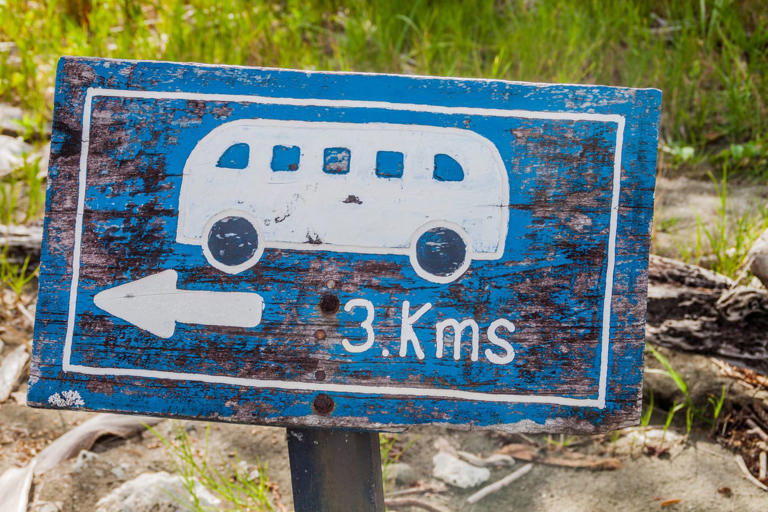
- Latin America
- Expat Living
- Art and Culture
- Science and Tech
- Classifieds
- Advertise with Us

COSTA RICA'S LEADING ENGLISH LANGUAGE NEWSPAPER
How did the Costa Rica President Pay For His House?
Costa rica’s declining press freedom highlighted in us report, costa rica, uae sign economic partnership agreement, why costa rica farmers are going out of business, netflix spends $1.2m on security for costa rica filming, birds of costa rica: meet the gray-headed kite.

What do you get when you combine the broad wings and big body of a raptor with a little curved beak on a small dove-like head? You get the gray-headed kite.
The gray-headed kite (Leptodon cayanensis) is known as the gavilán cabecigris in Spanish. It’s one of the 205 members of the Accipitridae (pronunciation here ) family which is a diverse group of birds of prey characterized by keen vision, sharp talons, and hooked beaks.
Adult gray-headed kites don’t really resemble any other bird in Costa Rica. Three characteristics make it stand out. First, its coloration. It has its namesake gray head, a white chest, and black wings. All solid colors without any overlap. Second, it has a little bean head that, to me, looks like it belongs on a dove, not a bird of prey. Third, it has short legs which often make it look like its belly is sitting on the branch while perching.
Juvenile gray-headed kites are not nearly as easy to identify. That’s because they come in three different color phases that all look very different. There’s a pale morph, an intermediate/rufous morph, and a dark morph. It turns out that the reason for this variety is pretty fascinating.
The juveniles are exhibiting mimicry, which isn’t very common in birds of prey. Each color form resembles a different, larger, scarier bird of prey. For example, the pale morph resembles a black-and-white hawk-eagle and the dark morph looks like a black hawk-eagle. They gain some level of protection from predation by imitating these larger species.
Gray-headed kites are another species with a large range but tend to be uncommon within that large range. Their territory stretches from Mexico to northern Argentina. In Costa Rica, they’re found along the forested lowlands and foothills on both the Pacific and Caribbean slopes.
These birds prefer more mature forests where they perch in the canopy or on the forest edge looking for prey. They eat a variety of prey including reptiles like snakes and lizards, other birds, taking eggs and nestlings of small bird species, and insects, especially the brood of wasps and ants.
I haven’t had the good fortune of spotting a gray-headed kite yet, but I have recorded them a few times with my camera traps. Within the last two months I recorded one in Pérez Zeledón where it settled onto a log above a stream and another investigating a waterhole in northern Guanacaste. A few years ago I had some cameras in Osa where I recorded a gray-headed kite frequently bathing in a wallow made by collared peccaries . Take a look at a few of those clips in the video below and get to know the gray-headed kite.
About the Author
Vincent Losasso, founder of Guanacaste Wildlife Monitoring , is a biologist who works with camera traps throughout Costa Rica. Learn more about his projects on facebook or instagram . You can also email him at: [email protected]

Weekly Recap
Costa rica weekly recap news recap april 21, 2024: plastics, vaping and tourism.

Latest Articles
Expat living: our many houses in costa rica, chaves suggests “lobbying” behind norway’s refusal to help, firefighters battle blaze in caño negro national wildlife refuge, the rise of brazilian funk: anitta, beyoncé, and beyond, the difficulty of enforcing laws on feeding wild animals.


IMAGES
VIDEO
COMMENTS
Do not overstay your visa, Costa Rica and Nicaragua do take this seriously. Nicaragua especially is very strict. Read more Costa Rica travel tips below! Driving in Costa Rica: In depth guide with tips and advice for driving in Costa Rica. Includes safety tips, information about how Costa Ricans drive, road sides, and more.
What companies run services between Costa Rica and Nicaragua? Trans Nica operates a bus from San José to Managua 4 times a day. Tickets cost $30 - $40 and the journey takes 6h. Alternatively, Copa Airlines, World Ticket and Skyway fly from Alajuela to Managua 3 times a day. Airlines.
COSTA RICA - NICARAGUA BORDER CROSSING. Depending on your Costa Rica itinerary or Nicaragua itinerary, you can choose a border crossing that will suit your needs best.In our situation made sense to use Penas Blancas land border crossing as our first destination in Nicaragua was San Juan del Sur, a beautiful place famous for beaches and surfing.. If you travel with a higher budget, it is, of ...
It is easiest to travel from Costa Rica to Nicaragua if you begin your journey in Liberia or San Jose: From Liberia: Grupo Transbasa bus line has direct routes to the Penas Blancas border every 45 minutes from 5am-6:30pm daily. There is a link to their current schedules on their website.
The vast majority of travellers going from Costa Rica to Nicaragua (and vice versa) will travel via the Peñas Blancas border crossing. Across two trips to Central America, we've done the crossing about eight times: sometimes it was planned, sometimes it was to refresh our visa, sometimes it was to return to a cheaper country, and sometimes it was simply because travel plans changed.
The international airport in Liberia, Costa Rica (LIR) is only a 1h20m drive to the Nicaraguan border. It offers a great variety of direct flights from cities in the US, Canada, and Europe. In some cases, especially when coming from Europe, flying into San Jose, Costa Rica (SJO) though 5h30m from the border is the way to go.
Managua (Nicaragua)-San Jose (Costa Rica) - fares are US$28.75 one way or US$57.50 return (prices as at January 2022) Chinandega (Nicaragua)-San Jose (Costa Rica) - fares are US$35 one way or US$70 return (prices as at January 2022) Tica Bus operates buses throughout Central America as well as Mexico.
If you're travelling from Nicaragua to Costa Rica, the likelihood is you'll cross over at Peñas Blancas. Across two trips to Central America, we've done the crossing about eight times: sometimes it was planned, sometimes it was to refresh our CA-4 visa, sometimes it was to return to a cheaper country, and sometimes it was simply because travel plans changed.
Contact the S. Embassy in Managua, located at Km 5 ½ C. Sur Managua, Nicaragua, by calling +505-2252-7104, 7:15 a.m. to 4:30 p.m., Monday through Thursday, and 7:15 a.m. to 2:00 p.m. Fridays. The American Citizen Services unit is also available by email during regular business hours at [email protected].
A typical chicken bus in Nicaragua. In Costa Rica, they are usually a rundown Greyhound-style bus. Step 1: Get to the Liberia Bus Terminal From San Jose. There will be various direct buses to Liberia from San Jose every hour from 6 am to 8 pm. Expect to pay about $8 USD and the trip takes about 4.5 hours.. You can also reserve this one-way shuttle online for around $50 USD.
Nicaragua and Costa Rica have stationed security forces at Harbor Head (also called Isla Calero) at the eastern end of the San Juan River. Nicaragua, Honduras, and El Salvador have maritime and land disputes over islands and access to fishing rights in the Gulf of Fonseca on the Pacific Coast, a closed sea under international law.
Both Nicaragua and Costa Rica are countries rich in natural beauty, where Nicaragua rules in volcanoes, all 19 of them, Costa Rica makes up for it in waterfalls and lush rainforest. ... How to travel around Costa Rica. Costa Rica has so many desirable destinations - an abundance of beach towns, chilled mountain towns and a buzzing capital ...
1. Show your stamped passport to the Nicaraguan office. Walk about 200 metres (660 ft) away from the Costa Rican border to reach the Nicaraguan office, a small stand with an officer inside. Show your stamped passport and answer any questions that they may have. [11] Tip: Don't worry if you aren't fluent in Spanish.
Discover our top five main reasons why Nicaragua is your travel dream coming true. 1. Costa Rica vs Nicaragua: The beaches, waves & biodiversity. All beaches are not created equal. But Costa Rica and Nicaragua share both a Pacific and Atlantic coastline and so in this case beaches are created equal. Whereas the Gulf of Fonseca creates a stark ...
Getting To Nicaragua By Boat. The last option is to take a boat from Costa Rica to Nicaragua. It's one of the most adventurous yet longest ways to get to the country.. You can take a boat from San Carlos port in Costa Rica and travel to Granada, Nicaragua.The entire journey takes 16 hours because the boat stops on many islands along the way. It costs around $10 for the entire ride.
What companies run services between Nicaragua and Costa Rica? Copa Airlines, World Ticket and Skyway fly from Managua to Alajuela 3 times a day. Alternatively, Trans Nica operates a bus from Managua to San José 4 times a day. Tickets cost $30 - $40 and the journey takes 6h.
What companies run services between San José, Costa Rica and Nicaragua? Trans Nica operates a bus from San José to Managua 4 times a day. Tickets cost $30 - $40 and the journey takes 6h. Alternatively, Copa Airlines, World Ticket and Skyway fly from San José to Managua 3 times a day. Airlines.
Nicaragua Tour from Costa Rica. $190 per person. 15 Hours. Tamarindo Tours. Cultural. Nicaragua Tour from Costa Rica - One Day Tour. Book online now! Explore all of Nicaragua's most famous highlights all in one day on this Nicaragua tour from Costa Rica! You will see a dormant volcano crater, the active Masaya Crater, go shopping at the ...
Eco-Tourism Initiatives: Costa Rica is a leader in sustainable tourism. Learn about the country's environmental initiatives by visiting eco-lodges, participating in wildlife conservation programs, or taking educational tours that highlight the importance of conservation. It's important to respect and travel responsibly in Costa Rica.
Nicaragua offers a unique travel destination to those willing to go off the beaten path. Visit stunning beaches, steaming volcanoes, lush rain forests and best of all - the Nicaraguan people! Nicaragua is the largest country in Central America, bordered by Honduras to the north and Costa Rica to the south.
The Ultimate 2 Weeks in Guatemala Itinerary. When we arrived in Costa Rica, it was after spending about 4.5 months backpacking south from Mexico City, passing through Mexico, Belize, Guatemala, Honduras, and Nicaragua along the way, and the sticker shock when we arrived in Costa Rica was enormous.
Find the best way to get from A to B, anywhere in the world, on your mobile or tablet. Compare your options: plane, train, bus, car, ferry, bike share, driving and walking directions all in one search. Bus tickets from Nicaragua to Costa Rica start at $30, and the quickest route takes just 6h. Check timetables and book your tickets with Rome2Rio.
There are many ways to get around Costa Rica- which is good because despite being a small country, Costa Rica has big distances. For example, you may want to go from San Jose to La Fortuna. Put it ...
After a series of bad events, Kema Ward-Hopper and Nicholas Hopper, abandoned life in Texas and moved to Costa Rica. Seven years later they're feeling the benefits.
The cheapest way to get from Liberia to Nicaragua costs only $20, and the quickest way takes just 3¼ hours. Find the travel option that best suits you. ... Costa Rica and Nicaragua? You can take a bus from Liberia to Managua via Peñas Blancas in around 4h 51m. Bus operators. Grupo Tranbasa Phone +506 2666 0517 Email
The latest news and information from Costa Rica including breaking news, weather, travel, events, sports and more. Tico Times COSTA RICA\'S LEADING ENGLISH ... Adult gray-headed kites don't really resemble any other bird in Costa Rica. Three characteristics make it stand out. ... Nicaragua Cancels Legal Status of 15 More NGOs. April 23, 2024 ...